Don't bother with copy and paste.
Get this complete sample business plan as a free text document.

Call Center Business Plan
Start your own call center business plan
Vashon Solicitation Services
Executive summary executive summary is a brief introduction to your business plan. it describes your business, the problem that it solves, your target market, and financial highlights.">.
Introduction It is the mission of Vashon Solicitation Services to provide clients with top quality call center services 24 hours-a-day. A service that provides our clients with the greatest chance of communicating with their end customers. We do B2B and B2C services including both inbound and outbound calls. We have a dedicated and well trained cadre of customer support specialists who are able to consistently provide excellent services delivered in a timely and cost-effective manner.
Whatever a client’s customer relations goals are: quantifying sales leads, taking orders, responding to ad inquiries, market research, or general information requests, VSS has the people with the expertise to professionally service those needs.
The Company VSS will be a limited liability partnership registered in the state of Delaware for tax purposes. Its founder is Mr. Martin Gibbs, a former telemarketing head with Medfone, Inc. Mr. Gibbs has brought together a highly respected group of telemarketing and customer relations specialists who have a total of 35 years of combined experience with this industry.
The company has a limited number of private investors and does not plan to go public. The company has its main offices in Gig Harbor, Washington. The facilities include office spaces, conference rooms, and a phone center. The company expects to begin offering services in June of Year 1.
The Services Vashon offers a wide range of call center service including both inbound and outbound calls. We provide bilingual services in both english and spanish. The most common needs that we can fulfill are:
- Generate sales leads
- Set appointments
- Market research
- Surveys (including statistical analysis and political surveys)
- First level help desk
- Database or mailing list information
- Business development
- Point-of-sale product promotion
- Seminar and conference invitations
VSS is not a telemarketing company, we do not create the marketing campaigns for our clients. Experience has shown that many companies desire to create their own marketing campaign since they already have marketing personnel with extensive contact and experience in the industry.
The Market The telemarketing industry is a growing industry with most companies having an annual growth between 6.5% and 8%. This is due to businesses that are becoming increasingly aware of the need for market information and the desire to reduce customer turnover rates in a hard hit economy. A significant trend in this industry is the growing number of clients who wish to outsource telemarketing functions to client companies instead of developing such infrastructure in-house. This makes for an excellent opportunity for VSS. However, long-term analysis of growth rates in this industry show a cyclical pattern and VSS does not expect this high growth rate to continue.
VSS plans to enter into two market segments. First, we will work in the medical services industry since they have a high need to maintain contact with their patients at all times. We will also be working as a first level help desk for a number of small high-tech companies, and be taking on short-term projects such as surveys from small clients.
Financial Considerations Start-up assets required are shown in the tables accompanying the Start-up Summary topic. This includes expenses and the cash needed to support operations until revenues reach an acceptable level. Most of the company’s liabilities will come from outside private investors and management investment, however, we have obtained current borrowing from Bank of America Commercial Investments, the principal to be paid off in two years. A long-term loan through Charter Bank of Tillamook will be paid off in ten years. We also have a line of credit from Viking Bank that we can draw upon if need be.
The company expects to reach profitability in year two and does not anticipate any serious cash flow problems. We conservatively believe that during the first three years that about three ongoing contracts per month will guarantee a break-even point.

1.1 Keys to Success
Vashon’s keys to long-term survivability and profitability are:
- Create long-term contracts that demand constant monitoring or on-call services.
- Keeping close contact with clients and establishing a well functioning long-term relationship with them to generate repeat business and obtain a top notch reputation.
- Establish a comprehensive service experience for our clients that includes consultation, progress reports and post-program feedback.
1.2 Mission
It is the mission of VSS to provide our clients with top quality call center services 24 hours-a-day that provide the greatest chance of communicating with end customers. We do B2B and B2C services including both inbound and outbound calls. We have a dedicated and well trained cadre of customer support specialists who are able to consistently provide excellent services delivered in a timely and cost-effective manner.
Whatever a client’s customer relations goals are: quantifying sales leads, taking orders, responding to ad inquiries, market research, or general information requests, VSS has the people with the expertise to professionally service your needs.
1.3 Objectives
The three year goals for Vashon Solicitation Services LLC (VSS) are:
- Achieve break-even by year two.
- Establish long-term contracts with at least four clients.
- Establish minimum 95% customer satisfaction rate to form long-term relationships with our clients and create word of mouth marketing.
Company Summary company overview ) is an overview of the most important points about your company—your history, management team, location, mission statement and legal structure.">
VSS will be a limited liability partnership registered in the state of Delaware for tax purposes. Its founder is Mr. Martin Gibbs, a former telemarketing head with Medfone, Inc. Mr. Gibbs has brought together a highly respected group of telemarketing and customer relations specialists who have a total of 35 years of combined experience with this industry.
The company has a limited number of private investors and does not plan to go public. The company has its main offices in Gig Harbor, Washington. The facilities include office spaces, conference rooms, and a phone center. The company expects to begin offering its services in June of Year 1.
The company’s main clients will be companies that require high amounts of communication between themselves and their clients. This includes medical services, and companies that wish to outsource first-level help desk support. By focusing on institutions such as these that have special needs, we believe we will be able to better serve our clients and produce a superior service that is more effective that other call center firms.
2.1 Start-up Summary
Start-up assets required are shown in the tables below. This includes expenses and the cash needed to support operations until revenues reach an acceptable level. Most of the company’s liabilities will come from outside private investors and management investment, however, we have obtained current borrowing from Bank of America Commercial Investments, the principal to be paid off in two years. A long-term loan through Charter Bank of Tillamook will be paid off in ten years.We also have a line of credit from Viking Bank that we can draw upon if need be.

Brought to you by
Create a professional business plan
Using ai and step-by-step instructions.
Secure funding
Validate ideas
Build a strategy
2.2 Company Ownership
The company will have a number of outside private investors who will own 27% of the company’s shares. The rest will be owned by the senior management including Mr. Martin Gibbs, (25%), Ms. Mary Stuart (20%), Mr. Henry Hannover, (20%), and Mr. Nicholas Caput (8%). All other financing will come from loans.
Vashon offers a wide range of call center service including both inbound and outbound calls. We provide bilingual services in both english and spanish. The most common needs for call centers are:
- Database or mailing list information
VSS is not a telemarketing company we do not create the marketing campaigns for our clients. Experience has shown that many companies desire to create their own marketing campaign since they already have marketing personnel with extensive contact and experience in the industry. However, the costs of carrying out such a telemarketing campaign can be prohibitive and often the firm does not wish to develop the infrastructure to do so. This requires developing different skills and core competencies that divert management and resources from their primary duties. This is where VSS comes in. We either connect a prospective client with a telemarketing company (we have arrangements and contacts with three such consulting firms) or once such a campaign is designed we implement it for our clients. We work closely with our clients in the creation of the campaign’s goals, scope, length, and costs so has to create as close a fit between the client needs and our capabilities.
Market Analysis Summary how to do a market analysis for your business plan.">
The telemarketing industry is a growing industry with most companies having an annual growth between 6.5% and 8%. This is due to businesses that are becoming increasingly aware of the need for market information and the desire to reduce customer turnover rates in a hard hit economy. A significant trend in this industry is the growing number of clients who wish to outsource telemarketing functions to client companies instead of developing such infrastructure in-house. This makes for an excellent opportunity for VSS. However, long-term analysis of growth rates in this industry show a cyclical pattern and VSS does not expect this high growth rate to continue.
The telemarketing industry is quite fragmented with companies that vary greatly in size, scope, services offered, and market share. Many companies are general advertising agencies that offer telemarketing services along with a wide range of other consulting services. In addition, many companies, still not realizing the potential advantages of outsourcing, choose to develop their own telemarketing services.
VSS plans to enter into two market segments. First, we will work in the medical services industry since they have a high need to maintain contact with their patients at all times. We also will be working as a first level help desk for a number of small high-tech companies. Mr. Gibbs and Ms. Stuart have already signed contracts with Evergreen Medical and Sno-net, Inc. to serve in these capacities. We will also be taking on short-term projects, such as surveys, from small clients.
4.1 Market Segmentation
Virtually every company, both large and small require some form of telemarketing at some point. Often it is a survey to determine customer satisfaction or awareness. Sometimes it is effectively communicating an upcoming event such as a conference.
Other companies wish to know if telemarketing is a feasible method of sales generation. One of the new uses for call centers is in first level help desk services. About 75-80% of all technical problems faced by end customers can be solved by non-technical customer service representatives who are familiar with a computer or technical system and who have a scripted set of procedures to solve most common occuring problems. This is where an outsourced call center can save a client a large amount of money and allow a reduction in personnel needed on call 24 hours-a-day.
VSS plans to enter into two market segments. First, we will work in the medical services industry since they have a high need to maintain contact with their patients at all times. We also will be working as a first level help desk for a number of small high-tech companies.
Mr. Gibbs and Ms. Stuart have already signed contracts with Evergreen Medical and Sno-net, Inc. to serve in these capacities. Our customer service representatives are already in the process of receiving hands-on training from these two companies to meet their needs. We will also be taking on short-term projects such as surveys from small clients.
Once we have established a good working relationship with these initial clients, we will leverage our reputation and profitability into new contacts and contracts with other local companies. Our ultimate goal is to service the entire west coast region and become the company with a dominant market share.
The market analysis table and graph which follows shows the number of businesses within the state of Washington. This will be our initial geographical focus for the first four to five years of our company’s existance. Later, as we expand to a west coast scope, our future business plans will include all of our potential clients in this area.

4.2 Service Business Analysis
The telemarketing industry is a growing industry with most companies having an annual growth between 6.5% and 8%. This is due to businesses that are becoming increasingly aware of the need for market information and the desire to reduce customer turnover rates in a hard hit economy. However, long-term analysis of growth rates in this industry show a cyclical pattern and VSS does not expect this high growth rate to continue.
The telemarketing industry is quite fragmented with companies that vary greatly in size, scope, services offered, and market share. Many companies are general advertising agencies that offer telemarketing services along with a wide range of other consulting services. In addition, many companies, not realizing the potential advantages of outsourcing, choose to develop their own telemarketing services.
VSS believes that the greatest threat at the moment is in new entrants to the market who perceive an opportunity in a “high” growth industry. The most likely entrants will be pre-existing advertising agencies wishing to horizontally integrate and enter new sub-markets.
The one major disadvantage to new entrants is that all firms engaged in contracting to telemarketing agencies face significant switching costs when bringing on a new partner. Furthermore, VSS understands that in this industry there is a significant learning curve that creates declining “unit” costs as a firm gains more cumulative experience in the field itself and with long-term clients specifically. Finally there are significant start-up costs associated with creating a call center.
Rivalry among different call center agencies is quite intense. The telemarketing industry as a whole is mature with long-term moderate growth. Most of the largest agencies are mutually dependent when it comes to jockeying for position and market share. The fact that there are so many diverse and seemingly “generic” or general telemarketing agencies makes this a cutthroat industry.
4.2.1 Competition and Buying Patterns
Competition Competition includes all potential call centers and telemarketing agencies across the country. In addition we have indirect competition from organizations that handle all their telemarketing in-house. Practically speaking, this means we have the greatest threat from the largest telemarketing agencies such as Crouch & Weasley, Berman Telemarketing, and other big, nationwide call center companies that hold significant market share. The call center industry is highly fragmented, with a large number of small companies that mainly cater to small firms and a few large companies that seek the largest contracts from companies such as Sprint, GM, etc. This makes competition within the industry very intense. Through our focused strategy of serving niche markets such as help desk services, we intend to avoid such a debilitating environment and avoid its drawbacks such as price wars, and etc.
Buying patterns and needs Companies usually enter into contracts with call center firms based on their reputation of professionalism and effective campaigns in the past. This reputation is difficult to obtain by new firms unless its personnel bring it with them from previous companies such as ours. Price and scope are also important reasons for accepting contracts, especially if the company is small.
Strategy and Implementation Summary
Vashon Solicitation Services’ business strategy is to enter into a focused approach to its services rather than being everything to its clients. Our company does not intend to be a telemarketing consultation firm, nor will it ever become so. We are a call center firm that simply implements telemarketing campaigns or help desk functions for its clients. These services are where we can offer a higher standard of quality to our clients. This will allow us to charge a higher profit margin for these differentiated and more focused services.
5.1 Marketing Strategy
Vashon has already concluded two contracts with local companies requiring 24 hour call center services. These will provide us with initial revenue and the chance to build our reputation. Our company intends to use testimonials from such clients to build further contracts. We have begun to establish our presence using various marketing methods such as flyers, cold calls, B2B contacts, and we will be attending conventions and other events as well.
5.2 Sales Strategy
Vashon’s management will be focusing on leveraging its employee’s established reputations and contacts in the telemarketing industry to generate contracts. Both Mr. Gibbs and Mr. Hannover have been in the industry for many years and experience shows that many of their existing clients will still wish to work with them despite having to establish a new contract with VSS. We also understand that we may need to lower costs in our first couple of years in order to attract new customers and close deals.
In addition to our first contracts with Evergreen Medical and Sno-net, Inc. Mr. Hannover has been actively seeking to acquire a large contract with National Conventions & Events over the past seven months. This company is the largest event organizing firm on the West coast and has been seeking a call center firm for a customer survey project to be launched in the near future. VSS believes that its chances for acquiring this contract are excellent.
5.2.1 Sales Forecast
Sales are based on the various contract projects we anticipate acquiring in the various market segments. Revenues are based on average costs per project/contract based on estimated time and complexity of contract plus and undisclosed profit margin. The company does not have any significant direct costs of sales.
We anticipate that our most attractive target markets, medical services and help desk clients will provide us with significant early revenue. As time goes on, and we acquire more customers, the percentage of short-term and other projects will increase.
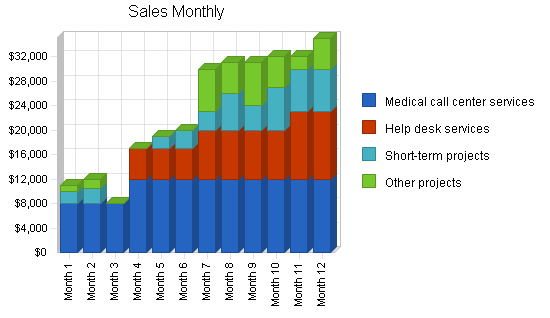
Management Summary management summary will include information about who's on your team and why they're the right people for the job, as well as your future hiring plans.">
The company will have four officers including our president, Mr. Martin Gibbs. Our head of operations will be Mr. Nicholas Caput, plus 12 customer service representatives. Finances and general admin will be handled by Ms. Stuart.
The company plans to hire additional service representatives, and administrative personnel as we begin to get large numbers of contracts.
6.1 Personnel
Vashon’s management brings to the company strong capabilities in contract negotiation, project management, telemarketing, and a unique combination of skills drawn from other businesses.
Key Personnel
Mr. Martin Gibbs is a graduate of the University of Missouri where he obtained his business degree degree in 1971. Since then, Mr. Gibbs has had extensive experience in marketing, telemarketing, and project management. This includes experience in budgeting, project oversight, etc. In 1996 he obtained a graduate degree in marketing from University of Washington. Mr. Gibbs spent the last four years as the telemarketing department head with Medfone, Inc.
Mr. Nicholas Caput graduated from Arizona State University with a bachelors degree in marketing in 1975. From 1978-1988 Mr. Caput worked for Nelson Marketing Consultants. In 1989 he went to work for Anderson Consulting in their marketing division, where he worked as a project manager.
Financial Plan investor-ready personnel plan .">
Our financial plan anticipates two years of negative profits as we gain sales volume. We have budgeted enough investment to cover these losses and have an additional credit line available if sales do not match predictions.
7.1 Important Assumptions
We are assuming approximately 75% sales on credit and average interest rates of 10%. These are considered to be conservative in case our predictions are erroneous.
7.2 Break-even Analysis
Our break-even analysis is based on the assumptions that our gross margin is approximately 100%. In other words, we will have insignificant direct cost of sales. Since each contract will be of different scope, length, and complexity, it is difficult to assign and average per unit revenue figure. However, it is conservatively believed that during the first three years, average profitability per month per segment will be moderate. This is because we will be dealing with smaller companies at first that have smaller contracts. We expect that about three ongoing contracts per month will guarantee a break-even point.

7.3 Projected Profit and Loss
The following table itemizes our revenues and associated costs. We expect to be paying higher costs in marketing and advertising than other companies as we attempt to build sales volume. As shown in the table in the Appendix, we expect monthly profits to begin in December 2003.

7.4 Projected Cash Flow
The following is our cash flow chart and diagram. We do not expect to have any short-term cash flow problems even though we will be operating at a loss for the first nine months. Our short-term loan will be repaid in two equal payments in 2004-2005. Our long-term loan will be paid off in ten years.

7.5 Projected Balance Sheet
The following table shows the projected balance sheet for VSS.
7.6 Business Ratios
We have included industry standard ratios from the telemarketing solicitation services industry to compare with ours. These ratios are as closely matched to our industry as management could find, however there are some significant differences, especially in sales growth, financing ratios, long-term asset investments and net worth. However, our projections indicate a healthy company that will be able to obtain and retain long-term profitability.

The quickest way to turn a business idea into a business plan
Fill-in-the-blanks and automatic financials make it easy.
No thanks, I prefer writing 40-page documents.

Discover the world’s #1 plan building software

Call Center Business Plan Template
Written by Dave Lavinsky

Call Center Business Plan
Over the past 20+ years, we have helped over 1,000 entrepreneurs and business owners create business plans to start and grow their call centers. On this page, we will first give you some background information with regards to the importance of business planning. We will then go through a call center business plan template step-by-step so you can create your plan today.
Download our Ultimate Business Plan Template here >
What Is a Business Plan?
A business plan provides a snapshot of your call center as it stands today, and lays out your growth plan for the next five years. It explains your business goals and your strategy for reaching them. It also includes market research to support your plans.
Why You Need a Business Plan
If you’re looking to start a call center, or grow your existing call center, you need a business plan. A business plan will help you raise funding, if needed, and plan out the growth of your call center in order to improve your chances of success. Your business plan is a living document that should be updated annually as your company grows and changes.
Sources of Funding for Call Centers
With regards to funding, the main sources of funding for a call center are personal savings, credit cards, bank loans and angel investors. With regards to bank loans, banks will want to review your plan and gain confidence that you will be able to repay your loan and interest. To acquire this confidence, the loan officer will not only want to confirm that your financials are reasonable, but they will also want to see a professional plan. Such a plan will give them the confidence that you can successfully and professionally operate a business. Personal savings and bank loans are the most common funding paths for call centers.
Finish Your Business Plan Today!
How to write a business plan for a call center agency.
If you want to start a call center or expand your current one, you need a business plan. Below we detail what should be included in each section of your own plan:
Executive Summary
Your executive summary provides an introduction to your business plan, but it is normally the last section you write because it provides a summary of each key section of your plan.
The goal of your Executive Summary is to quickly engage the reader. Explain to them the type of call center you are operating and the status. For example, are you a startup, do you have a call center that you would like to grow, or are you operating call centers in multiple markets?
Next, provide an overview of each of the subsequent sections of your plan. For example, give a brief overview of the telemarketing industry. Discuss the type of call center you are operating. Detail your direct competitors. Give an overview of your target customers. Provide a snapshot of your marketing plan. Identify the key members of your team. And offer an overview of your financial plan.
Company Overview
In your company overview, you will detail the type of call center you are operating.
For example, you might operate one of the following types of call centers:
- Inbound Call Center : this type of call center focuses on answering inbound phone calls usually from new and existing consumers.
- Outbound Call Center: this type of call center specializes in calling customers and consumers on a company’s behalf and are responsible for selling a product/service and expanding a company’s reach in their phone calls.
- Automated Call Centers: this type of call center has a computer-based system that is interactive and allows the callers to handle some of the responsibilities of directing their call.
In addition to explaining the type of call center you will operate, the Company Overview section of your business plan needs to provide background on the business.
Include answers to question such as:
- When and why did you start the business?
- What milestones have you achieved to date? Milestones could include the number of customers served, number of positive reviews, reaching X amount of clients served, etc.
- Your legal structure. Are you incorporated as an S-Corp? An LLC? A sole proprietorship? Explain your legal structure here.
Industry Analysis
In your industry analysis, you need to provide an overview of the telemarketing industry.
While this may seem unnecessary, it serves multiple purposes.
First, researching the industry educates you. It helps you understand the market in which you are operating.
Secondly, market research can improve your strategy, particularly if your research identifies market trends.
The third reason for market research is to prove to readers that you are an expert in your industry. By conducting this market research and presenting it in your plan, you achieve just that.
The following questions should be answered in the industry analysis section:
- How big is the industry (in dollars)?
- Is the market declining or increasing?
- Who are the key competitors in the market?
- Who are the key suppliers in the market?
- What trends are affecting the industry?
- What is the industry’s growth forecast over the next 5 – 10 years?
- What is the relevant market size? That is, how big is the potential market for your call center? You can extrapolate such a figure by assessing the size of the market in the entire country and then applying that figure to your local population.
Customer Analysis
The customer analysis section must detail the customers you serve and/or expect to serve.
The following are examples of customer segments: telemarketing companies, large organizations, charities, and help desks/customer support teams.
As you can imagine, the customer segment(s) you choose will have a great impact on the type of call center you operate. Clearly, charities would respond to different marketing promotions than help desks, for example.
Try to break out your target customers in terms of their demographic and psychographic profiles. With regards to demographics, include a discussion of the ages, genders, locations and income levels of the customers you seek to serve.
Psychographic profiles explain the wants and needs of your target customers. The more you can understand and define these needs, the better you will do in attracting and retaining your customers.
Finish Your Call Center Business Plan in 1 Day!
Don’t you wish there was a faster, easier way to finish your business plan?
With Growthink’s Ultimate Business Plan Template you can finish your plan in just 8 hours or less!
Competitive Analysis
Your competitive analysis should identify the indirect and direct competitors your business faces and then focus on the latter.
Direct competitors are other call centers.
Indirect competitors are other options that customers have to purchase from that aren’t direct competitors. This includes in-house customer support departments and online support websites. You need to mention such competition as well.
With regards to direct competition, you want to describe the other call centers with which you compete. Most likely, your direct competitors will be call centers located very close to your location.

For each such competitor, provide an overview of their businesses and document their strengths and weaknesses. Unless you once worked at your competitors’ businesses, it will be impossible to know everything about them. But you should be able to find out key things about them such as:
- What types of customers do they serve?
- What type of call center are they?
- What is their pricing (premium, low, etc.)?
- What are they good at?
- What are their weaknesses?
With regards to the last two questions, think about your answers from the customers’ perspective. And don’t be afraid to ask your competitors’ customers what they like most and least about them.
The final part of your competitive analysis section is to document your areas of competitive advantage. For example:
- Will you provide shorter call times and higher call volume?
- Will you provide call center services that your competitors don’t offer?
- Will you provide better customer service?
- Will you offer better pricing?
Think about ways you will outperform your competition and document them in this section of your plan.
Marketing Plan
Traditionally, a marketing plan includes the four P’s: Product, Price, Place, and Promotion. For a call center agency, your marketing plan should include the following:
Product : In the product section, you should reiterate the type of call center company that you documented in your Company Analysis. Then, detail the specific products you will be offering. For example, in addition to a call center, will you provide call forwarding, market research, lead generation, and any other services?
Price : Document the prices you will offer and how they compare to your competitors. Essentially in the product and price sub-sections of your marketing plan, you are presenting the call center services you offer and their prices.
Place : Place refers to the location of your call center company. Document your location and mention how the location will impact your success. For example, is your call center located in a busy retail district, a business district, a standalone office, etc. Discuss how your location might be the ideal location for your customers.
Promotions : The final part of your call center marketing plan is the promotions section. Here you will document how you will drive customers to your location(s). The following are some promotional methods you might consider:
- Advertising in local papers and magazines
- Reaching out to websites
- Social media marketing
- Local radio advertising
Operations Plan
While the earlier sections of your plan explained your goals, your operations plan describes how you will meet them. Your operations plan should have two distinct sections as follows.
Everyday short-term processes include all of the tasks involved in running your call center, including answering inbound calls, making outbound calls, finding solutions to customers’ issues, track statistics of your call length and volume, and expand the reach of your client.
Long-term goals are the milestones you hope to achieve. These could include the dates when you expect to land your Xth client, or when you hope to reach $X in revenue. It could also be when you expect to expand your call center to a new city.
Management Team
To demonstrate your call center’ ability to succeed, a strong management team is essential. Highlight your key players’ backgrounds, emphasizing those skills and experiences that prove their ability to grow a company.
Ideally you and/or your team members have direct experience in managing call centers. If so, highlight this experience and expertise. But also highlight any experience that you think will help your business succeed.
If your team is lacking, consider assembling an advisory board. An advisory board would include 2 to 8 individuals who would act like mentors to your business. They would help answer questions and provide strategic guidance. If needed, look for advisory board members with experience in managing a call center or successfully running a sales or customer support team .
Financial Plan
Your financial plan should include your 5-year financial statement broken out both monthly or quarterly for the first year and then annually. Your financial statements include your income statement, balance sheet and cash flow statements.
Income Statement : an income statement is more commonly called a Profit and Loss statement or P&L. It shows your revenues and then subtracts your costs to show whether you turned a profit or not.

In developing your income statement, you need to devise assumptions. For example, will you take on one new client at a time or multiple new clients ? And will sales grow by 2% or 10% per year? As you can imagine, your choice of assumptions will greatly impact the financial forecasts for your business. As much as possible, conduct research to try to root your assumptions in reality.
Balance Sheets : Balance sheets show your assets and liabilities. While balance sheets can include much information, try to simplify them to the key items you need to know about. For instance, if you spend $50,000 on building out your call center, this will not give you immediate profits. Rather it is an asset that will hopefully help you generate profits for years to come. Likewise, if a bank writes you a check for $50,000, you don’t need to pay it back immediately. Rather, that is a liability you will pay back over time.
Cash Flow Statement : Your cash flow statement will help determine how much money you need to start or grow your business, and make sure you never run out of money. What most entrepreneurs and business owners don’t realize is that you can turn a profit but run out of money and go bankrupt.
In developing your Income Statement and Balance Sheets be sure to include several of the key costs needed in starting or growing a call center:
- Cost of computer software.
- Cost of equipment and supplies
- Payroll or salaries paid to staff
- Business insurance
- Taxes and permits
- Legal expenses

Attach your full financial projections in the appendix of your plan along with any supporting documents that make your plan more compelling. For example, you might include your office location lease or invoices of client projects you are working on.
Putting together a business plan for your call center is a worthwhile endeavor. If you follow the template above, by the time you are done, you will truly be an expert. You will really understand the call center industry, your competition, and your customers. You will have developed a marketing plan and will really understand what it takes to launch and grow a successful call center.
Call Center Agency Business Plan FAQs
What is the easiest way to complete my call center business plan.
Growthink's Ultimate Business Plan Template allows you to quickly and easily complete your business plan.
How Do You Start a Call Center?
Starting a call center is easy with these 14 steps:
- Choose the Name for Your Call Center Agency
- Create Your Call Center Business Plan
- Choose the Legal Structure for Your Call Center Agency
- Secure Startup Funding for Your Call Center (If Needed)
- Secure a Location for Your Business
- Register Your Call Center Agency with the IRS
- Open a Business Bank Account
- Get a Business Credit Card
- Get the Required Business Licenses and Permits
- Get Business Insurance for Your Call Center
- Buy or Lease the Right Call Center Equipment
- Develop Your Call Center Agency Marketing Materials
- Purchase and Setup the Software Needed to Run Your Call Center
- Open for Business
Learn more about how to start your own call center agency .
Don’t you wish there was a faster, easier way to finish your Call Center business plan?
OR, Let Us Develop Your Plan For You
Since 1999, Growthink has developed business plans for thousands of companies who have gone on to achieve tremendous success.
Click here to see how Growthink’s professional business plan consulting services can create your business plan for you.
Other Helpful Business Plan Articles & Templates

Call Center Business Plan Template
Written by Dave Lavinsky
Call Center Business Plan
You’ve come to the right place to create your Call Center business plan.
We have helped over 1,000 entrepreneurs and business owners create business plans and many have used them to start or grow their Call Center businesses.
Below is a template to help you create each section of your Call Center business plan.
Executive Summary
Business overview.
TalkCentral is a new inbound call center located in San Antonio, Texas. Our call center will provide customer service and help desk support for customers of tech, software, and telecommunications companies. We can provide customers support through phone call or text and will always help customers with the utmost patience, compassion, and respect. Clients who work with us will experience a significant improvement in customer satisfaction and retention.
TalkCentral is founded by Dave Harper. Dave was previously a senior manager at one of the leading telecommunications companies in the country. However, his company had a horrible reputation for untimely and unhelpful customer service. Therefore, he was inspired to create a call center that would improve the support experience for customers of similar companies.
Product Offering
TalkCentral will provide customer support for the customers of our clients. Since we will work with clients in the tech, software, and telecommunications industries, we will primarily help their customers with billing services, questions regarding products and services, and technical issues. Customers can call or text our service lines for support. They will quickly be matched with an appropriate agent by answering the prompts from our automated system.
Customer Focus
TalkCentral will primarily serve tech, software, and telecommunications companies that are in need of a good customer support team. Though TalkCentral is located in San Antonio, we will assist any companies in these industries that are located in the United States.
Management Team
TalkCentral is founded by Dave Harper. Dave was previously a senior manager at one of the leading telecommunications companies in the country. Unfortunately, his company had a horrible reputation for untimely and unhelpful customer service. He found that the customer service team was inadequately trained and had a high turnover rate. This led to low customer satisfaction and retention scores. Since the company was slow to resolve these issues, Dave was inspired to create an inbound call center that would help provide quality customer support to similar companies.
Success Factors
TalkCentral is primed for success by offering the following competitive advantages:
- TalkCentral will provide quality customer service for a more affordable price than clients would pay hiring their own customer service team.
- The company will offer high-quality customer service that increases customer retention.
- TalkCentral has a management team with extensive experience running a multi-billion dollar telecommunications company.
Financial Highlights
TalkCentral is currently seeking $700,000 to launch. The funding will be dedicated to the office build out, equipment and supplies, overhead, marketing expenses, and working capital. The breakout of the funding is below:
- Office design/build: $250,000
- Equipment, technology, and supplies: $100,000
- Three months of overhead (rent, utilities, salaries): $200,000
- Marketing expenses: $100,000
- Working capital: $50,000
The following graph below outlines the pro forma financial projections for TalkCentral.
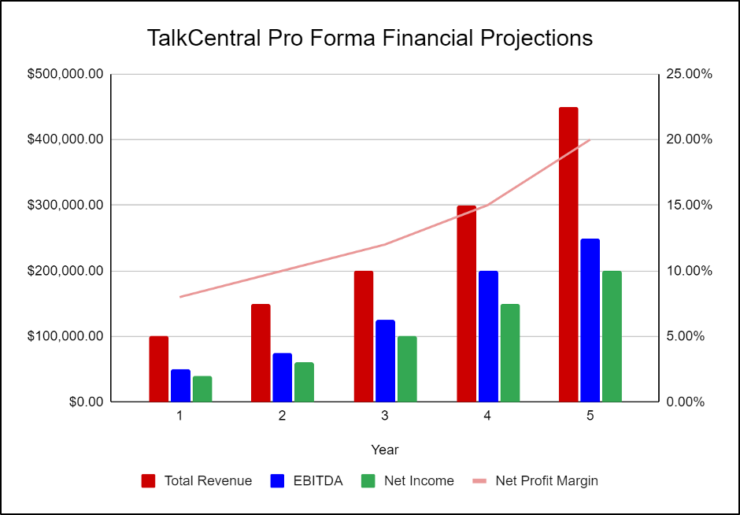
Company Overview
Who is talkcentral.
When our clients’ customers call our number, their call will be answered quickly and efficiently. Customers can call in for questions regarding billing, services, or products as well as get answers and help to technical problems they are experiencing. We will have an easy phone system that will guide them to the perfect agent who can help them.
While working as a senior manager, Dave was inspired to create a call center that would provide quality customer support for tech, software, and telecommunications companies. He conducted a market analysis and surveyed his previous employer’s customers to see if there was demand for these services. The results from the analysis and survey were overwhelmingly positive, which inspired Dave to immediately start planning his new business.
TalkCentral’s History
After conducting his market analysis and survey, Dave Harper incorporated TalkCentral as an S-Corporation on May 1st, 2023. Since incorporation, Dave has achieved the following milestones for TalkCentral:
- Developed the company’s name, logo and website
- Finished the list of services the company will provide
- Determined equipment and inventory requirements
- Found a potential office location
TalkCentral’s Services
TalkCentral will primarily offer customer service and help desk support for customers of tech, software, and telecommunications companies. Customers can either call or text our support lines and will be guided to an appropriate agent to help them with their problem. We expect most customers will call to discuss billing or technical problems they are experiencing.
Industry Analysis
Revenue for the inbound call centers is expected to grow over the next five years. This growth is due to the increasing demand for quality customer support teams and the need to outsource these services. Poor customer support results in low customer retention. However, hiring and training a quality customer support team is expensive so many companies outsource these services to call centers to save money. Therefore, there is significant demand for these services and that demand is not expected to slow down anytime soon.
According to Research And Markets, the global call center outsourcing market was valued at $249 billion in 2021 and is expected to grow at a compound annual growth rate of 8.93% until 2027. This is significant growth for any industry and shows just how much companies will continue to depend on these services. Therefore, this is a great time to launch a new inbound call center as we are sure to be successful and profitable.
Customer Analysis
Demographic profile of target market, customer segmentation.
TalkCentral will primarily target the following customer profiles:
- Tech companies
- Software companies
- Telecommunications companies
Competitive Analysis
Direct and indirect competitors.
TalkCentral will face competition from other companies with similar business profiles. A description of each competitor company is below.
Fusion Support Services
Fusion Support Services has been a popular business process outsourcing company in San Antonio for 20 years. They offer numerous services for local companies, including inbound customer service, human resources, and marketing. Since they can offer a whole package of services, they have created several long-lasting relationships with medium and large sized businesses in the area. However, Fusion Support Services does not specialize in inbound customer support. Therefore, companies looking for professionals in this field will prefer our services.
Texas Tech Support
Texas Tech Support is an inbound call center that specifically helps tech companies with customer service and tech support services. Tech companies are usually more invested in the development of their products than providing customer support, so they need a partner company that can provide these services to their customers. Texas Tech provides a fully trained staff of professionals that can help customers with basic questions regarding billing, products, or technical difficulties. Every call is answered with compassion, patience, and incredible expertise that helps improve customer satisfaction and retention.
Genesis Support Services
Genesis Support Services is a highly fast-paced call center environment located in the heart of San Antonio. They offer a wide variety of outsourced inbound call center services and cater to numerous industries and businesses located in the San Antonio area. They have been in the business for 30 years and are often the first call center businesses think of when they need customer service support. However, their reputation has suffered in recent years, which gives TalkCentral an advantage as we enter the market.
Competitive Advantage
TalkCentral will be able to offer the following advantages over the competition:
- Management : Our management team has extensive experience leading and managing telecommunications companies and providing customer support services.
- Affordability : We will provide quality services at a more affordable rate than the competition.
- Quality Service : TalkCentral is committed to providing quality customer service and support. We guarantee our services will help improve customer satisfaction and retention.
Marketing Plan
Brand & value proposition.
TalkCentral will offer the unique value proposition to its clientele:
- High-quality customer support and help desk services
- Affordable rate
- Highly trained staff
- Guarantee of improved customer retention
Promotions Strategy
The promotions strategy for TalkCentral is as follows:
Website/SEO Marketing
TalkCentral will design an efficient and appealing website to attract clients. The website will be well organized, informative, and list the services that we provide. We will also invest in SEO so that we will appear at the top of search engine results when clients are searching for call centers to partner with.
Social Media
The company will have several social media accounts and invest in ads on all social media platforms. The company will also use targeted marketing to appeal to our target demographics.
Targeted Cold Calls
TalkCentral will initially invest significant time and energy into contacting potential clients via telephone. In order to improve the effectiveness of this phase of the marketing strategy, a highly-focused call list will be used, targeting startups and small businesses. As this is a very time-consuming process, it will primarily be used during the startup phase to build an initial client base.
Advertisement
Advertisements in print publications like newspapers, magazines, etc., are an excellent way for businesses to connect with their audience. TalkCentral will advertise its services in popular magazines and news dailies. Obtaining relevant placements in industry magazines and journals will also help in increasing brand visibility.
The pricing of TalkCentral will be moderate and on par with competitors so clients feel they receive value when hiring our services.
Operations Plan
TalkCentral will utilize the following operations plan. Operation Functions:
- Dave Harper will be the President of TalkCentral and will oversee the general operations of the company. To launch, he will need to hire the following staff:
- An Administrative Assistant to help with administrative functions.
- An Accountant who will manage all client invoicing, billing, and payables.
- A Human Resources Manager who will oversee all employee hiring, onboarding, payroll, retention, and benefits programs.
- A Marketing Manager to oversee all the marketing and promotional campaigns.
- Training Managers who will train the customer support staff.
- 50 customer support staff to provide our customer support and help desk services.
Milestones:
TalkCentral will have the following milestones complete in the next six months:
- 6/1/202X – Finalize lease agreement for office space
- 7/1/202X – Office build out
- 8/1/202X – Hire and train essential staff
- 9/1/202X – Begin marketing campaign
- 10/1/202X – Launch TalkCentral
- 11/1/202X – Reach break even
As a former senior manager, Dave has extensive experience in the management and operations aspects of running a large, successful business. He will hire several staff to help him manage the administrative, marketing, accounting, and customer service functions of the company.
Financial Plan
Key revenue & costs.
The key revenues for TalkCentral will come from charging our clients for our services.
The major cost drivers will include salaries, overhead, equipment purchasing and maintenance, and marketing expenses.
Funding Requirements and Use of Funds
Key assumptions.
The following outlines the key assumptions required in order to achieve the revenue and cost numbers in the financials and pay off the startup business loan.
- Number of clients:
- Annual lease: $100,000
Financial Projections
Income statement, balance sheet, cash flow statement, call center business plan faqs, what is a call center business plan.
A call center business plan is a plan to start and/or grow your call center business. Among other things, it outlines your business concept, identifies your target customers, presents your marketing plan and details your financial projections.
You can easily complete your Call Center business plan using our Call Center Business Plan Template here .
What are the Main Types of Call Center Businesses?
There are a number of different kinds of call center businesses , some examples include: Inbound Call Center, Outbound Call Center, and Automated Call Centers.
How Do You Get Funding for Your Call Center Business Plan?
Call Center businesses are often funded through small business loans. Personal savings, credit card financing and angel investors are also popular forms of funding.
What are the Steps To Start a Call Center Business?
Starting a call center business can be an exciting endeavor. Having a clear roadmap of the steps to start a business will help you stay focused on your goals and get started faster.
1. Develop A Call Center Business Plan - The first step in starting a business is to create a detailed call center business plan that outlines all aspects of the venture. This should include potential market size and target customers, the services or products you will offer, pricing strategies and a detailed financial forecast.
2. Choose Your Legal Structure - It's important to select an appropriate legal entity for your call center business. This could be a limited liability company (LLC), corporation, partnership, or sole proprietorship. Each type has its own benefits and drawbacks so it’s important to do research and choose wisely so that your call center business is in compliance with local laws.
3. Register Your Call Center Business - Once you have chosen a legal structure, the next step is to register your call center business with the government or state where you’re operating from. This includes obtaining licenses and permits as required by federal, state, and local laws.
4. Identify Financing Options - It’s likely that you’ll need some capital to start your call center business, so take some time to identify what financing options are available such as bank loans, investor funding, grants, or crowdfunding platforms.
5. Choose a Location - Whether you plan on operating out of a physical location or not, you should always have an idea of where you’ll be based should it become necessary in the future as well as what kind of space would be suitable for your operations.
6. Hire Employees - There are several ways to find qualified employees including job boards like LinkedIn or Indeed as well as hiring agencies if needed – depending on what type of employees you need it might also be more effective to reach out directly through networking events.
7. Acquire Necessary Call Center Equipment & Supplies - In order to start your call center business, you'll need to purchase all of the necessary equipment and supplies to run a successful operation.
8. Market & Promote Your Business - Once you have all the necessary pieces in place, it’s time to start promoting and marketing your call center business. This includes creating a website, utilizing social media platforms like Facebook or Twitter, and having an effective Search Engine Optimization (SEO) strategy. You should also consider traditional marketing techniques such as radio or print advertising.
Learn more about how to start a successful call center business:
- How to Start a Call Center
Upmetrics AI Assistant: Simplifying Business Planning through AI-Powered Insights. Learn How
Entrepreneurs & Small Business
Accelerators & Incubators
Business Consultants & Advisors
Educators & Business Schools
Students & Scholars
AI Business Plan Generator
Financial Forecasting
AI Assistance
Ai pitch deck generator
Strategic Planning
See How Upmetrics Works →
- Sample Plans
- WHY UPMETRICS?
Customers Success Stories
Business Plan Course
Small Business Tools
Strategic Canvas Templates
E-books, Guides & More
- Sample Business Plans
- IT, Staffing & Customer Service
Call Center Business Plan

After getting started with Upmetrics , you can copy this sample business plan into your business plan and modify the required information and download your call center business plan pdf and doc file. It’s the fastest and easiest way to start writing your business plan.
Download a sample call center business plan
Need help writing your business plan from scratch? Here you go; download our free call center business plan pdf to start.
It’s a modern business plan template specifically designed for your call center business. Use the example business plan as a guide for writing your own.
Related Posts
IT consulting business plan
HR Consultancy Business Plan
Key Element of Business Plan Presentation
Best Market Research Tools
About the Author
Upmetrics Team
Upmetrics is the #1 business planning software that helps entrepreneurs and business owners create investment-ready business plans using AI. We regularly share business planning insights on our blog. Check out the Upmetrics blog for such interesting reads. Read more
Plan your business in the shortest time possible
No Risk – Cancel at Any Time – 15 Day Money Back Guarantee
Popular Templates

Create a great Business Plan with great price.
- 400+ Business plan templates & examples
- AI Assistance & step by step guidance
- 4.8 Star rating on Trustpilot
Streamline your business planning process with Upmetrics .

How to Write a Call Centre Business Plan

We investigate what should be included in a call centre plan and highlight some of the key fundamentals.
What Is the Aim of a Call Centre Business Plan?
A call centre business plan is a high-level document that is the first stage of setting up a call centre. It describes the purpose of the call centre and outlines the objectives, benefits and costs together with an indication of some of the components.
If you are bidding to create a contact centre within your own organization – whether that’s for service, sales or both – your call center business model will be aimed at internal stakeholders.
However, if you’re looking to create a new outsourced contact centre, your business plan may instead be aimed at investors, who you will need to help fund your operation – through the early days at least!
“In the plan, you will set out a number of options – around things like location, recruiters and technology suppliers. You are looking for approval to dig deeper into these options,” adds Martin Jukes, Managing Director at Mpathy Plus.
A Business Plan Will Cover a Number of Areas, Including:
- Customer Experience
- People and Technology
- Return on Investment (ROI)
Risk Assessment
It is important to keep in mind that your business plan will have three main audiences:
- Those stakeholders or potential sponsors (as already discussed)
- Those already tasked with building
- Those tasked with justifying
Start Your Plan With a Purpose – Set Around Key Objectives
Start off your business proposal by highlighting the purpose and objectives of the call centre.
Highlight your key arguments, using simple language, which will capture the attention of your investors early. Bullet points that set out your thoughts in a logical manner may be all that you need here.
The key is to make straightforward statements like:
“We’re spending £2 million every year in serving customers, in a disparate manner, across the organization. If we spend £1 million setting this up and £1 million a year on resourcing the call centre, then we’re going to get a return on investment fairly quickly, while providing a better customer experience.”
You are setting up the rest of the business plan, which will highlight how you plan to deliver a call centre to meet your objectives.
You then expand upon these arguments later, as you are setting up the rest of the business plan, which will highlight how you plan to deliver a call centre to meet your objectives.
Some other simple objectives that you might want to build a business plan for a call centre around – for a service operation – could be:
Possible Objectives for a Call Centre Business Plan:
- Furthering Revenue
- Improving Customer Experience
- Generating Campaigns
- Increasing Technical Support for New Products
- Enabling Growth
These are some quick examples, which could be expanded into solid objectives. However, these could be quite different from those used in a sales or outsourced contact centre.
What Else Needs to Be Included in a Contact Centre Business Plan?
While you may wish to add other elements into your business plan, here are some of the absolute must-haves, which need their own sections within your proposal.
How will a new contact centre benefit your organization? List all of the benefits in this section to underline the value of your new call centre.
In this section, start by reiterating your “headline” objectives, but also talk about some of the other benefits that call centre could bring – which may also help to swing your stakeholders.
Some of the benefits that are easy to overlook when creating a business plan include:
- Call analysis and more data that will tell you more about your customers
- Continuous improvement of customer service (with the right team)
- Extended service hours
- Improvement of your organization’s image
- Saving time of others in the business, who currently take calls as part of their job
Before you get into agent recruitment, locations and technology considerations you need to specify who will oversee the implementation of the contact centre, provide advice and troubleshoot. Who will be in the project’s steering group?
Plans are often built in project mode – i.e. to get to a defined result in a defined time at a defined budget.
It’s the wrong mindset.
Once you’ve come up with your key objectives, you need to start with “who?”, according to Peter Massey, Managing Director at Budd.
The people you are building for need to be involved right along.
“You need to be clear how it will run, not how it will get built. So how do you get customers’ and operations’ needs to drive scope and acceptability of your plan? The people you are building for need to be involved right along,” says Peter.
“So many new call centre plans don’t survive their first owner – the person who comes in to run a business in it. That disconnect is a real risk.”
This is especially true in fast-growing businesses where the team is being recruited right the way through.
Customer Experience Considerations
An important consideration when planning for a new contact centre is: what will our service look like from a customer’s perspective?
If one of your objectives is to increase revenue through great service, this is particularly important, as you need to highlight the actions that you want to take which will enable you to achieve that.
The idea here is to create a vision of the customer experience that the call centre will deliver. This vision will help to stitch together your technology, location and recruitment options that you present to your stakeholders later in the business plan.

Create a vision of the customer experience that the call centre will deliver.
You may also want to consider: why do customers contact us? Do you plan to automate, simplify or even eliminate some of those contacts in the call centre? If so, how will that impact customer experience for the better?
In this section of your call centre business plan, another important consideration is: how will we measure success?
If your key objective is to save money, revenue statistics may be all you need. However, if you’re looking to further revenue via improved service and sales, you might need to introduce and explain how you will use measures like:
- Customer Effort
- Customer Emotion
- First Contact Resolution
- Customer Satisfaction
- Net Promoter Score
- Sales Volumes
The metrics that you track, and how you do so, should align with your vision for customer experience.
Location – Along With Branding and Furnishing
If you are looking to run a traditional brick-and-mortar call centre, you will likely present three or four different options for location and note that they will cost x, y and z.
The options that you put forward will depend on things like the availability of suitable resource. Do you want to go near competing organizations where you can potentially poach good staff? Or do you want to stay away from organizations that may want to poach members of your team?
Other factors in your decision may include grant availability, cost of accommodation, office space and, of course, availability.
Factors in your decision may include grant availability, cost of accommodation, office space and, of course, availability.
There is also the matter of the location fitting your brand, and branding in itself is a key thought to have, according to Martin.
“Your contact centre is a representation of your brand, and for many customers it is what they see and experience more than anything else. So you need your call centre to demonstrate what you are about as an organization,” says Martin.
With this in mind, when you are looking at possible locations, you will need to look for costs to furnish, brand and maintain the place, so it not only reflects your company, but also becomes a nice place to work.
A Quick Point on Remote Working
If you are wanting to put together a remote contact centre, furnishing, branding etc. will be less of a consideration – but there will be other costs that you need to consider, such as:
- Liability /employee
- IT and internet
- Workstations
On top of that, with remote working you will have to think more about setting the right working practices and maintaining kit, as well as any safety and security matters that need to be addressed.
These considerations will also apply to hybrid contact centre models, which most contact centres are set to turn into in the post-COVID world.
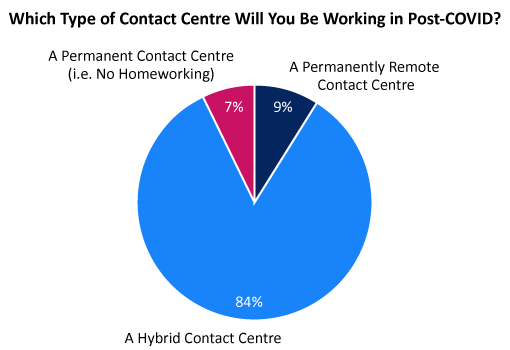
This poll is made up of data sourced in the Call Centre Helper Webinar: Contact Centre of the Future
The decision on whether you plan for an office-based, hybrid or fully remote contact centre can be a tricky one, but it’s good to think about who you plan to recruit – remembering that:
Office-based working tends to suit:
- Young, sociable workers
- People new to the company and in need of training
- High-paced telesales contact centres
- Environments where team work is important
Home-based working tends to suit:
- Older workers with home responsibilities
- Disabled workers
- Contact centres looking for specialist talent (because of wider talent pool)
- Areas in which contact volumes fluctuate
People and Technology Resources
In terms of resources, there are lots of things to consider. Firstly, forecast your demand and how that will change over time. This will enable you to calculate how many agents you need .
Then, you need to think about the internal structure of your call centre. This will include asking yourself questions such as:
- How many team leaders do we need per x number of agents?
- Who will be in charge of Quality Assurance and coaching?
- Who will be in charge of Resource Planning?
- Who will be in charge of HR for the new team?
Only by asking yourself questions like these and quantifying the duties in each role will you be able to come up with a staffing requirement.
From this, you will put forward suggestions for staff salaries and be able to calculate your potential people costs.
Then focus on your technology . You can opt for cloud-based solutions or on-premise technology.
The plus with cloud is that there are pay-as-you go types of models, which make it much easier to set up a new call centre, while technology integration is also much easier.
Once you have made this decision, it’s time to consider which vendor you’d like to work with. To do this, it’s good to consider which technologies you would like to invest in.
Consider how you might want to simplify, automate or eliminate some of your most common contact reasons…
While there may be some must-haves – like a CRM and an IVR/Call Routing – go back to your top contact reasons and consider how you might want to simplify, automate or eliminate some of your most common contact reasons and consider what technology will help you do that.
A good tool for helping do this is the Value-Irritant Grid. You can find out more about this in our article: A Simple Technique to Improve Your Contact Centre Strategy
For those contact reasons to which none of those options apply, look at the technologies that can support agents in answering those queries effectively – i.e. knowledge bases, visual scripting, etc.
Approach technology vendors with your proposal for technologies and then present options to your stakeholders in your business plan.
For more on putting together a technology plan for your contact centre, read our article: How to Set Up a Call Centre From Scratch – The Checklist
Quick Tip – Make Sure You Put Psychology Before Technology
It’s easy to start totting up the cost of systems and technology required in a contact centre. But not every project team looks at the cost of constantly optimizing the experience of staff and customers in and beyond the contact centre.
If your website and apps drive contacts, it’s not enough to optimize your contact centre. If your marketing and sales propositions drive expectations, it’s not enough to do well in handling contacts, as Peter Massey tells us.
You need a model which fits your company’s values and your customers’ expectations.
“You need to look at the psychology of a contact centre, not just the technology. You need a model which fits your company’s values and your customers’ expectations. That takes thinking time, collaboration from other functions, deep user design and continual optimization,” adds Peter.
Return on Investment
When you put together a set of options for things like location, technology and people, you become much more aware of the costs of your potential operation.
So, this section should include a summary of where the costs lie, in comparison to projections for how much money you are going to save and/or how providing better service will generate further income.
With all of the profit and cost figures, you should be able to calculate when your stakeholders or investors will start to see a return on investment (ROI).

Martin Jukes
When embarking on a project as ambitious as setting up a new call centre, there are a lot of risks that you need to mitigate for.
“Understanding scale is critical and one risk that I would expect to be included in a call centre business plan is sizing, whether that’s over- or under-sizing – which may be due to the volatility of forecasts,” adds Martin..
Another risk may include your technology not working – or that it does not deliver what you were hoping it would deliver – either from a timescale or functionality perspective.
A further example of a risk that you may need to provide some contingency measures for is recruitment problems, in case you fail to hire the required calibre of people in the area in which you are targeting. These are the sorts of risks to plan for, and there may well be others.
Mistakes to Avoid With Your Plan
There are many potential pitfalls that you can slip into when creating a call centre business plan. The two most common – as identified by Martin Jukes – are as follows.
1. Failing to Structure the Business Plan Around the Customer
By positioning your call centre as your organization’s “hub for customer experience”, not only are you highlighting its strategic value, but you can also ensure that it is not going to be viewed – from now and in the future – as a “cost centre”.
When your call centre is viewed as a cost centre, you will find it very difficult to put together a business case in the future for new technologies, staff and other customer innovations.
If you also create your business plan around a vision for how you will serve your customers, you will naturally align your choices – in terms of location, recruitment, technology etc.
2. Putting Technology Ahead of Customer Experience and Psychology
Technology is your enabler, once you’ve decided what it is that you’re trying to do.
For example, if you are looking to set up an outbound sales call centre, you would use technology differently from if you were planning for an inbound support centre.
You need to understand what you need from your technology, before setting up your system.
A lot of people buy a contact centre platform and then work out how to do it. But that approach is wrong. You need to understand what you need from your technology, before setting up your system.
As Peter says: “What goes into a call centre business plan is as much psychology as technology.”
Other Mistakes…
While these two are common mistakes, there are lots more in terms of the implementation of the call centre, in terms of:
- Getting the right people
- Putting training together and getting the right support material in place
- Branding and aligning people behind a company culture
Getting this right depends on lots of market research and, of course, having a vision for how you plan to service customers. This will help you to secure the necessary funds.
8 Key Questions You Need to Answer in Your Business Plan
While we’ve covered the fundamental components of a call centre business plan, there are many questions that you’ll need to answer as you put together your proposal.
Here are some important examples that Peter Massey put forward:

Peter Massey
- What shall I focus the budget into to make the biggest impact / best operation?
- What does it cost to build a contact centre?
- How much should we justify investing for best impact?
- What should the project team look like?
- How do we make sure the operational team get handed over what they need?
- How do we get the right subject-matter experts involved?
- How do we avoid scope creep or scope reduction whilst hitting a deadline?
- If we’re building afresh, how do we make sure we don’t just build a shinier version of what we did before?
Get Some External Advice
While this is no doubt a long and thorough guide to creating a call centre business plan, it is a big task and one that most organizations do once in a blue moon.
With this in mind, it is good to get in contact with experts like Martin and Peter, who have worked alongside many organizations in putting together a call centre business plan.
They know all the potential pitfalls and issues that you are likely to come across, as well as other key trends regarding what’s going on in the industry – so engaging with a third party is a key final tip.
If you would like to reach out to Martin or Peter, you can check out their websites here:
- Martin Jukes: mpathyplus.co.uk
- Peter Massey: budd.uk.com
For more advice on setting up a contact centre, read our articles:
- How to Set up a Call Centre
- What Is a Call Centre? – 10 Things to Know
- 23 Considerations to Make Before Implementing a New Digital Channel
Published On: 4th Jan 2021 - Last modified: 9th Nov 2023 Read more about - Customer Service Strategy , Martin Jukes , Peter Massey , Setup
Recommended Articles


Researched by Consultants from Top-Tier Management Companies

Powerpoint Templates
Icon Bundle
Kpi Dashboard
Professional
Business Plans
Swot Analysis
Gantt Chart
Business Proposal
- Marketing Plan
Project Management
Business Case
Business Model
Cyber Security
Business PPT
Digital Marketing
Digital Transformation
Human Resources
Product Management
Artificial Intelligence
Company Profile
Acknowledgement PPT
PPT Presentation
Reports Brochures
One Page Pitch
Interview PPT
All Categories
Top 10 Call Center Business Plan Templates with Examples and Samples (Editable Word Doc, Excel and PDF Included)
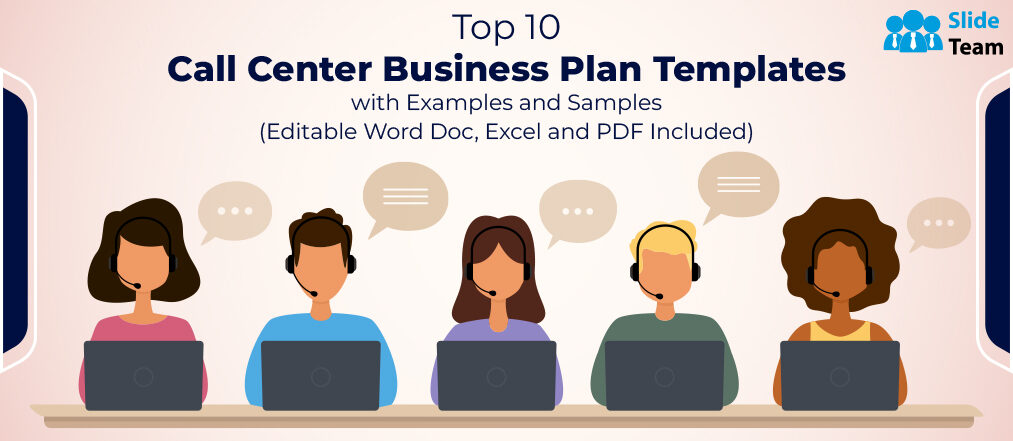
Samradni Pradhan
In the current business environment, effective communication is essential for success. Call centers are a key component of this and are often called the "heartbeat" of customer service. They are the first point of contact between businesses and customers, providing a seamless experience with efficiency, compassion, and responsiveness. Not only do call centers address customer queries and concerns, but they also have a significant impact on customer loyalty and satisfaction. Consequently, they have become an essential industry asset, guaranteeing that every customer interaction is positive and memorable.
But the path to a successful call center operation doesn’t come naturally. It requires careful planning, clear goals, and a clear plan to navigate the ever-changing business environment. That’s where a well-thought-out business plan comes in. A business plan is a strategic roadmap that outlines your call center’s vision, purpose, and objectives. It provides a systematic approach to allocating resources, training employees, integrating technology, and measuring performance. In short, a well-executed business plan is a roadmap that turns your call center into a success and keeps it at the forefront of excellence in today’s competitive market.
The best call center business plan templates will be the main topic of this article for you and your company.
Best Call center Business Plan Templates
Table Of Contents
- Executive Summary
- Company Overview
- Industry Analysis
- Customer Analysis
- Competitor Analysis
- SWOT Analysis
- PORTER’s Framework
- Operational Plan
- Financial Plan
These templates have been specifically designed for a call center business plan. This blog will cover the top 10 pages in the complete deck. After downloading, you will get the 52-page Doc, PDF, and XLS files.
1. Executive Summary
The Executive Summary is the cornerstone of your call center business plan. It encapsulates the essence of your plan in a concise manner. This section is crucial for attracting investors as it provides a snapshot of your business's potential for success. It highlights key information, such as your unique value proposition, market opportunity, and financial projections. A compelling Executive Summary can pique investors' interest and encourage them to delve deeper into your plan.
In our Executive Summary section, you will get templates for
1.1 The Quick Pitch: Make a great first impression on potential investors and partners by delivering a compelling and concise introduction highlighting your company's unique features and value propositions.
1.2 The Entity: Visualize your business architecture and unique brand in a way that will attract investors and partners to uncover the real story behind your business.
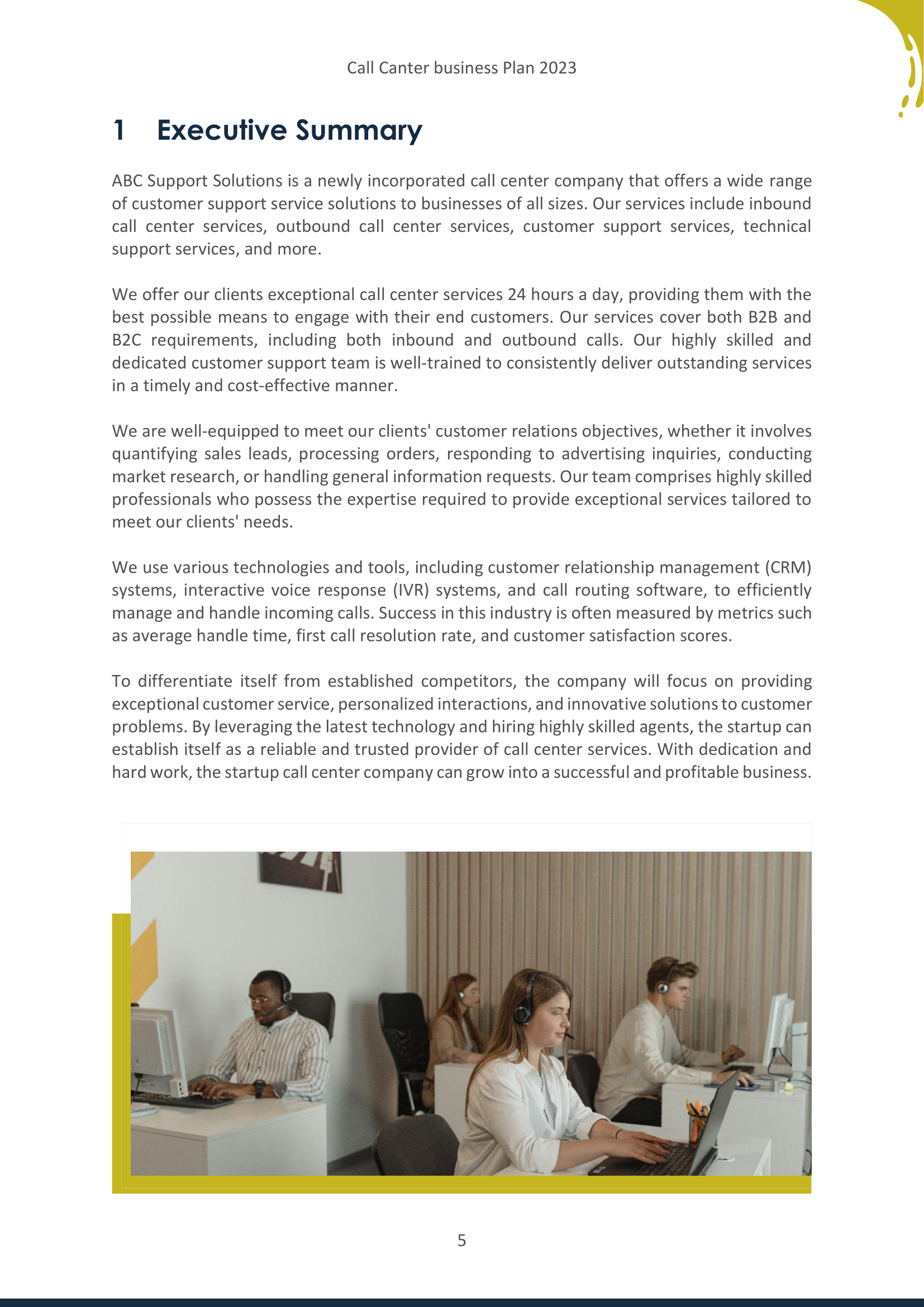
Download this business plan
Looking for an Inbound Call Center Business Plan Template in an editable PowerPoint Format? Click here to explore it.

Download this presentation
2. Company Overview
This section is intended to provide a foundation for investors to understand the organization. By conveying a clear vision of the company's purpose, atmosphere, and objectives, potential investors may be more likely to invest in the company. It is an opportunity for the company to demonstrate its commitment and enthusiasm, which may be a decisive factor in attracting investors who share the same values and vision as the company.
In our Company Overview section, you will get templates for
2.1 Vision and Mission: Make a mission statement and a vision that will guide your call center business into the future.
2.2 Company Goals and Objectives: Consider what you want from your inbound call center business and develop a plan that inspires and sets you up for success.
2.3 Start-up Expenses: Provides an overview of the financial resources required for critical operations, including the establishment of infrastructure, the acquisition of equipment, the recruitment of personnel, the acquisition of licenses or authorizations, and any other initial costs.
2.4 Market Gap and Solution: Unlock the potential of the call center industry and show off your unique business brand, making your brand stand out from the crowd.
2.5 Services Offered: Explore a vast array of premium inbound call center services. Demonstrate your full range of creative and design talents.
2.6 Key Success Factors: Dig into the fundamentals that define your BPO call center business plan, setting you up for success in terms of design and aesthetics.
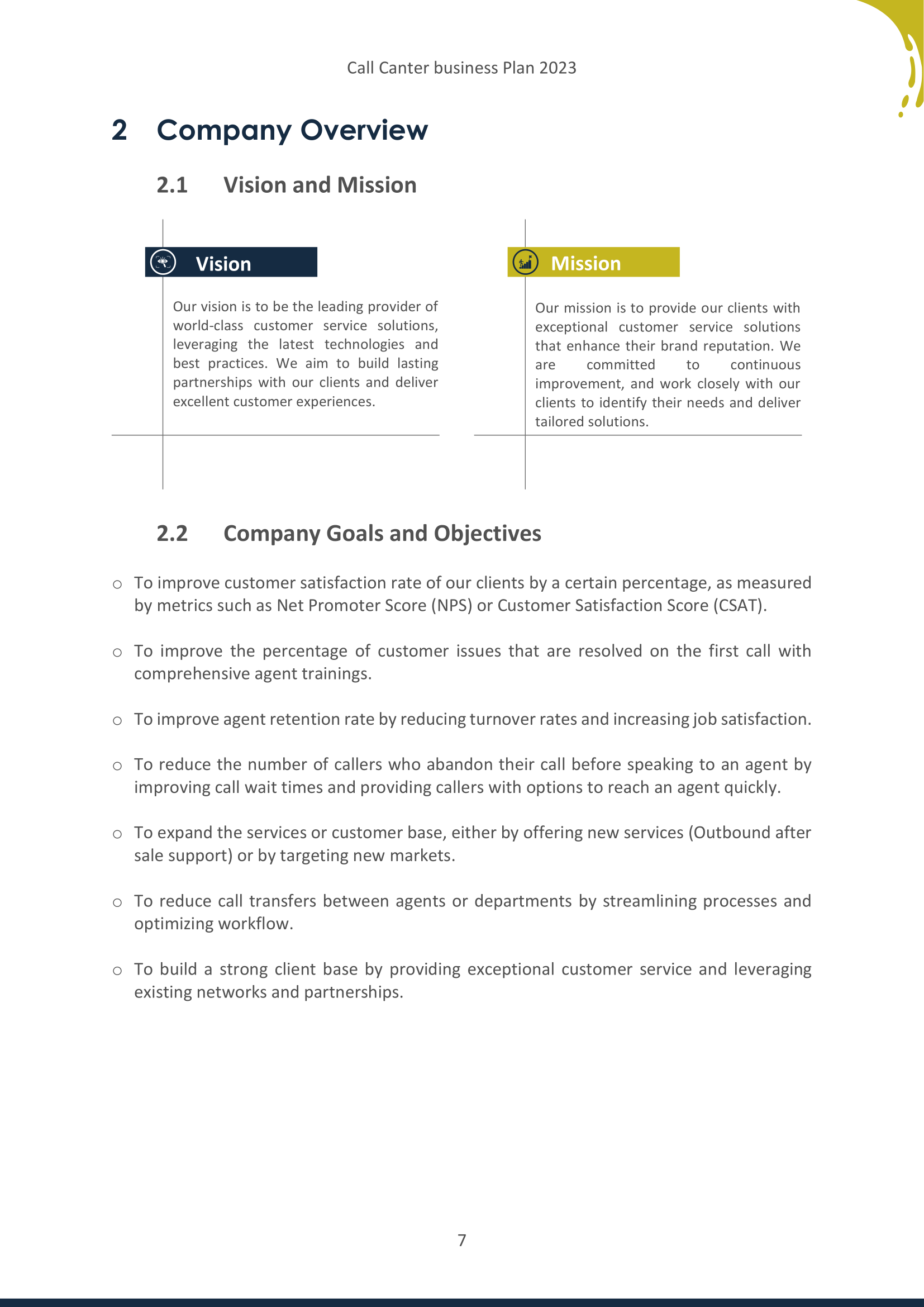
Looking for more amazing options for a Call Center Business Plan in a PowerPoint Format that will help you give an impressive presentation? Explore this content-ready resource now!
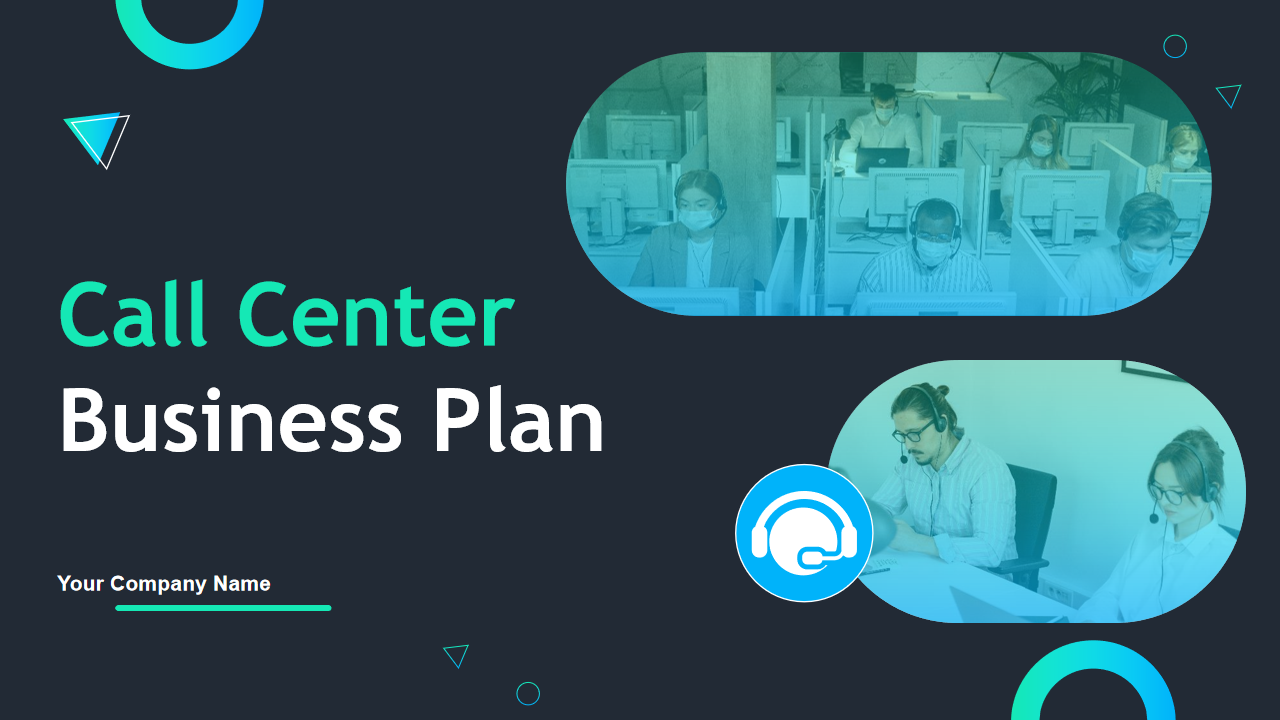
3. Industry Analysis
Investors want to see that your business operates in a viable and growing industry. The Industry Analysis provides data on market size, trends, and growth potential. It demonstrates to investors that your business is well-positioned in a sector with promising opportunities, making it an attractive investment.
In our Industry Analysis section, you will get templates for
3.1 Market Analysis: Explore the call center industry in all its glory, uncover the hidden gems, and find the industry pioneers that will change your business forever.
3.2 Market Trends: Stay one step ahead of the competition by staying on top of the call center trends to keep your customers’ attention.
3.3 Major Challenges: Challenge the industry head-on and develop innovative solutions to keep your call center business growing and thriving.
3.4 Growth Drivers: Create a strategic plan and determine the drivers to propel your brand’s growth and success in the years ahead.
3.5 Geographical Analysis: By tailoring your approach to the different regions of your target market, you can ensure consistent growth that resonates with regional preferences and fulfills local requirements.
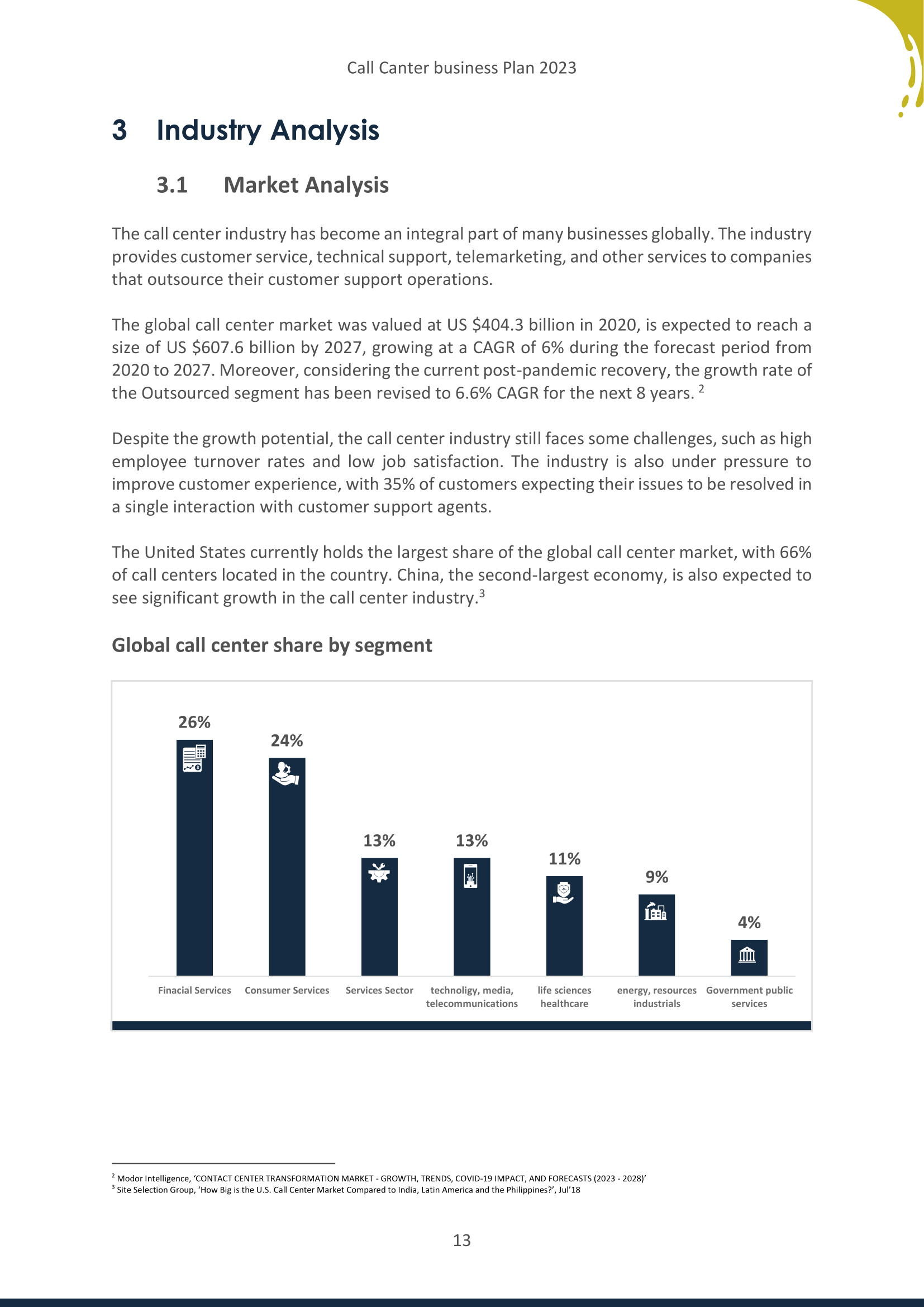
4. Customer Analysis
One of the most important things investors want to know about your business is that you know who your customers are. On this page, you’ll want to demonstrate that you know what your customers want, what they’re looking for, what they enjoy, and what kind of person they are. Investors want to see that you know your market and have developed strategies to attract and retain customers. If you can demonstrate that you know your customers, it’ll assure them there’s a demand for your call center services.
In our Customer Analysis section, we offer comprehensive templates for:
4.1 Target Market: Get a bird's eye view of which customer or business areas your call center services are good at to get an accurate and quantifiable market view.
4.2 Buyer Persona: Build an in-depth profile of your ideal customer, from their age and gender to their preferences and behavior, so you can tailor your services to meet their specific needs with skill.
4.3 Market Sizing: Find out how big the call center market is, figure out how much market share your brand can take, and give an idea of what opportunities are out there for you.
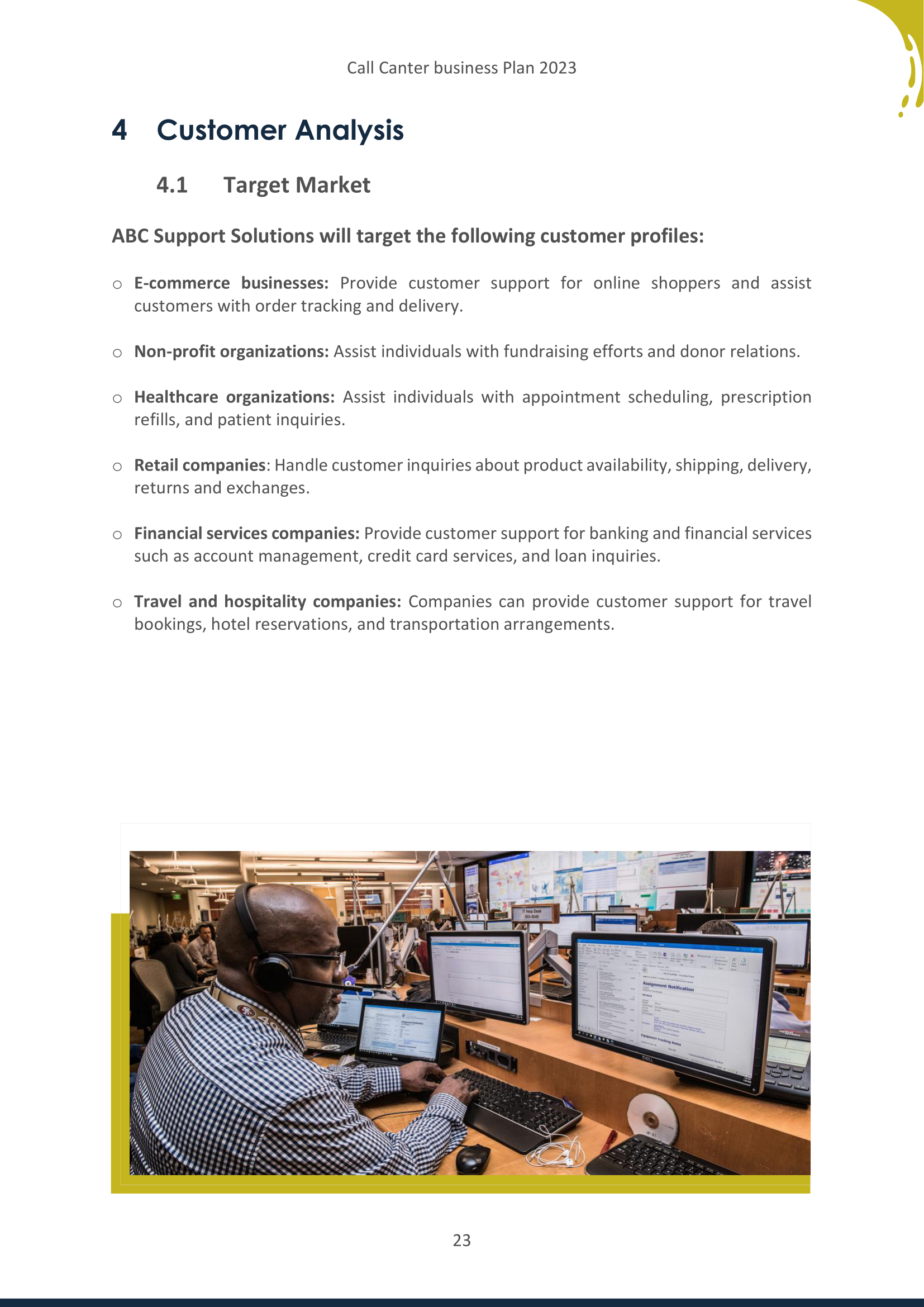
5. Competitor Analysis
Investors like businesses that are well-informed about their competition and are familiar with call center care growth trends. You will learn about your competitors’ strengths and weaknesses through a Competitor Analysis, which will help investors assess your competitive advantage. You can attract investors to see your business potential by differentiating from competitors.

6. SWOT Analysis
SWOT Analysis is an essential tool for self-assessment. SWOT Analysis assists investors in understanding the internal strengths and weaknesses of your telemarketing center business, and it’s external opportunities and threats. On this page, you will learn how to identify and mitigate the risks of your business while capitalizing on its strengths. Risk-averse investors will find your business more appealing.
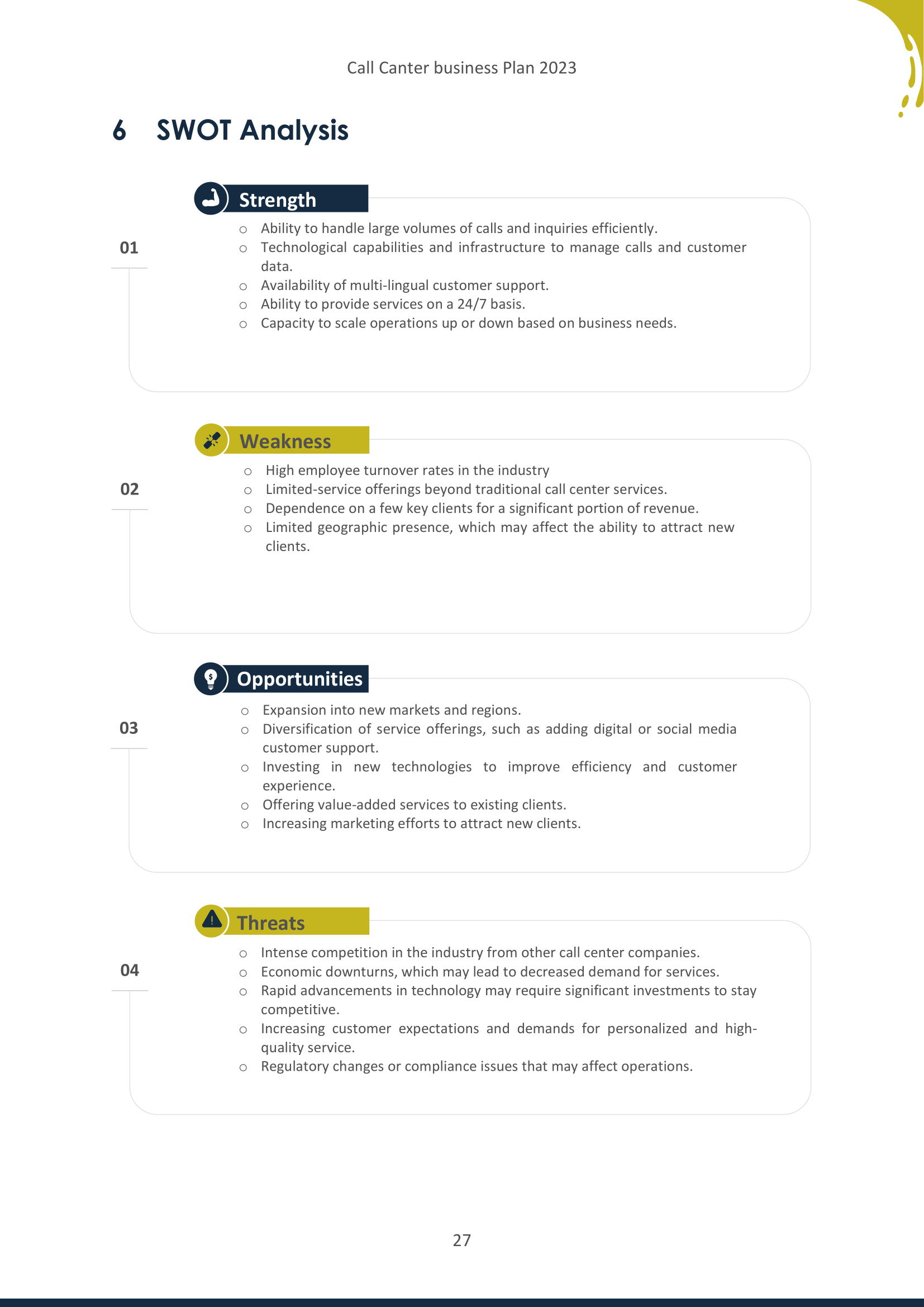
7. Porter's Framework
Porter's Framework analyzes the competition in your sector. Investors want to see how your technical call center business ranks and can withstand competitive pressure. Demonstrating your competitive tactics and market position can attract investors seeking businesses with a robust market presence and long-term competitive edge.
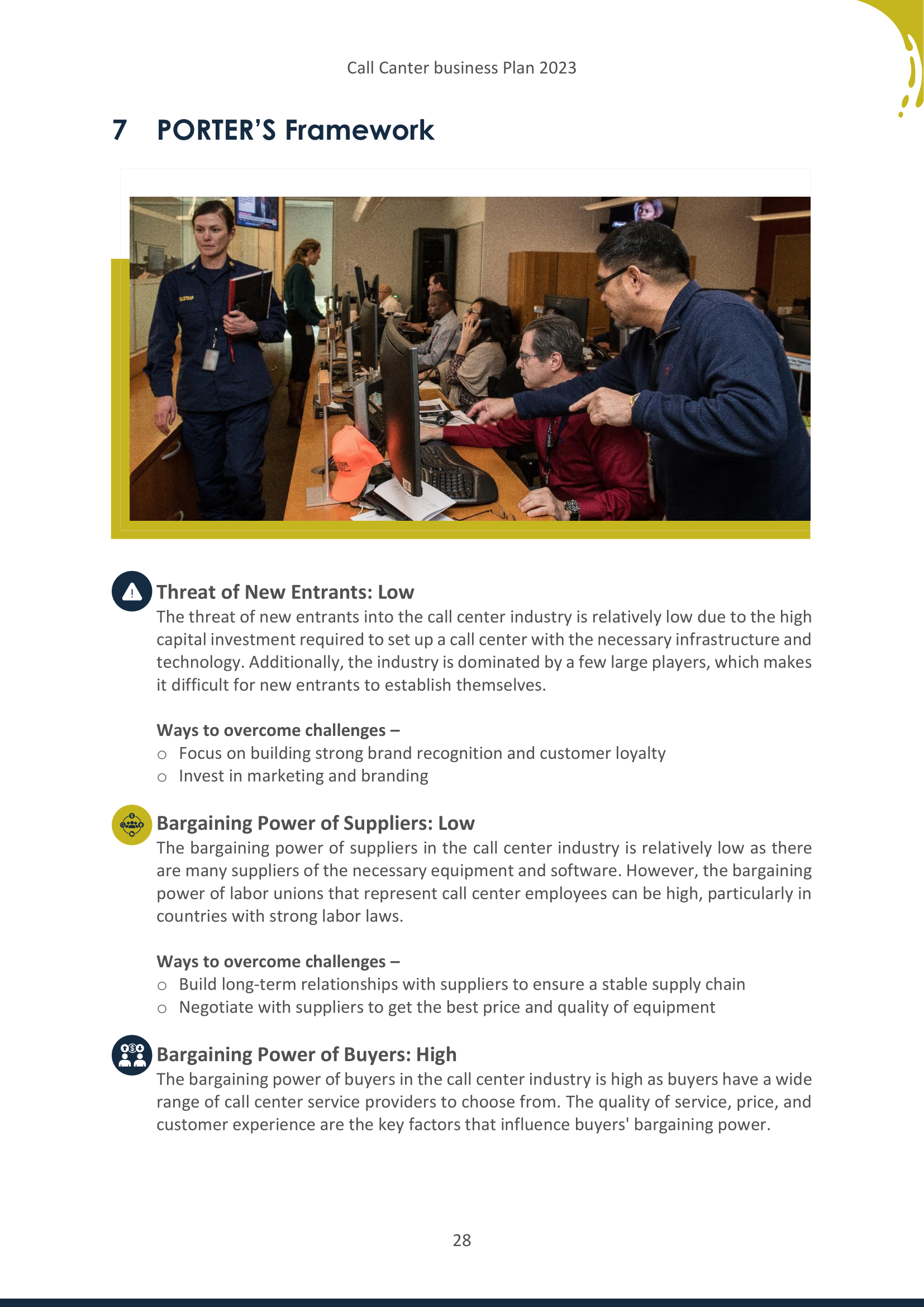
8. Marketing Plan
Investors want assurance that you have a well-thought-out strategy to attract and retain customers. The Marketing Plan outlines your approach to reaching and engaging clients. It's an opportunity to showcase your brand-building and customer acquisition strategies, which can appeal to investors looking for businesses with solid marketing foundations.
In our Marketing Plan section, we provide templates for:
8.1 Marketing Strategies: This includes the marketing channels, strategies, and campaigns you'll use to get and keep customers, as well as the amount of money you'll be spending on marketing.
8.2 Pricing Strategies: It covers pricing models, discounting, bundling, and competitive positioning strategies, all designed to maximize profitability and align with the company’s overall business objectives.
8.3 Customer Support Funnel: It usually has information about the customer service center team, the tech tools they use, how long it takes them to respond, and what steps they take to resolve issues. It's all about ensuring quick and effective customer support center service and resolution.
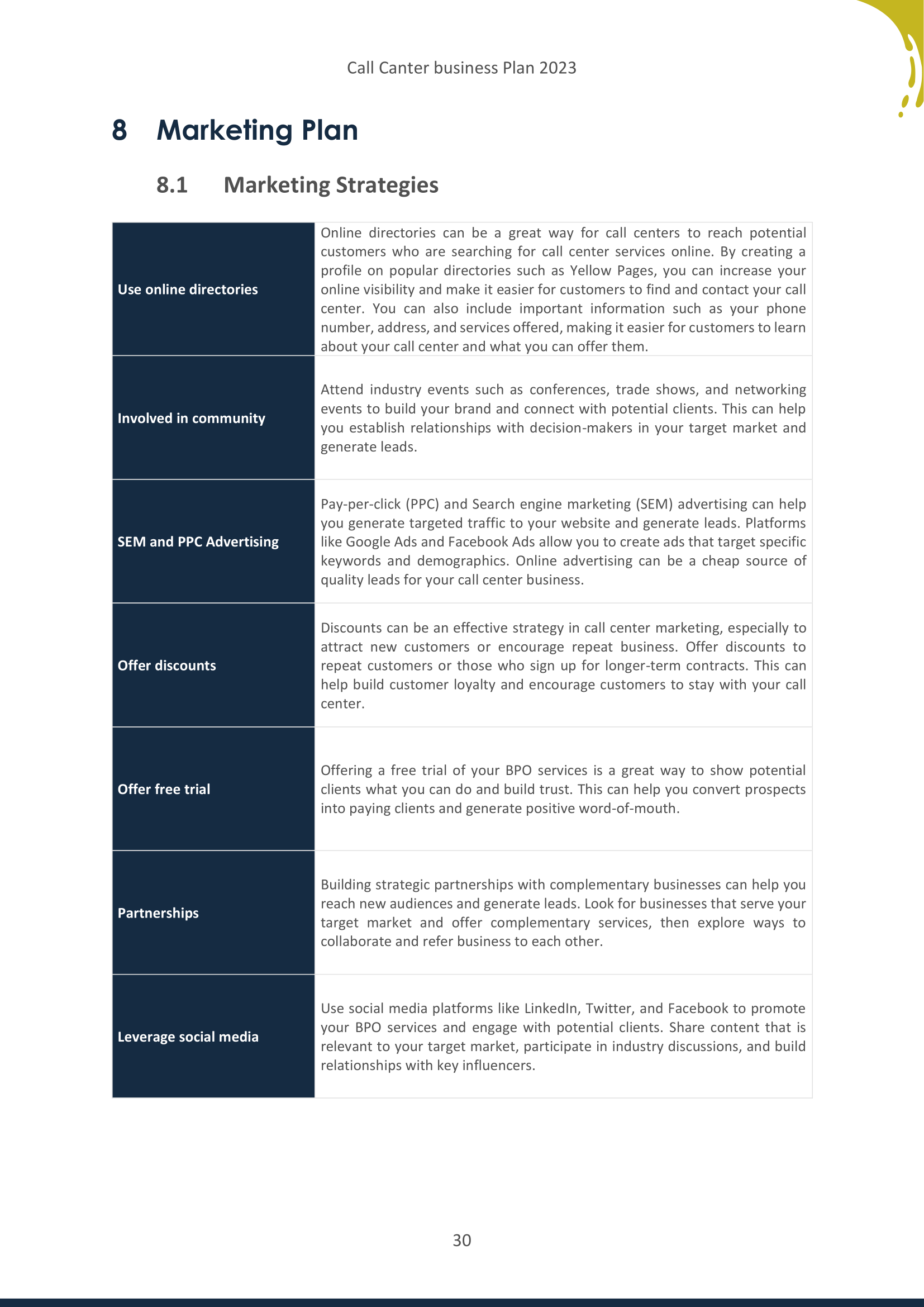
9. Operational Plan
Investors want to make sure your helpdesk center business is doing well. On the "Operational Plan" page, you'll want to give them an overview of your business's day-to-day operations, like who's working, what's happening, and how things are running. A good plan helps investors believe that your business will grow well.
In our Operational Plan section, we provide templates for:
9.1 Business Model: This text outlines how a business plans to generate revenue while providing value to its customers.
9.3 Milestones: Enhance the growth and success of your call center empire by highlighting your most significant accomplishments and turning points in your business history.
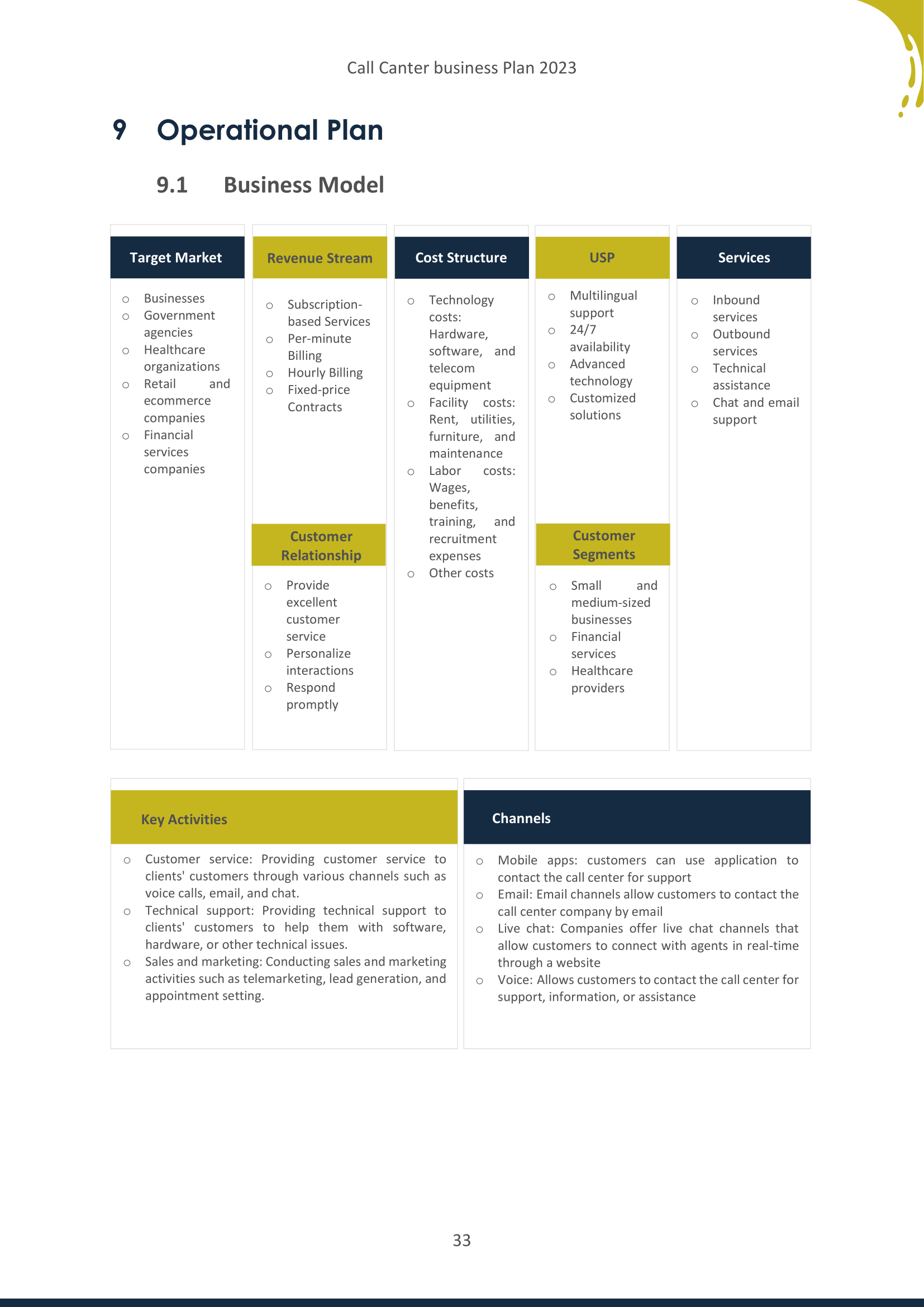
10. Financial Plan
The Financial Plan is critical for investors, providing insights into your financial projections. It includes revenue forecasts, expense breakdowns, and profitability estimates. Investors use this section to evaluate the potential return on their investment. A well-structured financial plan can attract investors seeking financial growth and stability opportunities.
In our Financial Plan section, we provide templates for:
10.1 Financial Assumptions: Transform your business objectives into a strategic plan that will improve your call center business's bottom line with the help of professional services.
10.2 Revenue Model and Sales Forecast: Determine how to monetize your call center business and strategize how it can expand.
10.3 Break-Down Analysis: Find out what is holding your business back from turning a profit, which is the first step to profitability.
10.4 Profit and Loss Statement: Gain a clear understanding of the financial potential of your call center business, including the amount of revenue that can be generated, the amount of expenses that can be incurred, and the anticipated revenue.
10.5 Cash Flow Statement: Keep track of how much money you expect to make from your call center business to make sure it's running smoothly.
10.6 Balance Sheet Statement: Get a complete view of how much your business generates in revenue, how much you’ll owe, and how much your business is worth. This way, you’ll be able to manage your finances as transparently as possible.
10.7 Scenario Analysis: Consider scenarios to see how varying conditions and risks could impact the financial health of your business.
10.8 DCF Valuation: A discounted cash flow analysis can determine your business's current value in the call center industry.
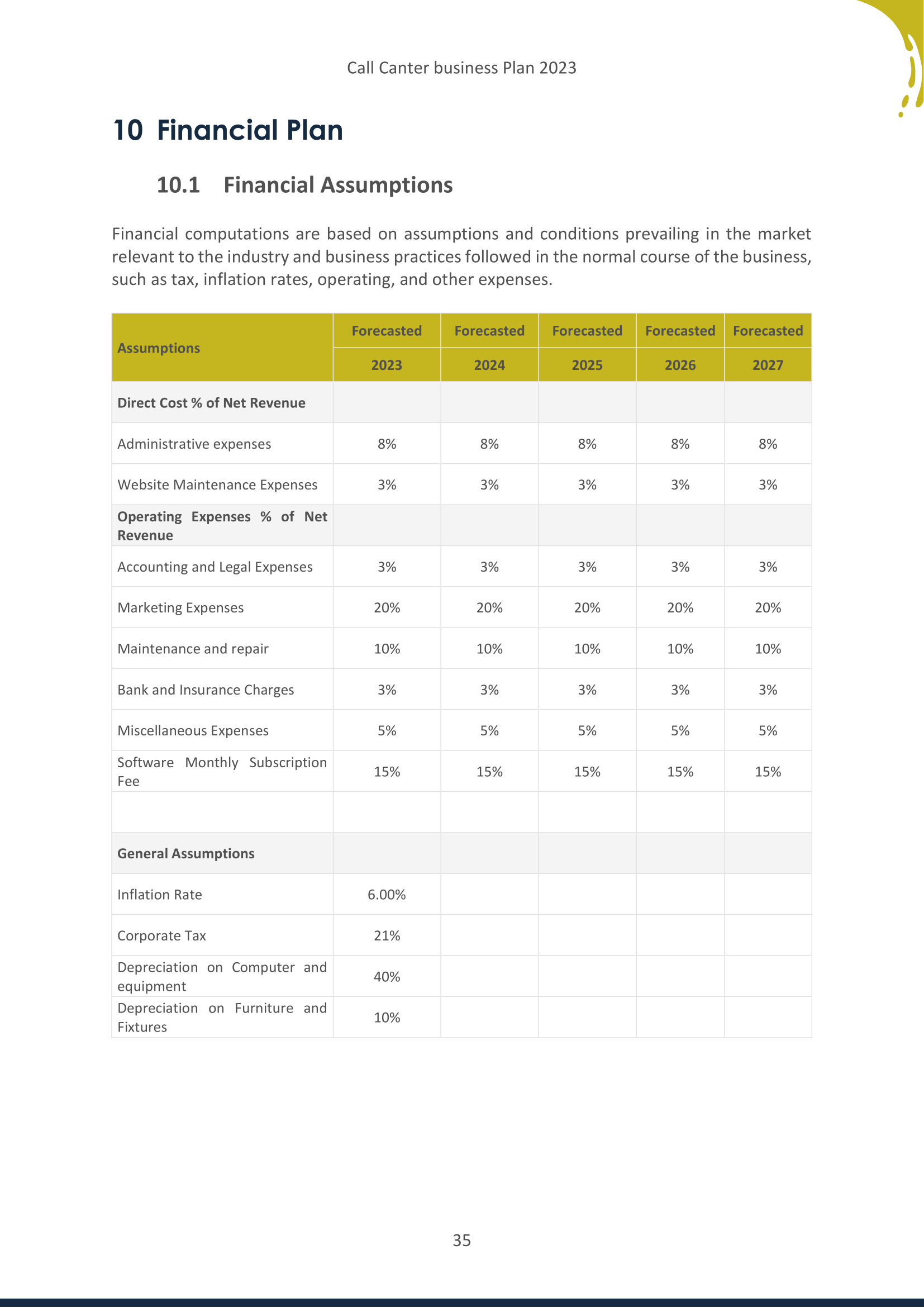
We have so much more to offer!
We hope this blog has given you an idea of the excellent content you can get from this business plan, but this is just the start. Download our business plan, and you will get 52 pages of content. Starting a call center business can be challenging regarding effective calling services. But this PDF is the one-stop solution to all your problems. Get started now!
You can subscribe to our monthly, semi-annual, and annual plans here .
Related posts:
- What Is A Customer Service Plan? 10 Templates to Master It
- Must-have Advertising Agency Business Plan Templates with Examples and Samples
- Top 10 Bar Business Plan Templates with Examples and Samples (Editable Word Doc, Excel and PDF Included)
- Top 10 Cleaning Service Business Plan Templates with Examples and Samples (Editable Word Doc, Excel and PDF Included)
Liked this blog? Please recommend us

Top 5 Time Management Chart Templates with Examples and Samples

Top 10 Healthy Food Templates with Samples and Examples
This form is protected by reCAPTCHA - the Google Privacy Policy and Terms of Service apply.

Digital revolution powerpoint presentation slides

Sales funnel results presentation layouts
3d men joinning circular jigsaw puzzles ppt graphics icons

Business Strategic Planning Template For Organizations Powerpoint Presentation Slides

Future plan powerpoint template slide

Project Management Team Powerpoint Presentation Slides

Brand marketing powerpoint presentation slides

Launching a new service powerpoint presentation with slides go to market

Agenda powerpoint slide show

Four key metrics donut chart with percentage

Engineering and technology ppt inspiration example introduction continuous process improvement

Meet our team representing in circular format

How to write a business plan for a call center?

Creating a business plan for a call center is an essential process for any entrepreneur. It serves as a roadmap that outlines the necessary steps to be taken to start or grow the business, the resources required, and the anticipated financial outcomes. It should be crafted with method and confidence.
This guide is designed to provide you with the tools and knowledge necessary for creating a call center business plan, covering why it is so important both when starting up and running an established business, what should be included in your plan, how it should be structured, what tools should be used to save time and avoid errors, and other helpful tips.
We have a lot to cover, so let's get to it!
In this guide:
Why write a business plan for a call center?
- What information is needed to create a business plan for a call center?
- What goes in the financial forecast for a call center?
- What goes in the written part of a call center business plan?
- What tool can I use to write my call center business plan?
Being clear on the scope and goals of the document will make it easier to understand its structure and content. So before diving into the actual content of the plan, let's have a quick look at the main reasons why you would want to write a call center business plan in the first place.
To have a clear roadmap to grow the business
Small businesses rarely experience a constant and predictable environment. Economic cycles go up and down, while the business landscape is mutating constantly with new regulations, technologies, competitors, and consumer behaviours emerging when we least expect it.
In this dynamic context, it's essential to have a clear roadmap for your call center. Otherwise, you are navigating in the dark which is dangerous given that - as a business owner - your capital is at risk.
That's why crafting a well-thought-out business plan is crucial to ensure the long-term success and sustainability of your venture.
To create an effective business plan, you'll need to take a step-by-step approach. First, you'll have to assess your current position (if you're already in business), and then identify where you'd like your call center to be in the next three to five years.
Once you have a clear destination for your call center, you'll focus on three key areas:
- Resources: you'll determine the human, equipment, and capital resources needed to reach your goals successfully.
- Speed: you'll establish the optimal pace at which your business needs to grow if it is to meet its objectives within the desired timeframe.
- Risks: you'll identify and address potential risks you might encounter along the way.
By going through this process regularly, you'll be able to make informed decisions about resource allocation, paving the way for the long-term success of your business.
To anticipate future cash flows
Regularly comparing your actual financial performance to the projections in the financial forecast of your call center's business plan gives you the ability to monitor your business's financial health and make necessary adjustments as needed.
This practice allows you to detect potential financial issues, such as unexpected cash shortfalls before they escalate into major problems. Giving you time to find additional financing or put in place corrective measures.
Additionally, it helps you identify growth opportunities, like excess cash flow that could be allocated to launch new products and services or expand into new markets.
Staying on track with these regular comparisons enables you to make well-informed decisions about the amount of financing your business might require, or the excess cash flow you can expect to generate from your main business activities.
To secure financing
Whether you are a startup or an existing business, writing a detailed call center business plan is essential when seeking financing from banks or investors.
This makes sense given what we've just seen: financiers want to ensure you have a clear roadmap and visibility on your future cash flows.
Banks will use the information included in the plan to assess your borrowing capacity (how much debt your business can support) and your ability to repay the loan before deciding whether they will extend credit to your business and on what terms.
Similarly, investors will review your plan carefully to assess if their investment can generate an attractive return on investment.
To do so, they will be looking for evidence that your call center has the potential for healthy growth, profitability, and cash flow generation over time.
Now that you understand why it is important to create a business plan for a call center, let's take a look at what information is needed to create one.
Information needed to create a business plan for a call center
You need the right data in order to project sales, investments and costs accurately in the financial forecast of your call center business plan.
Below, we'll cover three key pieces of information you should gather before drafting your business plan.
Carrying out market research for a call center
Carrying out market research before writing a business plan for a call center is essential to ensure that the financial projections are accurate and realistic.
Market research helps you gain insight into your target customer base, competitors, pricing strategies and other key factors which can have an impact on the commercial success of your business.
In particular, it is useful in forecasting revenue as it provides valuable data regarding potential customers’ spending habits and preferences.
You may discover that customers may prefer to communicate via text message rather than phone call. Additionally, market research could reveal that customers might prefer to use online chatbots for customer service inquiries.
This information can then be used to create more accurate financial projections which will help investors make informed decisions about investing in your call center.
Developing the sales and marketing plan for a call center
As you embark on creating your call center business plan, it is crucial to budget sales and marketing expenses beforehand.
A well-defined sales and marketing plan should include precise projections of the actions required to acquire and retain customers. It will also outline the necessary workforce to execute these initiatives and the budget required for promotions, advertising, and other marketing efforts.
This approach ensures that the appropriate amount of resources is allocated to these activities, aligning with the sales and growth objectives outlined in your business plan.
The staffing and capital expenditure requirements of a call center
Whether you are starting or expanding a call center, it is important to have a clear plan for recruitment and capital expenditures (investment in equipment and real estate) in order to ensure the success of the business.
Both the recruitment and investment plans need to be coherent with the timing and level of growth planned in your forecast, and require appropriate funding.
Staffing costs for a call center might include salaries for customer service representatives, supervisors, and managers, as well as costs for employee benefits such as health insurance and paid time off. Equipment costs might include the cost of computers, headsets, phone systems, and any necessary software.
In order to create a realistic financial forecast, you will also need to consider the other operating expenses associated with running the business on a day-to-day basis (insurance, bookkeeping, etc.).
Once you have all the necessary information to create a business plan for your call center, it is time to start creating your financial forecast.
What goes into your call center's financial forecast?
The objective of the financial forecast of your call center's business plan is to show the growth, profitability, funding requirements, and cash generation potential of your business over the next 3 to 5 years.
The four key outputs of a financial forecast for a call center are:
- The profit and loss (P&L) statement ,
- The projected balance sheet ,
- The cash flow forecast ,
- And the sources and uses table .
Let's look at each of these in a bit more detail.
The projected P&L statement
The projected P&L statement for a call center shows how much revenue and profit your business is expected to make in the future.
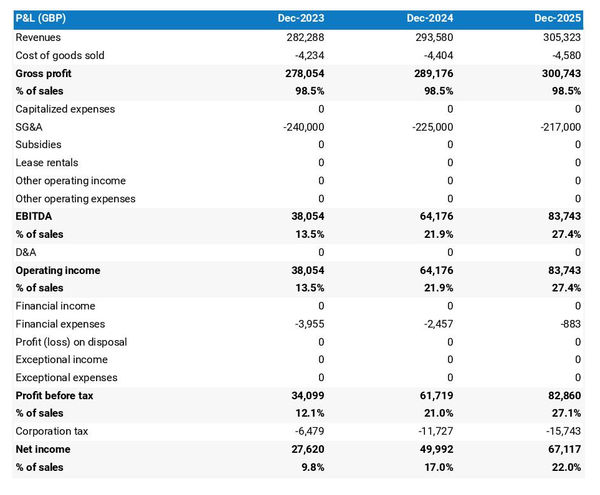
A healthy call center's P&L statement should show:
- Sales growing at (minimum) or above (better) inflation
- Stable (minimum) or expanding (better) profit margins
- A healthy level of net profitability
This will of course depend on the stage of your business: numbers for a startup will look different than for an established call center.
The forecasted balance sheet of your call center
The projected balance sheet of your call center will enable the reader of your business plan to assess the overall financial health of your business.
It shows three elements: assets, liabilities and equity:
- Assets: are productive resources owned by the business, such as equipment, cash, and accounts receivable (money owed by clients).
- Liabilities: are debts owed to creditors, lenders, and other entities, such as accounts payable (money owed to suppliers).
- Equity: includes the sums invested by the shareholders or business owners and the profits and losses accumulated by the business to date (which are called retained earnings). It is a proxy for the value of the owner's stake in the business.
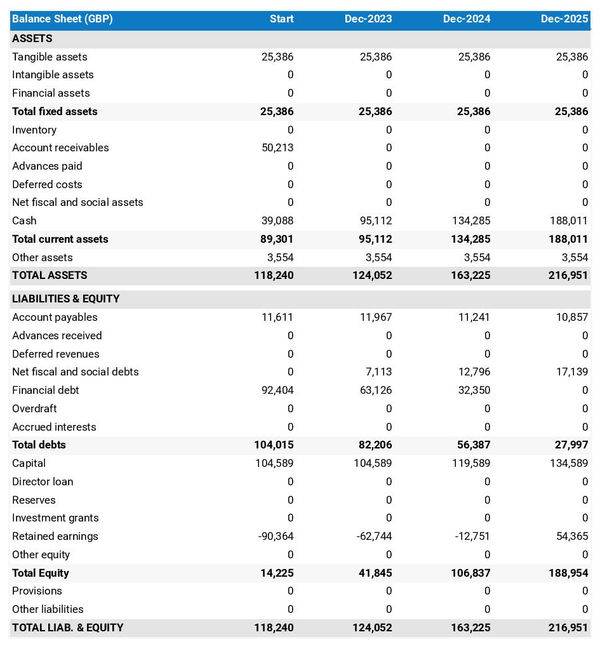
Analysing your call center projected balance sheet provides an understanding of your call center's working capital structure, investment and financing policies.
In particular, the readers of your plan can compare the level of financial debt on the balance sheet to the equity value to measure the level of financial risk (equity doesn't need to be reimbursed, while financial debt must be repaid, making it riskier).
They can also use your balance sheet to assess your call center's liquidity and solvency:
- A liquidity analysis: focuses on whether or not your business has sufficient cash and short-term assets to cover its liabilities due in the next 12 months.
- A solvency analysis: takes and longer view to assess whether or not your business has the capacity to repay its debts over the medium-term.
The projected cash flow statement
A cash flow forecast for a call center shows how much cash the business is projected to generate or consume.
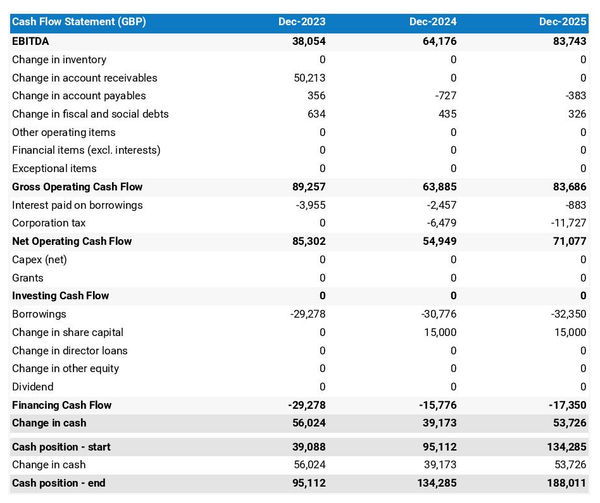
The cash flow statement is divided into 3 main areas:
- The operating cash flow shows how much cash is generated or consumed by the operations (running the business)
- The investing cash flow shows how much cash is being invested in capital expenditure (equipment, real estate, etc.)
- The financing cash flow shows how much cash is raised or distributed to investors and lenders
Looking at the cash flow forecast helps you to ensure that your business has enough cash to keep running, and can help you anticipate potential cash shortfalls.
It is also a best practice to include a monthly cash flow statement in the appendices of your call center business plan so that the readers can view the impact of seasonality on your business cash position and generation.
The initial financing plan
The sources and uses table or initial financing plan is a key component of your business plan when starting a call center.
It shows where the capital needed to set up the business will come from (sources) and how it will be spent (uses).

This table helps size the investment required to set up the call center, and understand how risks will be distributed between the business owners, and the financiers.
The sources and uses table also highlights what the starting cash position will be. This is key for startups as the business needs to have sufficient funding to sustain operations until the break-even point is reached.
Now that you have a clear understanding of what will go into the financial forecast of your call center business plan, let's have a look at the written part of the plan.
The written part of a call center business plan
The written part of a call center business plan plays a key role: it lays out the plan of action you intend to execute to seize the commercial opportunity you've identified on the market and provides the context needed for the reader to decide if they believe your plan to be achievable and your financial forecast to be realistic.
The written part of a call center business plan is composed of 7 main sections:
- The executive summary
- The presentation of the company
- The products and services
- The market analysis
- The strategy
- The operations
- The financial plan
Let's go through the content of each section in more detail!
1. The executive summary
The executive summary, the first section of your call center's business plan, serves as an inviting snapshot of your entire plan, leaving readers eager to know more about your business.
To compose an effective executive summary, start with a concise introduction of your business, covering its name, concept, location, history, and unique aspects. Share insights about the services or products you intend to offer and your target customer base.
Subsequently, provide an overview of your call center's addressable market, highlighting current trends and potential growth opportunities.
Then, present a summary of critical financial figures, such as projected revenues, profits, and cash flows.
You should then include a summary of your key financial figures such as projected revenues, profits, and cash flows.
Lastly, address any funding needs in the "ask" section of your executive summary.
2. The presentation of the company
As you build your call center business plan, the second section deserves attention as it delves into the structure and ownership, location, and management team of your company.
In the structure and ownership part, you'll provide valuable insights into the legal structure of the business, the identities of the owners, and their respective investments and ownership stakes. This level of transparency is vital, particularly if you're seeking financing, as it clarifies which legal entity will receive the funds and who holds the reins of the business.
Moving to the location part, you'll offer a comprehensive view of the company's premises and articulate why this specific location is strategic for the business, emphasizing factors like catchment area, accessibility, and nearby amenities.
When describing the location of your call center, you may want to emphasize its accessibility and potential for growth. You could mention that it is in a well-connected region, with access to major highways, airports, and other forms of public transportation. You might also emphasize that the area has a potential for growth, with a steady influx of businesses and a growing population. Additionally, you could highlight how the area is attractive to potential employees, with a variety of recreational activities and amenities nearby.
Lastly, you should introduce your esteemed management team. Provide a thorough explanation of each member's role, background, and extensive experience.
It's equally important to highlight any past successes the management team has achieved and underscore the duration they've been working together. This information will instil trust in potential lenders or investors, showcasing the strength and expertise of your leadership team and their ability to deliver the business plan.
3. The products and services section
The products and services section of your call center business plan should include a detailed description of what your company sells to its customers.
For example, your call center may offer customer service support, technical assistance, and appointment scheduling services to its customers. Customer service support could include help with orders, returns, home delivery, and general inquiries. Technical assistance could include assistance with troubleshooting, installation, and connecting devices. Appointment scheduling could include setting up appointments for product demonstrations, customer service visits, and technical support visits. All of these services help customers get the most out of their products and make their lives easier.
The reader will want to understand what makes your call center unique from other businesses in this competitive market.
When drafting this section, you should be precise about the categories of products or services you sell, the clients you are targeting and the channels that you are targeting them through.
4. The market analysis
When presenting your market analysis in your call center business plan, you should detail the customers' demographics and segmentation, target market, competition, barriers to entry, and any regulations that may apply.
The goal of this section is to help the reader understand how big and attractive your market is, and demonstrate that you have a solid understanding of the industry.
You should start with the demographics and segmentation subsection, which gives an overview of the addressable market for your call center, the main trends in the marketplace, and introduces the different customer segments and their preferences in terms of purchasing habits and budgets.
The target market section should follow and zoom on the customer segments your call center is targeting, and explain how your products and services meet the specific needs of these customers.
For example, your target market might include young professionals. This group of people likely needs help with a variety of financial or tech products and are likely to look for customer service. They are also willing to spend money on products or services that make their lives easier.
Then comes the competition subsection, where you should introduce your main competitors and explain what differentiates you from them.
Finally, you should finish your market analysis by giving an overview of the main regulations applicable to your call center.
5. The strategy section
When crafting the strategy section of your business plan for your call center, it's important to cover several key aspects, including your competitive edge, pricing strategy, sales & marketing plan, milestones, and risks and mitigants.
In the competitive edge subsection, clearly explain what sets your company apart from competitors. This is particularly critical if you're a startup, as you'll be trying to establish your presence in the marketplace among entrenched players.
The pricing strategy subsection should demonstrate how you aim to maintain profitability while offering competitive prices to your customers.
For the sales & marketing plan, outline how you plan to reach and acquire new customers, as well as retain existing ones through loyalty programs or special offers.
In the milestones subsection, detail what your company has achieved thus far and outline your primary objectives for the coming years by including specific dates for expected progress. This ensures everyone involved has clear expectations.
Lastly, in the risks and mitigants subsection, list the main risks that could potentially impact the execution of your plan. Explain the measures you've taken to minimize these risks. This is vital for investors or lenders to feel confident in supporting your venture - try to proactively address any objection they might have.
Your call center could face the risk of downtime due to technical difficulties. Systems, software, and hardware could malfunction, leading to decreased productivity and customer satisfaction. Your call center may also face the risk of poor customer service. If agents are not properly trained, they could potentially provide incorrect information or be unable to answer customer inquiries. This could lead to customer dissatisfaction and complaints.
6. The operations section
The operations of your call center must be presented in detail in your business plan.
The first thing you should cover in this section is your staffing team, the main roles, and the overall recruitment plan to support the growth expected in your business plan. You should also outline the qualifications and experience necessary to fulfil each role, and how you intend to recruit (using job boards, referrals, or headhunters).
You should then state the operating hours of your call center - so that the reader can check the adequacy of your staffing levels - and any plans for varying opening times during peak season. Additionally, the plan should include details on how you will handle customer queries outside of normal operating hours.
The next part of this section should focus on the key assets and IP required to operate your business. If you depend on any licenses or trademarks, physical structures (equipment or property) or lease agreements, these should all go in there.
You could have key assets such as a high-quality phone system and a good customer relationship management (CRM) system. These may allow the call center to provide a more efficient customer service experience. Additionally, the call center might have intellectual property such as a unique customer service script or a specialized training program. These could give the call center a competitive edge in the market.
Finally, you should include a list of suppliers that you plan to work with and a breakdown of their services and main commercial terms (price, payment terms, contract duration, etc.). Investors are always keen to know if there is a particular reason why you have chosen to work with a specific supplier (higher-quality products or past relationships for example).
7. The presentation of the financial plan
The financial plan section is where we will present the financial forecast we talked about earlier in this guide.
Now that you have a clear idea of what goes in your call center business plan, let's look at the solutions you can use to draft yours.
What tool should I use to write my call center's business plan?
In this section, we will be reviewing the two main solutions for creating a call center business plan:
- Using specialized online business plan software,
- Outsourcing the plan to the business plan writer.
Using an online business plan software for your call center's business plan
The modern and most efficient way to write a call center business plan is to use business plan software .
There are several advantages to using specialized software:
- You can easily create your financial forecast by letting the software take care of the financial calculations for you without errors
- You are guided through the writing process by detailed instructions and examples for each part of the plan
- You can access a library of dozens of complete business plan samples and templates for inspiration
- You get a professional business plan, formatted and ready to be sent to your bank or investors
- You can easily track your actual financial performance against your financial forecast
- You can create scenarios to stress test your forecast's main assumptions
- You can easily update your forecast as time goes by to maintain visibility on future cash flows
- You have a friendly support team on standby to assist you when you are stuck
If you're interested in using this type of solution, you can try The Business Plan Shop for free by signing up here .

Hiring a business plan writer to write your call center's business plan
Outsourcing your call center business plan to a business plan writer can also be a viable option.
Business plan writers are experienced in writing business plans and adept at creating financial forecasts without errors. Furthermore, hiring a consultant can save you time and allow you to focus on the day-to-day operations of your business.
However, hiring business plan writers is expensive as you are paying for the software used by the consultant, plus their time, and their profit margin of course.
From experience, you need to budget at least £1.5k ($2.0k) excluding tax for a complete business plan, more if you need to make changes after the initial version (which happens frequently after the initial meetings with lenders or investors).
You also need to be careful when seeking investment. Investors want their money to be used to grow the business, not spent on consulting fees. Therefore, the amount you spend on business plan writing services (and other consulting services such as legal services) needs to be negligible relative to the amount raised.
The other drawback is that you usually don't own the business plan itself: you just get the output, while the actual document is saved in the consultant's business plan software - which makes it difficult to maintain the document up to date without hiring the consultant on a retainer.
For these reasons, outsourcing the call center business plan to a business plan writer should be considered carefully, weighing both the advantages and disadvantages of hiring outside help.
Ultimately, it may be the right decision for some businesses, while others may find it beneficial to write their business plan using online software.
Why not create your call center's business plan using Word or Excel?
Using Microsoft Excel and Word (or their Google, Apple, or open-source equivalents) to write a call center business plan is a terrible idea.
For starters, creating an accurate and error-free financial forecast on Excel (or any spreadsheet) is very technical and requires both a strong grasp of accounting principles and solid skills in financial modelling.
As a result, it is unlikely anyone will trust your numbers unless - like us at The Business Plan Shop - you hold a degree in finance and accounting and have significant financial modelling experience in your past.
The second reason is that it is inefficient. Building forecasts on spreadsheets was the only option in the 1990s and early 2000s, nowadays technology has advanced and software can do it much faster and much more accurately.
And with the rise of AI, software is also becoming smarter at helping us detect mistakes in our forecasts and helping us analyse the numbers to make better decisions.
Also, using software makes it easy to compare actuals vs. forecasts and maintain our forecasts up to date to maintain visibility on future cash flows - as we discussed earlier in this guide - whereas this is a pain to do with a spreadsheet.
That's for the forecast, but what about the written part of my call center business plan?
This part is less error-prone, but here also software brings tremendous gains in productivity:
- Word processors don't include instructions and examples for each part of your business plan
- Word processors don't update your numbers automatically when they change in your forecast
- Word processors don't handle the formatting for you
Overall, while Word or Excel may be viable options for creating a call center business plan for some entrepreneurs, it is by far not the best or most efficient solution.
- Using business plan software is a modern and cost-effective way of writing and maintaining business plans.
- A business plan is not a one-shot exercise as maintaining it current is the only way to keep visibility on your future cash flows.
- A business plan has 2 main parts: a financial forecast outlining the funding requirements of your call center and the expected growth, profits and cash flows for the next 3 to 5 years; and a written part which gives the reader the information needed to decide if they believe the forecast is achievable.
We hope that this in-depth guide met your expectations and that you now have a clear understanding of how to write your call center business plan. Do not hesitate to contact our friendly team if you have questions additional questions we haven't addressed here.
Also on The Business Plan Shop
- How to write a business plan to secure a bank loan?
- Key steps to write a business plan?
- Top mistakes to avoid in your business plan
Do you know entrepreneurs interested in starting or growing a call center? Share this article with them!

Founder & CEO at The Business Plan Shop Ltd
Guillaume Le Brouster is a seasoned entrepreneur and financier.
Guillaume has been an entrepreneur for more than a decade and has first-hand experience of starting, running, and growing a successful business.
Prior to being a business owner, Guillaume worked in investment banking and private equity, where he spent most of his time creating complex financial forecasts, writing business plans, and analysing financial statements to make financing and investment decisions.
Guillaume holds a Master's Degree in Finance from ESCP Business School and a Bachelor of Science in Business & Management from Paris Dauphine University.
Create a convincing business plan
Assess the profitability of your business idea and create a persuasive business plan to pitch to investors

500,000+ entrepreneurs have already tried our solution - why not join them?
Not ready to try our on-line tool ? Learn more about our solution here
Need some inspiration for your business plan?
Subscribe to The Business Plan Shop and gain access to our business plan template library.

Need a professional business plan? Discover our solution
Write your business plan with ease!

It's easy to create a professional business plan with The Business Plan Shop
Want to find out more before you try? Learn more about our solution here

How to Start a Call Center Business in 2024
Despite the recent rapid rise of digital communication channels and an increased demand for self-service support, phone still continues to dominate as the most preferred support channel. In fact, according to a Salesforce study , 59% of consumers favor traditional phone calls to reach a customer support representative. Phone sales are also here to stay as one of the most efficient and cost-effective ways for businesses to promote and sell their products or services.
If you’re looking to set up a call center business in 2024 and beyond, you’ve landed on the right page. While building your own call center – whether inbound, outbound, or blended – might seem too challenging to start, knowing exactly what to do will instantly blow your fears away.
Looking for a Contact Center Solution?
Powerful AI dialer, bulk SMS, and more tools for running an omnichannel contact center.
Based on VoiceSpin’s 15-year experience in the call center industry, we’ve decided to come up with a step-by-step guide on how to start a call center and walk you through every phase of the process.
- How to Start a Call Center Business in 10 Steps
- 1. Set Your Call Center Goals
Just like with any other business, building a call center requires careful planning. Before you actually start setting up your own call center, have a clear understanding of wh y you want to start a call center and outline the goals you are looking to achieve. Make sure, however, that these goals are specific, realistic, achievable given your current budget and resources, and align with your broader business objectives.
On top of that, setting goals will help you establish clear criteria for measuring performance (we’ll talk about call center metrics and KPIs in more detail below) and the overall success of your call center.
- 2. Decide on Call Center Type
Inbound vs. outbound vs. blended call center

Inbound call center
Inbound call centers primarily deal with incoming calls from existing customers, clients, or prospects. Businesses set up inbound call centers for general customer service, technical support, processing orders, payments, returns, and exchanges, handling upgrades and renewal requests, appointment scheduling, and inbound sales. The most typical industries to benefit from inbound call centers are e-commerce and retail, travel and hospitality, healthcare, finance, and insurance.
Outbound call center
In outbound call centers, agents are placing outbound phone calls to prospects or customers. Outbound call centers are commonly used for lead generation, telemarketing, sales campaigns, appointment setting and reminders, debt collection, market research and CSAT surveys, etc. For providing outbound call center services, you need call center software with auto dialing capabilities that will enable you to automate the dialing process, so that agents don’t have to dial each number manually.
Blended call center
Blended call centers (also known as hybrid call centers) combine both inbound and outbound calling capabilities and are best suited for businesses that have relatively equal volumes of incoming and outgoing calls. Luckily, many call center software providers offer a fair share of features to support both inbound and outbound calling activities. E.g., VoiceSpin call center solutions are perfectly suited for inbound customer support and outbound sales teams alike.
On-site vs. remote vs. virtual call center
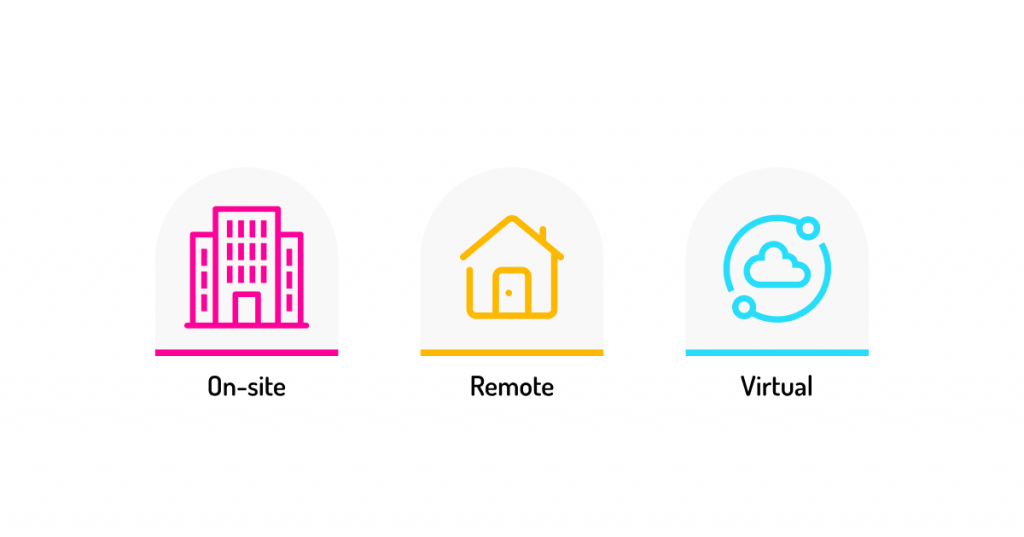
On-site call center
In a traditional on-site call center, agents are going to work from a physical location, which might be the best option for fixed-location businesses and those with large teams. Improved team collaboration, direct supervision, and increased data security are some of the advantages that will follow. However, there are also certain downsides to selecting on-site deployment, such as higher operational costs, a rather limited talent pool, and a lack of flexibility of remote working.
Remote call center
Remote call centers are entirely offsite call centers, typically powered by outsourcing. This might be an ideal option for small businesses and startups that would like to avoid paying for physical office space, office equipment, and hardware, making remote call centers much more cost-efficient compared to on-premises solutions. That also provides you with access to a broader talent pool while allowing greater flexibility for agents.
Virtual call center
Similarly to remote call centers, virtual call centers aren’t tied to one geographical location, with agents often being distributed across multiple regions, working from various remote locations. Virtual call centers run on cloud-based VoIP call center software, allowing agents to access the system and work from nearly everywhere, as long as there’s a stable internet connection. That offers businesses access to an even broader talent pool, easy scalability, and cost-efficiency.
Call center vs. omnichannel contact center
Call center
If you’re looking to set up a traditional call center where agents will only handle voice communications, you would basically need to purchase a business phone system with call-handling features like IVR, call routing, call forwarding, call transfer, call queueing, call recording, call reporting and analytics, click-to-call, auto dialing, etc.
Omnichannel contact center
If you’re planning to handle customer interactions across multiple communication channels, you may want to set up an omnichannel contact center that integrates both voice and digital communication channels like email, live chat, SMS, social media, and Instant Messaging apps. With an integrated solution, agents will be able to manage all interactions from one platform, with no need to switch between the apps, eliminating the risk of communication silos.
Related article: A Complete Guide to Omnichannel Contact Center
- 3. Establish a Budget
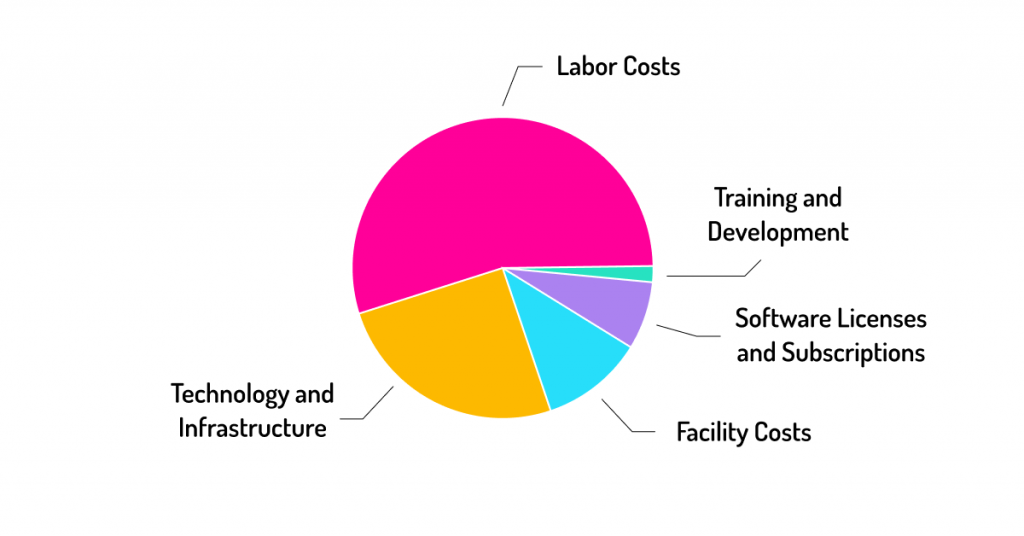
The total cost of setting up a call center will ultimately depend on a range of factors, such as the setup type, software and hardware, required features, the number of employees, etc. Here’s what you should consider when putting together your budget:
Office space and hardware : In addition to office space and office equipment expenses, running an on-site call center will also require you to pay for the hardware and infrastructure, not to mention ongoing maintenance fees and updates. However, you can eliminate office and hardware expenses by setting up a remote call center.
Call center software: Take into account software licenses and set-up costs for on-premises tools and monthly subscription fees for cloud-based solutions. Pricing plans of cloud-based providers may differ based on the features offered in a specific pricing tier, the billing structure (fixed monthly fee, monthly fee per user, per-minute fee), and the number of users.
Employee salaries: Agent salaries may significantly vary based on location and experience level. Besides, you may also encounter additional expenses that may come up later, such as rewards and incentives for top-performing agents, ongoing training costs, or expenses for holding team-building events, to name a few.
Training and customer support: While most call center software providers include basic employee training and some level of customer support in their subscription plans, custom in-person training and 24/7 dedicated omnichannel customer support may require extra expenses, adding up to your overall costs.
- 4. Select Call Center Software Provider
On-premises vs. hosted vs. cloud-based
Once you’re clear on what type of call center you are going to run, it’s finally time to choose a call center software provider that will align with your business goals, IT resources, budget, and scalability needs.
Despite the popularity and increased adoption of cloud-based call center solutions, on-premises tools are still a large part of the industry. So, if you’re looking to own and manage the entire call center infrastructure, including hardware and servers, choose one of the on-premises call center software providers. With hosted call center tools or cloud-based solutions, the provider will manage all of that for you. These solutions are also easier scalable, more flexible, and can be quickly adapted to your evolving business needs.
Next, depending on whether you need to manage inbound calls or make outbound calls , you will need to evaluate potential providers based on the range of inbound/ outbound call center features they are offering. These are some of the fundamental features to pay attention to when evaluating call center software vendors:
Inbound call center features
Inbound call handling: Automatic Call Distribution (ACD), Interactive Voice Response (IVR), and advanced call routing options are some of the most basic features to look for when choosing an inbound call center software. E.g., with skill-based routing, you can ensure that inbound calls will be routed to the most appropriate agents based on their skill set, allowing for faster issue resolutions and improving your FCR scores.
Call queue management: Call queue management capabilities are essential for call centers with typically high inbound call volumes. E.g., VoiceSpin’s queue callback feature enables callers to request a callback from an agent instead of having to wait on hold until an agent becomes available to handle their request. That helps reduce the number of dropped calls and improves customer service experience.
Call recording and monitoring: The ability to record customer calls for compliance, quality assurance, and agent training purposes is a must-have feature for inbound call center solutions. Managers and supervisors should also be able to monitor calls in real time to evaluate call quality, assess agent performance, and identify agent training and coaching opportunities. In addition, features like call whispering and call barging are also valuable for supervisors.
Integrations with CRM systems: The software’s ability to integrate with CRM (Customer Relationship Management) systems and other business apps is critical, as it provides agents with a 360-degree customer view, including the history of previous interactions, enabling agents to deliver more contextual and personalized interactions. That will also reduce manual work for agents, eliminate the need to switch between apps, and improve team performance.
Outbound call center features
Auto dialing capabilities: For sales-oriented outbound call centers, auto dialing capabilities are key. E.g., VoiceSpin’s outbound call center software provides auto dialing as part of its call center package. The AI auto dialer enables agents to place hundreds or even thousands of outbound calls with minimal human input and minimizes agent idle time between calls thanks to predictive dialing, improving the efficiency of your outbound calling efforts.
Lead and campaign management: Lead and campaign management features are also essential for outbound call center teams. Agents should be able to easily manage lead lists and outbound calling campaigns. VoiceSpin’s call center software can also automatically score and prioritize leads and connect them to the best-fitting agents based on the probability of making a successful sale, improving conversion rates of outbound calling campaigns.
Local caller ID: Local presence dialing and local Caller ID are must-have features for running outbound calling campaigns in multiple, geographically distributed locations. Since people aren’t likely to answer calls from unknown numbers, being able to display a local number on the Caller ID will instantly increase your Call Answer Rates , meaning your sales agents can engage in more conversations and convert more leads.
Reporting and analytics: Reporting and analytics features are equally important for both inbound and outbound call centers. By leveraging reporting tools, call center managers can monitor critical call center metrics and KPIs, evaluate the effectiveness of calling campaigns, keep tabs on agent performance, uncover inefficiencies in the process and operations, and make more data-driven decisions on the necessary improvements.
- 5. Get Call Center Hardware and Equipment
If you opt for setting up an on-premises call center , you will need to invest in call center hardware and equipment. That may include a physical PBX (Private Branch Exchange) system, dedicated servers and data centers, telephony hardware, networking equipment, power supply systems and backup generators, desktop computers, headsets and VoIP phones, desks, office chairs, and other office equipment. All of that might require significant upfront investment that should be considered in your budget.
When setting up a cloud-based call center , you can eliminate the need for expensive hardware, making it an attractive option for smaller businesses. Thus, to set up and run a cloud-based call center, you would only need a high-speed internet connection with sufficient bandwidth for uninterrupted connection, computers, laptops, or other devices agents will use to access the call center software system, headsets, hardware VoIP phones, or softphones, and office equipment. The rest is managed and maintained by a cloud-based call center provider.
- 6. Determine Your Staffing Needs
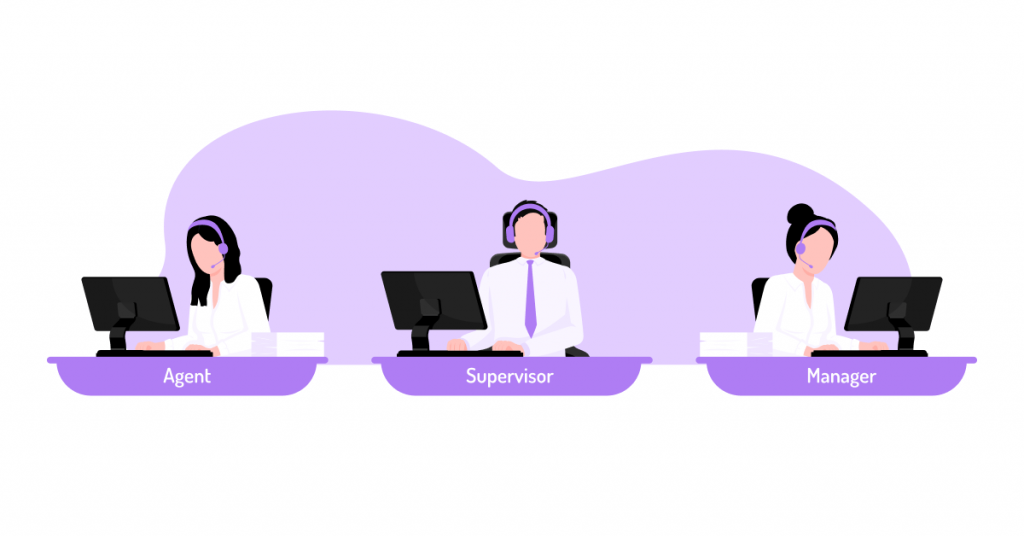
To run a successful call center, you need the right number of employees to handle inbound/ outbound calls and meet your performance goals. If you hire too few employees, your call center is going to be understaffed, resulting in long wait times for callers, an increased number of abandoned calls, and lower customer satisfaction scores. Hire too many – and agents are going to be underutilized, adding up to your overhead costs.
To estimate the number of required employees, you may need to take into account call volume, the average wait times and call handle times, the average number of missed/ abandoned calls, and other metrics and factors. You’ll also need to clearly define positions to be filled. While roles and titles may differ, the basic ones are:
- Call Center Agent: Call center agents are at the frontline of your call center, representing your business, directly communicating with prospects and customers, providing the necessary information, resolving requests, handling customer complaints, or selling your products or services. Agents report to supervisors.
- Call Center Supervisor: Supervisors are responsible for managing and supporting agents, arranging and providing training and call coaching sessions, measuring agent performance and ensuring they adhere to call center quality standards, giving regular feedback to agents, etc. Supervisors report to the call center manager.
- Call Center Manager : Call center managers set goals, performance expectations for agents and supervisors, and SLAs for a call center, plan and manage call center staffing levels (including recruitment, onboarding, and scheduling), conduct quality monitoring and call center Quality Assurance , analyze call center metrics and KPIs, etc. Managers report to the business owner.
- 7. Hire a Call Center Team
Call center jobs aren’t for everyone. Most of the time call center agents have to spend interacting with people (who may be frustrated or even abusive), answering their questions, helping them resolve issues, or selling products and services. When searching for, selecting, and interviewing potential candidates, hiring managers shouldn’t only focus on a person’s industry experience and familiarity with call center software systems and CRM tools. On top of that, it’s important to look for those who possess a variety of soft skills that are much-needed to succeed in the role, such as:
- Excellent communication skills: Along with active listening, clear verbal and written communication skills are fundamental for call center employees. Agents should be able to convey information in a clear and concise way that is easy for others to understand and act on.
- Empathy and emotional intelligence: An ability to demonstrate empathy and emotional intelligence when interacting with customers helps build rapport and trust with customers, which is why empathy and EI are vital skills to take into account when evaluating potential hires.
- Conflict-resolution: Challenging interactions and conflicts with dissatisfied customers or even colleagues are bound to happen. A candidate’s problem-solving and conflict-resolution skills and an ability to address customer complaints and de-escalate tense situations are a must-have.
- Ability to multitask: As agents may need to quickly switch between inbound and outbound calls or manage multiple communication channels (in the case of omnichannel contact centers), an ability to efficiently multitask and transition between various tasks is an essential skill to look for.
- Stress management: Agents would often need to work in high-pressure environments where they must handle challenging customer interactions, deal with irritated customers, and meet their performance metrics, making an ability to effectively manage job-related stress crucial.
- 8. Build Your Onboarding and Training Processes
In call centers, employee onboarding is often a lengthy and complicated process. But when done right, it results in many long-term benefits for call centers, such as improved engagement, increased agent efficiency, and reduced turnover rate. A Glassdoor survey found that organizations with a strong onboarding process are able to improve new hire productivity by over 70% and retention by 82%.
However, building a highly efficient call center team doesn’t end with proper onboarding. You should create a consistent process of ongoing learning through regular training and coaching initiatives. These are some of the examples of what your agent training materials, resources, and activities may include:
- A comprehensive internal knowledge base with FAQs
- Live or pre-recorded agent training webinars
- A library of successful customer interactions pulled from call recordings
- A library of scripts and canned responses for handling different types of calls
- Call-handling procedures, call flow, and call escalation protocols
- On-the-job training through live call whispering during customer interactions, etc.
- 9. Know How You Will Measure Call Center Performance
Based on your call center type (inbound/ outbound), your specific goals and objectives, and analytics capabilities of your call center software, you may track a different set of metrics and KPIs (Key Performance Indicators) that will allow you to measure the overall efficiency of your call center operations and performance of individual agents. These are some of the most common and most critical metrics and KPIs you may want to keep close tabs on:
The Average Handle Time (AHA): The Average Handle Time represents the average time it takes for an agent to handle a customer call, including hold time, talk time, and after-call work time. Along with other metrics, it’s a key indicator of how efficiently agents are able to handle customer inquiries. A high AHT may mean inefficient call routing or poor agent training.
The Average Speed of Answer (ASA): The Average Speed of Answer shows the average time callers have to wait in the queue before their call gets connected to an agent. A high ASA indicates that a call center may need to work on improving its operational efficiency and call management process, adjust staffing levels, or implement self-service options.
First Call Resolution (FCR): First Call Resolution Rate measures the percentage of customer issues resolved during the first interaction and shows how efficient your agents are in handling customer requests. A low FCR rate suggests that agents need more training or that they simply lack access to the necessary information and tools to resolve issues on the first call.
Call Abandonment Rate: Call Abandonment Rate is the percentage of calls terminated by customers before being connected to a customer support representative. A high abandonment rate is commonly caused by insufficient staffing levels, forcing callers to wait on hold for a considerably long time, poor call routing, and lack of callback options.
Customer Satisfaction (CSAT) Score: Customer Satisfaction (CSAT) Score measures the overall customer satisfaction with your product, service, or customer service and shows whether your call center is meeting customer expectations. A low CSAT score related to your service quality might mean that you need to work on improving your ASA, AHT, and FCR rates.
Conversion Rate: Conversion rate is an essential metric for sales-focused outbound call centers, which shows the percentage of outbound calls that resulted in a successful outcome (a closed deal, a booked appointment, etc.). A low conversion rate might be an indicator of low lead list quality or that the agents require more training.
Related article: Top 10 Outbound Call Center Metrics Your Call Center Should Measure
- 10. Build a Supportive Call Center Environment
Call centers are known to have traditionally high employee turnover rates due to the intense and stressful nature of the job, which is a huge problem for businesses. Not only is it because hiring, successfully onboarding, and training new agents takes time, much effort, and financial resources, but also because when agents leave – that may disrupt your call center operations and negatively impact the morale of the remaining team members. That is why it’s essential to build and consistently maintain a positive and supportive workplace environment within your call center. Here’s what you can do:
- Allow for flexible scheduling and remote work options to help agents achieve a better work-life balance.
- Maintain a psychologically safe environment where agents are encouraged to share their opinions and suggestions.
- Regularly provide and collect feedback from agents through one-on-one meetings.
- Hold team-building events in and out of the office to boost employee morale and engagement.
- Develop and implement an employee recognition program and reward top-performing agents.
Related article: How to Build an Efficient Call Center Environment to Drive Agent Performance
- Set up Your Omnichannel Contact Center with VoiceSpin
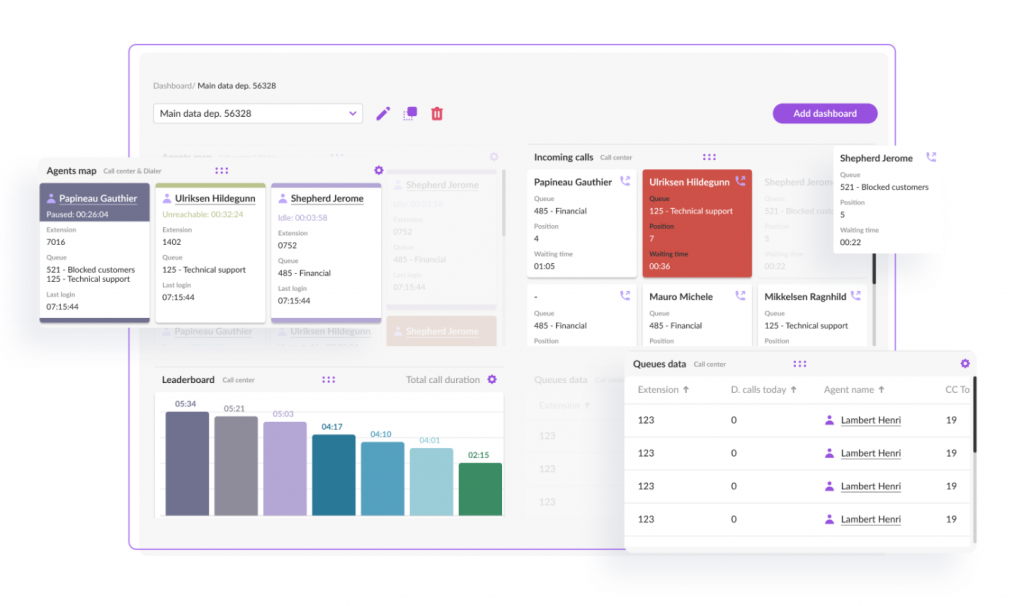
That all being said, why should you start your journey with VoiceSpin ? Whether you’re just looking to set up your call center from scratch or researching alternative options to upgrade your current call center tech stack, VoiceSpin’s AI-powered contact center solutions might be the right fit for both customer support and sales-oriented teams, empowering them with the tools they need to support clients across multiple communication channels or sell faster and more efficiently. What’s more, you can seamlessly integrate your contact center with your CRM or other business tools to keep all data in sync and enable your teams to be even more productive.
Book a demo call now to get a tailored walkthrough of the features and how to get started.
Want to Supercharge Your Sales Team?
All the call center features you would expect and much more. Integrations included!
Share this article:
You'll like it

Despite the rise of digital communication channels, there will always be businesses and organizations that…
April 7, 2023

There have been many excellent developments in communications that benefit businesses in a fashion we…
September 5, 2021

When customers call your business, how easily can they navigate through your IVR system? How…
April 14, 2023
Some text in the Modal..
Privacy Overview
Business Plan for Investors
- Bank/SBA Business Plan
- Operational/Strategic Planning Services
- L1 Visa Business Plan
- E1 Treaty Trader Visa Business Plan
- E2 Treaty Investor Visa Business Plan
- EB-1 Business Plan
- EB-2 NIW Business Plan
- EB-5 Business Plan
- Innovator Founder Visa Business Plan
- Start-Up Visa Business Plan
- Expansion Worker Visa Business Plan
- Manitoba MPNP Visa Business Plan
- Nova Scotia NSNP Visa Business Plan
- British Columbia BC PNP Visa Business Plan
- Self-Employed Visa Business Plan
- OINP Entrepreneur Stream Business Plan
- LMIA Owner Operator Business Plan
- ICT Work Permit Business Plan
- LMIA Mobility Program – C11 Entrepreneur Business Plan
- USMCA (ex-NAFTA) Business Plan
- Franchise Business Plan
- Landlord business plan
- Nonprofit Start-Up Business Plan
- USDA Business Plan
- Cannabis business plan
- Ecommerce business plan
- Online boutique business plan
- Mobile application business plan
- Daycare business plan
- Restaurant business plan
- Food delivery business plan
- Real estate business plan
- Business Continuity Plan
- Pitch Deck Consulting Services
- Financial Due Diligence Services
- ICO whitepaper
- ICO consulting services
- Confidential Information Memorandum
- Private Placement Memorandum
- Feasibility study
- Fractional CFO
- How it works
- Business Plan Examples
Call Center Business Plan Template
APR.13, 2018

Do you want to start call center business?
Are you thinking of opening a call center ? There is no doubt this is a great business venture with immense potential. In the recent years, the telemarketing industry has been experiencing a steady growth of between 6.5% and 8% per annum. The quest for organizations to improve their customer service in order to outshine their competitors has compelled many firms to outsource their telemarketing to experts. This is a cost effective approach compared to investing in an in-house call center. To succeed, a number of issues have to be taken care of but you can be assured to recover your capital within the first three years.
Executive Summary
2.1 the business.
The call center will be registered under the name ListeningU, and will be situated in downtown Brentwood, Los Angeles- California. The call center will be owned and managed by Adam Bruno who is an expert customer service professional.
2.2 Management Team
Adam Bruno is a Customer Service professional who has worked in the customer care industry for more than a decade. Before planning how to create a call center , Adam worked for many top business companies across the United States and is an accomplished customer service expert.
2.3 Customer Focus
ListeningU intends to offer clients a one stop, modern and fully equipped call center with the latest telemarketing technologies to serve the Los Angeles business community.
2.4 Business Target
ListeningU intends to offer both inbound and outbound call center business strategy services to a wide range of clientele keen on outsourcing their call center services.
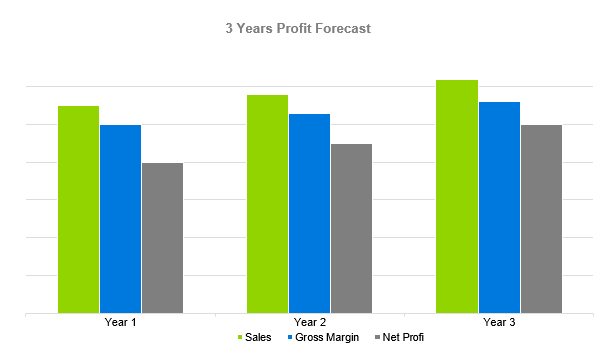
Company Summary
3.1 company owner.
Adam Bruno is a customer care professional who has worked with renowned U.S brands that include JPMorgan Chase, Goldman Sachs, Wells Fargo and Citigroup. In the course of his career, he ascended to the position of a Customer Service Manager and took the lead role in structuring call center operations and overseeing all management related aspects.
3.2 Aim of Starting the Business
After having been in the career for long, Adams noticed that companies were spending a lot of time and resources to manage in-house call centers. In order to help businesses focus on their core operations, Bruno found it necessary to start a call center business to handle telemarketing services on behalf of clients.
3.3 How the Business will be Started
As a customer service expert, Adams understands what he needs to start the call center. To set his idea into motion, he has worked closely with business set-up experts to develop a financial roadmap for the call center. The following is financial data for ListeningU Call Center.
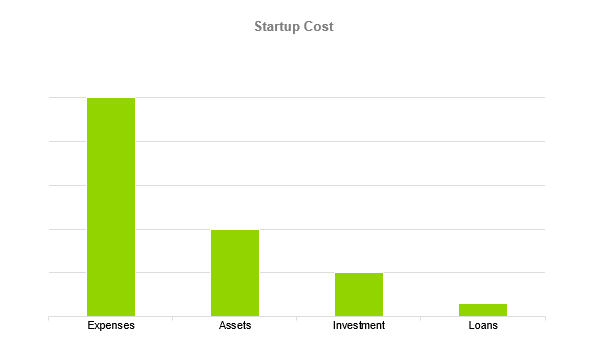
Services for Customers
ListeningU Call Center is focused on offering professional telemarketing services to different types of clients. When planning how to open a call center , the business is focused on offering the following services.
- Offer customer service that includes handling inquiries on behalf of clients
- Carry out Market research and surveys for clients
- Provide first-level help desk support
- Assist in business development by helping clients with lead generation, database management, debt collection and message services.
Marketing Analysis for Call Center Business
For ListeningU Call Center to meet its market obligations, a detailed market analysis was carried out to help the business establish itself in the industry and adequately serve the needs of clients.
This call center business plan explains the strategy the business will rely on to attain its goals. Given the rising demand for corporate call center services, there is a great opportunity for ListeningU to meet its market objectives.
5.1 Market Segmentation
Given the increasing popularity of the call center industry, ListeningU understands the value of coming up with sustainable marketing strategies to acquire a larger market share. Being the second largest city in the United States, Los Angeles is a business hub with many corporates looking for quality call center services to support their business operations. Based on market findings, the call center intends to target the following potential customers.

5.1.1 Corporate Organizations
Corporate organizations rely on an infrastructure that allows seamless communication to achieve various business objectives. For this reason, every corporate entity needs a robust and flexible call center service that has the capability to accommodate business needs. With high costs associated with setting up, running and maintaining call centers, businesses now prefer to outsource their needs to professional call center companies.
The corporate sphere is large and ListeningU Call Center intends to target companies in various sectors such as banking, manufacturing, telecommunication and information technology among others. Organizations have to keep communicating with their clients, suppliers, business partners and other industry stakeholders. The call center business model will focus on reaching out directly to various corporate entities.
5.1.2 Advertising and Marketing Agencies
One of the main services offered by ListeningU is marketing and lead generation. Call centers play a major role in advertising and brand awareness which attracts marketing agencies intending to roll out advertising campaigns for various products and services. Thanks to investing in sophisticated and cutting edge technologies, the call center has invested in the appropriate infrastructure to support large scale advertising.
5.1.3 Political Parties
Political parties have been identified as a potential customer group to reach out to in this call center business plan sample . Political parties often conduct fundraising and campaigns which need a professional call center facility to handle all communication aspects on behalf of a client. Political parties always run elaborate campaigns in order to create awareness and outshine their competitors. For this reason, ListeningU Call Center stands a great chance to benefit from political parties.
5.1.4 Religious Organizations
With many religious organizations operating in Los Angeles, the demand for call centers is high as religious establishments are always in need to call centers to support various organization functions. Just like political parties, religious organizations engage in numerous fundraising and campaigns.
5.2 Business Target
ListeningU Call Center is getting into a highly competitive environment considering there are numerous call centers in Los Angeles. However, this call center business plan template outlines the plan the business intends to use to acquire clients and propel business growth. It is costly to set up a fully functioning call center, but adequate strategies have been formulated to help the business fully recover its initial capital. After finalizing how to build a call center business and rolling out operations, the call center expects to recoup its initial investment in three years based on a projected 15-20% annual sales growth.
5.3 Product Pricing
While strategizing on how to start a call center business , Adam Bruno together with the assistance of experts has come up with a competitive pricing structure tailored for different services. At the beginning, the call center intends to offer various incentives to attract clients.
excellent work
excellent work, competent advice. Alex is very friendly, great communication. 100% I recommend CGS capital. Thank you so much for your hard work!
When planning how to start a call center , you need to come up with a great business development strategy . Adam Bruno has engaged experts to formulate a call center strategy that will be instrumental to steer business growth. The following is ListeningU Call Center sales strategy.
6.1 Competitive Analysis
ListeningU has deployed the latest telemarketing technologies to boost efficiency and seamlessly handle multiple clients without compromising quality. After completing the procedures of how to build a call center , the business anticipates high competition considering there are numerous similar establishments in Brentwood.
6.2 Sales Strategy
For ListeningU to achieve its intended targets and create a call center which is popular with clients, the following sales strategy will be implemented.
- Hire professional marketing agencies to help advertise the call center and teach out to corporate clients
- Organize an official opening party and welcome top industry stakeholders to create awareness about the business
- Do cold calling and email various potential customers to advertise call center services
- Advertise on digital media platforms such as Facebook, Twitter and Instagram
- Use local media channels such as Television and newspapers to advertise the business
6.3 Sales Forecast
ListeningU Call Center has put in place various sales strategies in order to meet its targets. The following is a forecast of sales for the business.
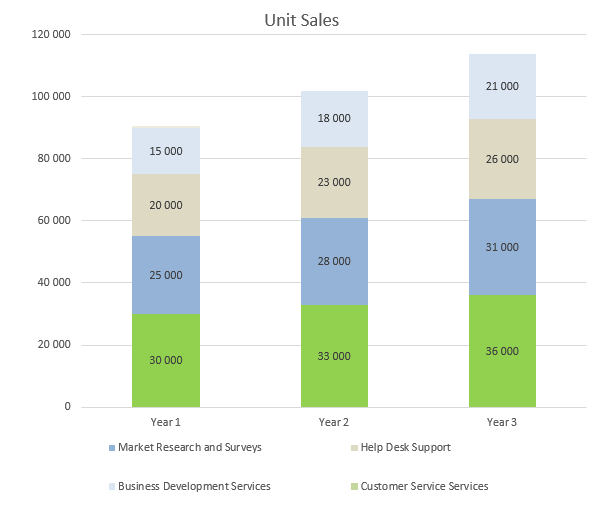
Personnel Plan
ListeningU provides diverse services in order to boost the company’s income. When starting a call center business , it is vital to focus on having a good personnel team to handle business operations.
7.1 Personnel Plan
The call center is owned by Adam Bruno who will be the overall center manager for the business. The call center intends to hire the following staff to enable the business carry out its operations.
- Call Center Manager
- Operations Manager
- Two Marketing Executives
- Five Customer Service Representatives
- Successful candidates will undergo intensive training to understand procedures and expectations.
7.2 Average Staff Salaries
ListeningU Call Center plans to pay its staff the following salaries in the first three years of operations.
Financial Plan
ListeningU Call Center has formulated a financial plan that will steer the path to business success. To start call center business , Adam will use his personal savings and funds from two investors. A loan will be sought to help raise startup capital for the business. Crucial financial information for the call center has been shown below.
8.1 Important Assumptions
Financial forecast for ListeningU Call Center will be based on the following assumptions.
8.2 Brake-even Analysis
ListeningU Brake-even Analysis is indicated in the graph below.

8.3 Projected Profit and Loss
Profit and Loss information for ListeningU calculated on a monthly and annual basis is shown below.
8.3.1 Monthly Profit
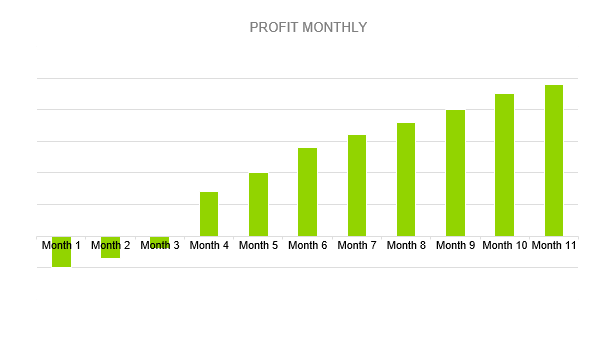
8.3.2 Yearly Profit
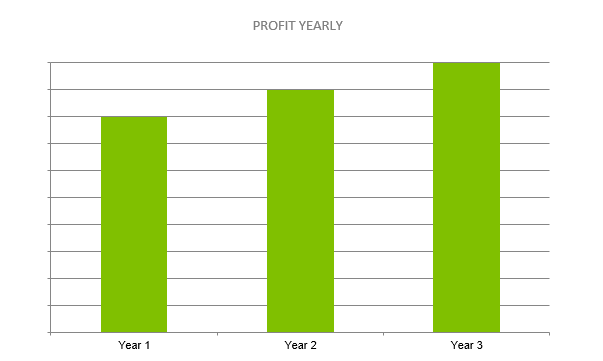
8.3.3 Monthly Gross Margin
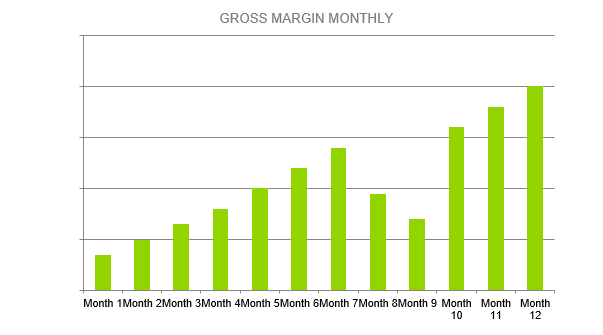
8.3.4 Yearly Gross Margin
Below is the profit and Loss Analysis for ListeningU Call Center.
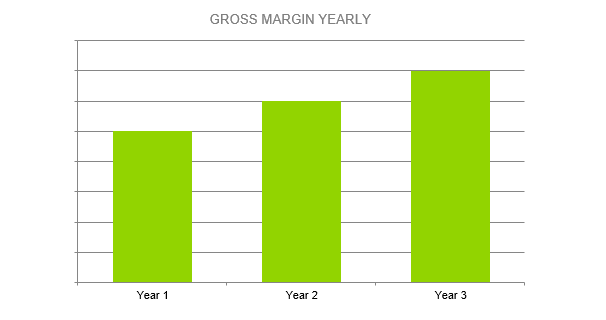
8.4 Projected Cash Flow
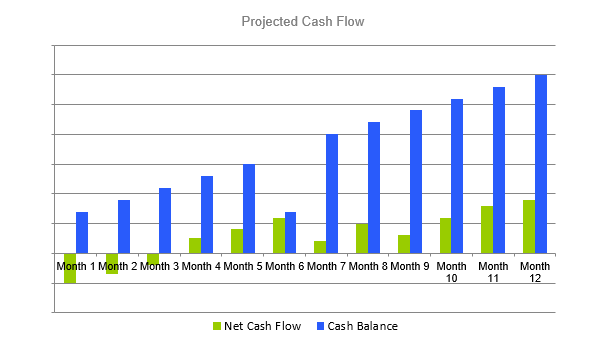
The diagram below is a summary of subtotal cash spent, subtotal cash from operations, subtotal cash spent on operations, subtotal cash received and pro forma cash flow.
8.5 Projected Balance Sheet
The following is a Projected Balance Sheet for ListeningU Call Center that shows capital, assets, long term assets, liabilities and current liabilities.
8.6 Business Ratios
ListeningU Call Center Business Ratios, Ratio Analysis and Business Net Worth are shown below.
Download Dog Walking Business Plan Sample in pdf
OGS capital professional writers specialized also in themes such as headhunter business plan, business plan for running staffing consultation and many others.
OGSCapital’s team has assisted thousands of entrepreneurs with top-rate business plan development, consultancy and analysis. They’ve helped thousands of SME owners secure more than $1.5 billion in funding, and they can do the same for you.

Add comment
E-mail is already registered on the site. Please use the Login form or enter another .
You entered an incorrect username or password
Comments (0)
mentioned in the press:
Search the site:
OGScapital website is not supported for your current browser. Please use:


Guide to Scaling Your Call Centre Business Model
- Ghadi Shamia --> By Replicant
- April 10, 2019
When your company is just beginning, it is difficult to imagine that you will have enough customers to need a call centre. As your company grows, if you do not project that potential growth, you are not going to be able to deliver the same level of service to your clients. Incrementally expanding your operations is vital to having long term stable growth of your company. Regardless of whether you are selling a product or a service, you are most likely going to have a website, social media presence, and some form of customer service support plan. Many companies have existing call centres where they have to plan for an effective call centre business model that adapts with their company’s ongoing expansion. Scaling your call centre business model is vital to your customer retention and satisfaction, which will end up driving your company’s success in the long-term.
What Does Scaling Your Call Centre Mean Exactly?
Due to advances in technology solutions, there are ways to maximize how your staffing operates in your call centre. Call centre staffing tends to have a high turnover because many of the shifts are in the evenings and weekends. The work also is very redundant for employees, which may make them want to change roles after periods as short as eight months or cause them to not deliver top customer service to your customers.
Scheduling is usually an absolute nightmare for employers where the quality of their customer service declines substantially due to inconsistency and lack of clearly communicated standard and protocols for customer service agents. Call centre employees regardless of how productive they may be can be quite expensive for companies across the board. For example, if a call centre that typically staffs 100 employees during normal business hours, keeps between four to five for the night shift, those employees may only get ten calls and be either sleeping or doing other activities while they are waiting. Scaling your call centre enables your company to have bots monitoring your call centre, which will provide a higher productivity rate and lower your cost for not having to pay employees to answer the low volume of calls that occur during off-peak hours. Scaling your call centre can also help during peak hours where you have too many incoming calls to provide perfect customer service to each and every customer.
Why Scaling Your Call Center is Important
Scaling your call center staffing model has many advantages for your organization. The first advantage is related to having efficient operational procedures in place. As your business grows in size, you will have an inundation of interactions with your existing customers and your new customers. Depending on your exact business model, you will have website chats, phone calls, and email messages. Particularly if your business operates in many parts of the world, these requests will be coming in quickly and at all hours. Depending on where your primary target market is and where your call centers are based, you will have to have a strategy in place to not only ensure that every form of correspondence gets answered, but also a disaster recovery plan in place in the event of too many issues or a system malfunction.
The important thing to remember is that having a delay in responding to your customers should be avoided at all costs, which is precisely why contingency plans for all potential situations must be in place.
When making your projections for your call center business model, you need to understand how many customers you have now, how many customers you will likely have in six months, and how many customers you will potentially have in the next year. From these calculations, you can then assess how many interactions you will likely have to engage in with your customer. Once you know the number of customers you are projecting over the next year, you then need to dig deeper into the customer’s life cycle to calculate a potential amount of interactions that customer will need to have with your company. A great example is a customer who buys a phone plan. The phone plan is great, then there is a billing issue, then there is a phone upgrade, then there is another billing issue, and the cycle continues. Understanding the full nature of your business model will help you to integrate that through process into anticipating what each and every customer’s life cycle will require in terms of high-quality customer service interactions with your company’s call center.
If you work with a third party to provide solutions for your call center, their network will have a larger bandwidth, which will protect your customer service response from having capacity issues. The ultimate issue you want to avoid is any downtime on your servers where you cannot provide quality customer service to your customers. Anticipating these potential threats will increase your level of customer satisfaction and likely maintain or extend their customer life cycle.
A positive problem to have is too many people calling your company. Ideally, these calls are for purchasing rather than troubleshooting; however, whatever kind of call they may be, you must not have long wait times on your communication interfaces, particularly phone call and online chat. If you scale your call center, you will be able to always know that you have the proper amount of staff to handle your influx of communication with your customers.
What Cost Benefits Will You Have from Scaling Your Call Center?
Depending on where your customer call center is located, you are going to have to pay a part or full time salary for each employee working there. Many times this can come with providing them benefits such as healthcare or paid vacation as well. Companies have begun to compare the cost of traditional call centers with those that are managed digitally by outsourcing or Artificial Intelligence. One example of a surprising statistic is that the average price of phone tickets on Airbnb was six times the cost of the live chat on the company’s website. The reason for this is the larger number of employees required to answer calls than required to answer chats and email messages.
When contemplating whether your current call center business model is working, it is best to see how many calls you need answered during normal business hours and during evenings and weekends. Upon calculating that financial cost, assess whether you should integrate automated options and whether after installation, those automated options will have a long-term profit gain for your company. Many times, this is absolutely true because automated services through using Artificial Intelligence can be custom programmed to your company’s demand to better use financial resources. The cost benefit aside, the automated programing can increase the quality of interactions with your customers, which is one of the most important metrics when measuring how loyal your customers are and whether they will start shopping elsewhere due to poor customer service and long wait times.
With Artificial Intelligence-related solutions, it is possible to scale your company’s call center to answer 5,000 calls at once during the day or at night. The key here is that a bot can wait at all hours to answer the phone and clients only pay for the time that the bot is on the phone, not waiting for the phone. What this means is that there is a substantial reduction in cost compared to paying an employee while they wait for calls.
Why Automation Increases Customer Satisfaction
Certain tasks in your call center can be completed automatically with bots. In your implementation strategy, consider which procedures can be automated . Your customers will have a more positive experience when you decide to automate the easier functions that don’t require a great deal of analytical thought. In fact, it may have a positive impact on your CSAT score , which is a fantastic measurement of customer satisfaction that can help your company drive sales and retain value metrics for overall improvement of company policies.
How Bots and Chat Bots Can Increase Your Call Center’s Productivity
Thinking Machines are relatively new to the market and they can be quite beneficial to call centers. Imagine while calling an airline when a flight has been cancelled and normally having to be transferred six times while spending roughly two hours on the phone. With Thinking Machines, it is possible for the bots to actually think and solve your issue without speaking to a live agent. While this sounds impossible, it actually is possible! Thinking Machines have an incredible contribution to make to companies that is just beginning because they can answer questions while solving actual problems and leave more complex tasks to a smaller team of agents, which will increase employee retention at call centers across the board.
How to Positively Impact Your Agent’s Job Satisfaction
At times, there can be a high turnover rate for staff that work in call centers. This is particularly true for call centers that work twenty-four hours per day, seven days per week. Business owners need to consider the number of customers employees are expected to serve and the repetition involved with the issues they are helping customers with. Companies need to also factor in the external factors in their employee’s lives that may make them unable to answer an upset customer politely with problem-solving solutions. The failure for companies to take these factors into consideration absolutely fuels the high turnover on customer call centers and the lack of personal investment and loyalty. By shifting the customer service model to include bots associated with Thinking Machines, company employees can feel a motivation to have more engaging assignments and a reduction of their current overextended workload.
As your company is expanding it is imperative to periodically review your customer service strategy and measure the satisfaction of your current customers. Customer retention should be interactions with your customer service call center will continue your company’s targeted expansion and growth with ease. Scaling your call center can be one of the best investments you will make for your company and you will see the benefits in decrease in call center staffing issues, large staffing costs that are avoidable, and customer retention issues arising from long wait times and poor customer service.
In order to scale your call center and to increase your customer satisfaction, employee retention, and lower your overall costs for your call center , let us show you how.

Related Blog Posts
Request a free call assessment, schedule a call with an expert.

Call Center Business Plan
- Description
- Executive Summary
- Products & Services
- Market Analysis
Marketing Plan
- Management Plan
Financial Plan
What you get with call center business plan package, i.- executive summary.
The growing need for outstanding customer service, sales, lead generation, appointment setting and after-sales support has increased drastically in the US, particularly industries such as e-commerce, technology, health, education, tourism and real estate. Further, traditional call center services fail to offer flexibility and scalability as businesses grow and operate in full capacity. Callsential recognizes this gap and is providing reliable and professional call center services that meets customer service needs and provides innovative technological options that make it scalable and economical.
Callsential is a professionally managed call center, delivering a wide range of services to small, medium, and large businesses, including customer service, sales, lead generation, appointment setting and after-sales. Our experienced team of professionals and state-of-the-art infrastructure allow us to provide high-quality solutions to our clients. We are committed to delivering the best possible customer experience, and offering customizable and competitively-priced solutions to meet the specific needs of our clients.
Target Market
At Callsential, our primary target market is businesses in the US who are looking for a reliable and professional call center service. We focus on industries such as e-commerce, technology, health, education, tourism, real estate and more, while providing customized services to meet each customer’s needs. Our clients range from small to medium-sized companies to larger enterprises. Our team of experts and robust technological infrastructure ensures quality call center services and innovative solutions that can help businesses maximize their sales and meet their customer service goals. Our competitive pricing and customizable options make us a strong contender in the market and we are committed to providing the best value for our customers.
Competition
Callsential is up against a competitive market, with other alternatives in the form of call centers are already present in the US. Those with similar offerings in terms of customer service, sales, lead generation, appointment setting and after-sales support include large firms as well as small and individual entities in the market. The competitive landscape is constantly shifting due to the ever-evolving technology and industry trends, and Callsential must remain competitive in order to stay ahead of the trending market.
Financial Summary
Callsential strives to be one of the most trusted and reliable call center services for businesses in the US. We believe that by balancing cost, service quality and customer satisfaction, we can establish a financially viable business model that will secure our financial success.
- We propose to keep our costs to a minimum while providing the highest level of customer service.
- Sales will be focused on providing a range of services to a wide range of industries including e-commerce, technology, health, education, tourism, real estate and more.
- Our services will be competitively priced, allowing us to generate long-term profits for the business.
- We plan to gradually increase our customer base by using innovative technologies and offering customized solutions for each customer.
- We anticipate achieving a competitive yield on our profits, mainly driven by low prices and our commitment to providing exceptional customer service.
- We anticipate that our success will come from an excellent service record and ensuring that our customers receive the best value for their money.
Funding Requirements
Callsential will require significant funding to pursue operations, ranging from capital investment for the setting up of a professional call center facility to cover operational costs related to staffs and advances in technology. Therefore, the following funding requests are outlined as below:
- Infrastructural Costs: This includes lease of the call center facility, purchase of computers and office equipment, fitting, and installation of phone lines, etc.
- Operational Expenses: These costs include salaries and wages of employees, services, charges, and other related expenditures.
- Research and Development: This includes investments in upgrading existing services, developing new ones, and overall technological advancements.
- Marketing & Advertising: These costs include investments in promotions, advertisements, and other marketing activities.
- Administration: This includes overhead costs such as accounting and legal fees.
Milestones and Traction
Callsential is well positioned to provide businesses in the US with reliable and professional call center services. We are a start-up that is in the preliminary stages of launch but have already made significant advancements towards our goal. Some of our key milestones include:
- Investment to build a robust infrastructure with the latest technological features
- Establishment of an experienced team of professionals and a streamlined customer service process
- Competitive pricing models and customizable service options
- Expanding our services to cover a variety of industries including e-commerce, technology, health, education, tourism, real estate and more
- Forming strategic partnerships with industry leaders to increase our reach and market share
Going forward, we plan to continue to expand our services and attract more customers through aggressive marketing campaigns and tailored solutions. We have created a roadmap of where we are currently and specific milestones we plan to hit in the near future.
II.- Products & Services
Businesses in the US are struggling to provide quality customer service due to rising demands for customer service, budgetary challenges and lack of talented personnel. These challenges have made it difficult to consistently deliver high-quality customer service and maximize efficiency in cost. The traditional call center models, while they have their merits, involve outdated telecom hardware and expensive staffing costs.
Callsential is the perfect solution for businesses looking for reliable and professional call center services. Our services are tailored to address these challenges and provide our customers with more flexibility and cost-effectiveness. With a dedicated team of professionals and advanced technological infrastructure, we ensure that your customers get the highest level of customer service.
At Callsential, we provide our customers with a reliable and professional call center solution. We offer a comprehensive range of services to help businesses in the US meet their customer service goals. Our services include customer support, sales, lead generation, appointment setting, and after-sales support. We understand the importance of customer service and have put together a team of experienced professionals and a robust technological infrastructure to ensure the highest quality of customer service.
We also offer competitive rates, customizable options, and are committed to continuing to bring innovative technology and services to best serve our customers. Our solutions address the challenge of businesses in leveraging customer data, improving customer satisfaction, and increasing sales. We strive to provide a seamless customer service experience, ensuring that our customers' needs are met.
Validation of Problem and Solution
Callsential's customer service, sales, lead generation, appointment setting, and after-sales support solutions have proven to provide a reliable and professional call center service for businesses in the US. Our innovative and cutting-edge solutions, plus an experienced team of professionals and a robust technological infrastructure, have resulted in a significant reduction in the amount of time customers spent on hold and the number of calls they had to make while experiencing increased satisfaction with the services they received. We have also been able to offer our clients lower costs, faster response times, and improved customer relationships.
Our solutions have also been tested and verified in various industries, including e-commerce, technology, health, education, tourism, and real estate. In 2019, our solutions were used by 8 different companies and resulted in an average satisfaction rate of 97%. In addition, our innovative technology has also enabled our clients to optimize their customer service process by removing the need for manual tasks and drastically reducing costs.
Callsential has many years of experience in providing successful solutions to businesses. We have a team of experienced professionals who are constantly in tune with the latest technological advances, thus enabling us to continue to bring innovative solutions to our clients.
Product Overview
Callsential provides a comprehensive and professional call center service for businesses across the United States. We offer a range of services that enable companies to provide the best customer service experience, improve sales, generate leads, set appointments and provide after-sales support. Our services are tailored to a variety of industries, including technology, health, education, real estate, e-commerce, tourism, and more.
Our team comprises of experienced professionals and our infrastructure is powered by reliable technologies and modern tools that enable us to deliver a high-level of service quality. We also offer flexible pricing plans and superior customer service, with the perfect balance between cost and value. Our commitment to our customers is to continue to provide innovative and progressive services.
Callsential is part of a crowded market for call center services. We are aware that competition stems from existing call center companies as well as new entrants in the market. Many businesses are looking for experienced, customer-centric call centers that can provide tailored services to suit their needs. We believe that we can differentiate ourselves in the marketplace with our experienced team, robust technological infrastructure, competitive rates, customizable options, and commitment to innovate our services.
Our competition offers a range of services, from basic customer service to complex outsourcing and IT solutions. In comparison, our core strengths lie in customer service, sales, lead generation, appointment setting, and after-sales support. We also have the resources and expertise to offer additional services as needed by our clients. Ultimately, we pride ourselves on our ability to offer a flexible, customer-driven service, with value-driven pricing.
At Callsential, we are committed to providing exceptional customer service, innovative technology, and competitive rates for all our customers. We have an established and experienced team, as well as a robust technological infrastructure that supports all our operations. We have already taken the following steps to ensure our success:
- We have conducted market analysis of the call center industry to ensure that all our services meet the needs of our customers.
- We have invested in the latest technology and have implemented systems that support the call centers operations.
- We have invested in recruitment of the most experienced and qualified professionals in the industry.
- We have established a strong customer base by providing quality services and reliable customer support.
Going forward, we plan to continue our commitment to innovation and customer service. We plan to expand our services to serve a wider range of industries, including e-commerce, technology, health, education, tourism, and real estate. We also plan to continue to develop our technological infrastructure to meet the ever-changing needs of our customers. Finally, we plan to continue to research and improve upon our services in order to provide the highest level of customer satisfaction.
III.- Market Analysis
Market segmentation.
Callsential serves customers within a range of industries, many of which have different requirements and expectations from their call center service. To better assess our target customer base, we have identified the following market segments:
- Real Estate
Each of these segments represents a potential group of customers that have specific characteristics in common. We will tailor our services and solutions to meet the needs of each market segment, and leverage our experienced staff, innovative technology, and competitive rates to ensure that we are meeting the requirements of each of our customers.
Target Market Segment Strategy
Our main target market is businesses of all sizes, ranging from small to large enterprises, who are looking for a reliable and experienced call center that can effectively meet their customer service and sales needs. We will tailor our services to meet the varying needs of each business, as well as creating customized packages for different market segments. Our ideal customer is one that seeks a collaborative approach to customer service, emphasizing customer satisfaction and loyalty. We will focus on providing exceptional customer service, ensuring that all customers’ requests are promptly addressed in a professional, efficient, and cost-effective manner.
Key Customers
Our ideal customer archetype for our call center business would be a company with a large base of operations and a need for professional customer service and technical support. We plan to provide our services to companies in a variety of sectors, including business-to-business, business-to-consumer, and government. Our services are tailored to meet the specific needs of each customer, ensuring the highest quality of service and customer satisfaction.
Our key customers will benefit from having a team of dedicated and certified customer service agents readily available to provide personalized support. Our team of skilled agents will be able to quickly and efficiently deal with customer queries and problems, ultimately allowing our customers to focus on their core business objectives.
Future Markets
From our Market Analysis, we have identified key trends in the industry and estimated the potential for our call center business in the near future. Our strategy focuses on leveraging our reputation to accelerate our market presence and to attract new customers. We will also use our industry expertise to identify new market opportunities and become one of the top centers in the call center industry.
We will focus on expanding our presence both locally and nationally, while simultaneously exploring opportunities in international markets. Our strategic initiatives will include promoting our services through various channels, such as search engine optimization and targeted digital campaigns, as well as leveraging existing partnerships and cultivating new ones. We will be open to new partnerships and collaborations that can help us achieve our goals.
We expect our call center business to become a leader in its field within the next few years. Our long-term vision is to become the industry leader in providing world-class customer experience and delivering innovative solutions. We will strive to use technology to drive our customer satisfaction and optimize our operations.
Callsential faces stiff competition from existing and potential entry into the US Call Center Service industry. Among the companies offering comparable services to Callsential are Outsource Call Solutions, Inc., CloudAssist, and Innovative Call Experts.
The following table contains information on our potential competitors:
IV.- Marketing and Sales Plan
At Callsential, we understand that proper marketing is an integral part of any successful business plan. Our marketing strategy is designed to generate brand awareness and drive customer acquisition through a combination of techniques including:
- Increased presence on digital channels with content and advertisement campaigns,
- Collaborations with influencers for social media reach,
- Product promotions and special offers, and
- Active participation in industry events.
We will also leverage our existing client base to capture larger market share by continuing to provide quality services at competitive rates.
A summary of our advertising and marketing related budget:
Our goal is to reach a minimum of 10,000 potential customers in the first year. Our innovative marketing strategies, combined expertise and technology will ensure that we reach our target market and achieve our goals.
Our sales plan projects an estimated number of sales based on market conditions, capacity, pricing strategy, and other factors. Some key components of our sales plan include understanding buying trends, leveraging technology to increase sales opportunities, and clearly articulating value propositions to clients. Additionally, our sales staff has deep experience in providing end-to-end support, tailoring solutions to customer needs, and building long-term relationships. We are confident that this will translate into successful sales.
Location and Facilities
Callsential's corporate headquarters is located in Austin, Texas. Our facilities offer the ideal environment to run a call center business. Our location provides easy access to a wide range of businesses in the US, and our competitive rates ensure that companies of all sizes can benefit from our services.
We have invested heavily in developing our technological infrastructure and providing a safe and secure work environment for our team of professionals. Our facilities feature data encryption and firewalls to ensure security of data. High performance systems and up-to-date software are used to ensure a smooth and efficient customer service experience. In addition, our facilities come with a reliable power supply, complete with backup generators, to prevent downtime and interruptions to service.
The cost of running our operations is kept low by taking advantage of local resources and utilizing the latest technologies. We are committed to providing our customers with cost-effective solutions that help them grow their businesses.
Our call center business plan recognizes that technology plays a critical role in our success. To ensure our success, we will invest in the latest technologies, such as cloud contact centers, AI-powered analytics tools, and custom CRM systems. Cloud contact centers enable our agents to access proprietary, company-level data remotely, and AI-powered analytics empower us to track customer interactions and trends.
Through modern CRM systems, our agents can maintain client data, provide custom support solutions, and access ever-changing customer needs. This streamlined workflow creates a better customer experience, increases sales and retention, and opens new opportunities for our business. Finally, we plan to utilize social media and other online platforms to improve our customer outreach.
Equipment and Tools
Before any call center business can start operations, there is a variety of equipment and tools to acquire. The necessary tools and associated costs to set up a call center depend on the call center’s type, size and the services provided, including but not limited to, telephone and internet systems, customer relationship management (CRM) software, and computer equipment.
The following table provides an outline of the required equipment and tools, as well as the estimated cost associated with purchasing or renting them:
It is important to note that there can be marginal variations in the cost of acquiring and renting required equipment and tools depending on the location of the business.
V.- Management and Organization
Organizational structure.
The proposed organizational structure within the call center is represented in the table below. It should be noted that the internal hierarchy within the call center will be fairly lean and nimble, allowing for quick deployment of staff to different areas and tasks as needed. At the top of the structure will be the General Manager, who will coordinate overall staff deployment and performance, and also report directly to the company owners regarding the call center's performance.
The proposed organizational structure was designed with a high emphasis placed on efficiency and rapid response times. By leveraging a flat, hierarchical structure, the call center will be well-positioned to quickly assign and deploy staff as needed and ensure customer inquiries are always addressed in a timely and efficient manner.
Management Team
We anticipate assembling a team of talented, experienced, and diverse industry professionals to serve in high-level management roles within our company. We have identified potential candidates for each position and the following table outlines their qualifications for the respective roles:
Management Team Gaps
At this stage, there are some essential areas of expertise and roles in our organization that we have yet to identify suitable candidates for. These gaps must be filled in order to allow the success of our call center business plan and to support our staff and operations.
The roles that are currently vacant include Customer Service Manager, Operations Manager, IT Manager and Human Resources Manager. We are also seeking financial consultants to ensure that our financial objectives and strategies remain on track.
We are confident that we will be able to find suitable candidates to fill these roles in the near future, and we have already taken steps to begin the recruitment process. We are committed to hiring the highest-caliber staff to ensure that our organization can realize its goals and objectives.
Personnel Plan
A personnel plan shall be established and put in place to ensure that the Call Center is managed effectively and all necessary positions are filled. A table is provided below, outlining the potential positions which will be required to successfully run the business.
Company History and Ownership
Callsential was founded in Austin, Texas in 2020, with the aim of becoming one of the most trusted and reliable call center service providers in the US. Our founders had substantial industry experience and a mission to provide our customers with an exceptional customer service experience. We have since grown to service multiple industries, and our commitment to innovation and technology has allowed us to achieve sustained and reliable market position.
Callsential is owned by a small board of founding members and senior management, who place strong emphasis on providing our customers with unparalleled quality service. We are continuously looking for ways to improve our services and make the call center experience more enjoyable and efficient.
Our call center business plan includes a detailed roadmap of specific goals and objectives that we plan to achieve in order to effectively manage and steer our business. This roadmap comprises of small, measurable goals that will help us move towards our long-term goals. We have formulated the roadmap with the help of identifying factors such as market size, projected revenue, customer acquisition and retention, resource availability and customer satisfaction.
We have carefully crafted this roadmap with the aims to launch our call center, acquire a minimum of 5,000 customers in the first year, deploy 100 service personnel and deliver quality customer service with customer satisfaction levels of over 90%. By following this roadmap, our business will be successful and well-managed.
Key Metrics
Key Performance Indicators (KPIs) are a set of quantifiable or measurable metrics used to analyze and evaluate the performance of a call center. These KPIs can help you gauge the overall performance and health of your business, identify areas needing improvement and make well-informed decisions. They can provide valuable insights into customer service levels, quality of customer service, time taken to handle customer queries, call abandonment rate, customer satisfaction, productivity of agents, and much more.
Monitoring and following up with key performance indicators enables you to focus on the areas that need improvement. As well as tracking average call length, hold time and repeat call rates, by regularly measuring the quality of customer interactions and customer feedback, seek to identify patterns in customer preferences and feedback. Ultimately, setting and tracking your KPIs can help you to develop more efficient and effective processes that satisfy customers, cut your costs and increase customer satisfaction.
VI.- Financial Plan and Metrics
Sales forecast.
Projected sales for the first three years of operation are presented in the table below. The sale yield for the first year is expected to be modest due to the fact that we are just getting started in the market and the fact that certain expenses including marketing budget, staff salaries and other investments will be incurred during the year.
We believe that our sales will grow steadily after the first year as we build our customer base and expand our services through marketing and networking. The figures in the table are projected based on our current market arguments, assumptions about future market conditions, and our growth strategy.
Call Center Financial Plan Key Inputs

The following tables outline the expected startup costs and operating expenses necessary to start and operate a call center business. The startup costs include one-time costs necessary to get the business off the ground, while operating expenses include the projected costs that can be expected to incur each month.
Startup Costs
Operating expenses.
This part of the business plan is where you present the three main financial documents of any startup: the income statement, the cash flow statement, and the balance sheet. In order to thoroughly analyze all sources of financial impact, these documents must show the expected revenue, expenses, net profits and cash flow markers for an estimated timeline. The financial plan should include assumptions and sensitivity analyses in order to account for unexpected changes or any risk factors. These documents can be used to measure the progress of the business, for unit cost comparisons, and for making decisions in new investments or budgeting.
Call Center Financial Plan Profit & Loss Statement
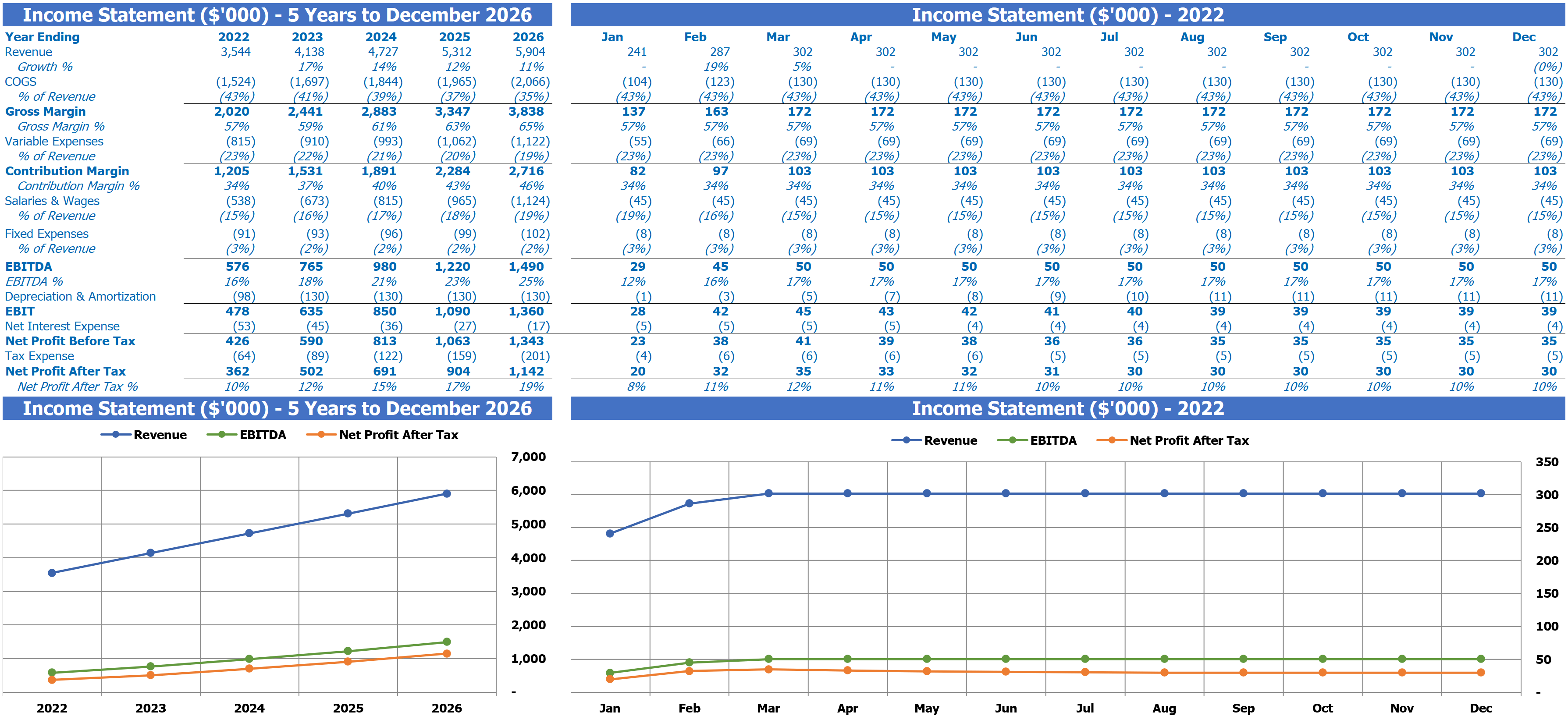
Call Center Financial Plan Cash Flow Statement

Call Center Financial Plan Balance Sheet Statement
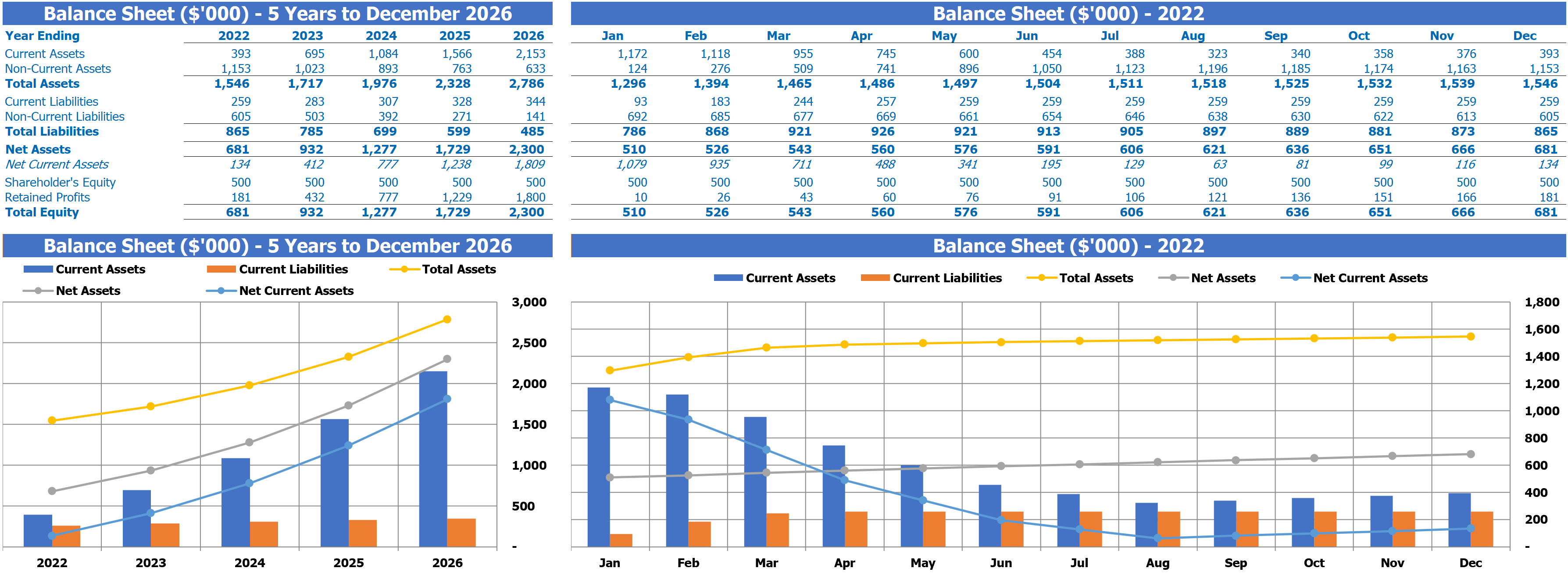
As the call center business expands, our personnel plan will need to change to ensure we are able to meet the demands of our growing customer base. Our personnel plan outlines how, who, and on what basis we intend to hire employees, as well as their position within the call center's business operations. Our overarching goal is to attract and retain a diverse and talented bunch of employees who are committed to providing customers with high-quality service.
We will hire based on qualifications and experience. Our compensation packages will reflect these requirements, with competitive salary and benefit programs for our employees. We will also focus on providing a fulfilling workplace atmosphere, with ample opportunities for growth and development.
Employees will be responsible for handling customer inquiries and providing support, as well as engaging in additional activities in the business operations. We will provide comprehensive training to ensure they are able to carry out their duties effectively and efficiently. We will also encourage their feedback and take into account their ideas and suggestions in our operations as much as possible.
Capital Requirements and Use of Funds
The capital requirements for the call center business plan should provide details on how much money needs to be raised, how the money will be used, and how much investment capital is being sought. This information is especially important when engaging with investors or potential lenders, as it allows them to identify the scope and scale of the business, as well as its future funding plans.
The capital requirements are typically used to cover ongoing operational expenses, buy necessary equipment and furniture, finance research and development, and, ideally, leave a reserve of funds for unforeseen needs. Investors and lenders will want to be reassured that the use of funds is in line with the call center's stated objectives and that sufficient contingency plans are in place.

Exit Strategy
The ultimate goal of our call center business plan is to create a profitable enterprise and an exit path for the purchase or sale of the business at some point in the future. The current management is committed to building and maintaining value through sensible financial management and judicious planning. The potential exit paths would include the sale of the business to a larger company, selling the business to a private investor, or passing the business onto family members or employees.
Customer Reviews
Outstanding


Call Center Business Plan
$59.00 $39.00 4 reviews
Resources On Call Center
- Financial Model
- Value Proposition
- One-Page Business Plan
- SWOT Analysis
- Business Model
Marketing Plan
- Bundle Business Plan & Fin Model
- Description
Executive Summary
Products & services, market analysis.
- Management Plan
- Financial Plan
Many small businesses and customer service representatives face the challenge of handling incoming calls efficiently, resulting in missed sales opportunities and dissatisfied customers. The limited resources available to them in terms of managing call volume, training staff, and processing payments can create significant obstacles to their success. Additionally, the high fees charged by traditional call center service providers make it difficult for them to afford such services.
CallHub aims to solve this problem by offering a pay-per-call model that is affordable and efficient for small businesses and customer service representatives. Our platform provides call center expertise, training materials, and payment processing capabilities to help businesses manage call volume, provide personalized customer service, and handle invoicing and payment processing, all within their budget. By filling this need in the market, CallHub can become a reliable and valuable solution provider for small businesses and customer service representatives in the United States.
CallHub plans to provide a pay-per-call model for businesses that struggle with handling high call volumes efficiently. Our call center solution will offer uninterrupted support to customers, ensuring that their queries are addressed promptly and professionally. With our team of experienced call center staff, we will deliver personalized customer service to create a seamless customer experience.
Our payment processing solution will be integrated into the call handling platform, which will allow businesses to handle all aspects of their customer calls in one place. This will help reduce operational costs and increase efficiency, enabling businesses to focus on their core competencies. Our value proposition will effectively solve the problem of mishandled calls, which can lead to lost sales and customer dissatisfaction.
Target Market
Our target market includes small businesses, customer service representatives, and call centers who are in need of a reliable and efficient call center solution at an affordable cost. With the increasing demand for better customer service, we aim to cater to the needs of these customer segments to handle incoming calls efficiently and maintain positive customer relationships.
Our market research shows that small businesses are often unable to afford full-time staff dedicated to handling customer calls, and call centers may not have the bandwidth to handle all the incoming calls efficiently. We aim to provide a cost-effective solution for their call center needs through our pay-per-call model.
Customer service representatives who work remotely or work from home will also benefit from our services as they will have a dedicated team to handle their calls ensuring that their customers are always satisfied with the service they receive.
Our target market is not limited to any particular industry as every business, whether big or small, requires a smooth communication channel to handle their customer grievances and inquiries. We are confident that our services will be well received by our target audience and that we will establish ourselves as a leading call center solution provider in the United States.
Competition
As with any business, CallHub will face competition in the call center industry. There are currently several alternatives and substitutes that businesses can choose from when it comes to managing their inbound calls. These include in-house call centers, outsourcing to offshore call centers, and utilizing virtual assistant services.
In-house call centers can be expensive to set up and maintain, requiring a significant investment in personnel, technology, and infrastructure. Offshore call centers may be cost-effective, but often lack the personal touch and quality of service that businesses require. Virtual assistant services may be more affordable, but may not be able to handle high call volumes or provide specialized call center expertise.
Despite these alternatives, CallHub believes that its pay-per-call model and focus on small businesses and customer service representatives will give it a competitive advantage in the market. By offering affordable and efficient call center solutions, CallHub aims to capture a significant share of the market and establish itself as a leading call center provider in the United States.
Financial Summary
The financial plan for CallHub is based on the pay-per-call model, and is outlined as follows:
- Call center staff salaries
- Operational costs for running the call center
- Platform maintenance and updates
- Marketing expenses
- Revenue will be generated by charging businesses a set rate for each call that is handled by our call center
- Target customers include small businesses, customer service representatives, and call centers
- Direct sales, referrals from business associations, and online marketing will serve as the channels for generating sales
Profitability
- The pay-per-call model is expected to be profitable due to its unique offering and value proposition
- CallHub aims to achieve a healthy profit margin with a focus on maintaining efficient cost management
- The comprehensive business plan will ensure a sustainable and profitable growth trajectory for the startup
Funding Requirements
CallHub requires a total investment of $1,000,000 to start operations. This will cover the following expenses:
- $300,000 for call center equipment and software
- $200,000 for salaries and training of call center staff
- $100,000 for marketing and promotional expenses
- $100,000 for office rental and utilities
- $200,000 for operational expenses such as payment processing and invoicing
- $100,000 for legal and administrative fees
We plan to distribute equity among our investors based on their total investment. In particular, we are offering 30% stake in the business for a total investment of $300,000 or more. We believe this will provide our investors with an attractive return on their investment, given the high demand for call center services in the United States.
Milestones and Traction
At CallHub, we are committed to achieving specific milestones that will help us establish ourselves as the leading call center solution provider in the United States. Our roadmap below outlines the progress we have made so far and the milestones we plan to hit.
We have already completed some crucial milestones such as extensive market research and company incorporation. Our next steps will be to develop our call center platform and implement our marketing and sales strategy. We are confident that by the first quarter of 2022, we will be able to onboard our first batch of clients and begin generating revenue.
Furthermore, we plan on expanding to new locations and acquiring key partnerships by the end of 2023. Through these initiatives, we believe we will be able to achieve our goal of establishing ourselves as a reliable and efficient call center solution provider in the United States.
Problem Worth Solving
The problem we aim to solve for our customer base is the inefficiency of managing high volume incoming calls. Small businesses and call centers often struggle to handle large call volumes, resulting in dissatisfied customers and lost business opportunities. Many businesses also lack the resources to hire and train additional staff to manage incoming calls effectively, leading to a negative impact on their customer service reputation. Furthermore, payment processing can also be a time-consuming and tedious task, diverting valuable resources away from revenue-generating activities.
CallHub's pay-per-call model offers an efficient and cost-effective solution to this pain point. By outsourcing their call handling needs to CallHub, businesses can focus on their core operations while ensuring a high standard of customer service. With our experienced call center staff and advanced technology platforms, we can handle high call volumes with ease and efficiency. Additionally, our invoicing and payment processing system makes the payment process hassle-free for our clients.
By offering a unique value proposition, CallHub aims to solve the problem of inefficient call handling for small businesses, customer service representatives, and call centers in the United States.
Our Solution
At CallHub, we understand that handling incoming calls efficiently can be quite the challenge for small businesses, customer service representatives, and call centers. That's why our solution is a pay-per-call model that allows businesses to access a reliable and affordable call center solution.
Our service allows businesses to focus on their core functions while we manage their call volume and provide excellent customer service. Our team of expertly trained call center staff handles incoming calls, provides personalized customer service, and ensures timely invoicing and payment receipts.
With our technology platforms for call handling and payment processing, businesses can access real-time actionable insights, performance metrics, and detailed reports that help them understand their customers better.
Our solution not only alleviates the problem of inefficient call handling but also reduces operational costs, thereby enabling our customers to invest in growth and expansion.
Overall, we believe our solution will provide value to our customer base and help them achieve their business goals.
Validation of Problem and Solution
Extensive market research and analysis have highlighted a significant problem faced by small businesses and customer service representatives in handling incoming calls efficiently. According to a survey conducted by Forbes, three out of four callers hang up when they reach a voicemail, which translates into a high rate of missed sales opportunities and dissatisfied customers.
Our solution, a pay-per-call model for businesses to handle incoming calls efficiently, has been tested in a pilot study involving a sample of small businesses. The results of the study showed that our call handling services led to a 20% increase in customer satisfaction and a 15% increase in new leads generated. Additionally, our invoicing and payment processing system streamlined the payment process for small businesses, resulting in a substantial reduction in payment delay and non-payment issues.
Based on these findings, we are confident that our pay-per-call model will offer a unique and valuable solution to our target customers. We believe that CallHub will emerge as a successful and profitable startup that caters to the needs of small business owners and customer service representatives in the United States.
Product Overview
CallHub is a call center startup that offers a unique and valuable service to businesses of all sizes. Our primary product is a pay-per-call model for businesses to handle incoming calls efficiently. We provide a team of well-trained call center staff who can manage large volumes of customer calls effectively.
Our service is best suited for small businesses, customer service representatives, and call centers that need to handle a high volume of customer calls. The pay-per-call model means that businesses only pay for the calls that are handled by our call center, which can help them reduce overhead costs.
Our service benefits customers in several ways. Firstly, businesses can focus on their core activities and leave the call handling to us. Secondly, our call center staff is trained to provide personalized customer service, which can lead to increased customer satisfaction. Finally, we offer timely invoicing and payment receipts, which can help businesses manage their finances effectively.
Overall, our product is designed to offer a reliable and efficient call center solution to businesses that need to handle a high volume of customer calls. With our pay-per-call model and well-trained call center staff, we aim to provide businesses with excellent customer service that can help them improve their bottom line.
There are other call center services that cater to various businesses in the market. However, their billing models are typically fixed monthly fees regardless of call volume, which may not be cost-effective for small businesses or call centers with fluctuating call volumes.
CallHub's unique pay-per-call model enables businesses of any size to only pay for the calls that are handled by our call center. This allows them to manage their expenses in a more predictable and cost-effective manner. In addition, our personalized customer service and efficient call handling guarantee a high level of satisfaction among our clientele.
Roadmap: Products & Services
At CallHub, we strive to provide our customers with a reliable and efficient call center solution. We plan on achieving this through the following steps:
By following this roadmap, we plan on establishing CallHub as a leading call center solution provider that offers reliable and affordable call handling services to our target customers. We believe that with the right support and resources, we can achieve our business goals and emerge as a successful and profitable startup in the years to come.
Market Segmentation
By targeting these segments, our pay-per-call model can provide efficient and cost-effective call handling solutions to businesses of all sizes, leading to a significant potential market and revenue potential.
Target Market Segment Strategy
Our ideal customer is a small business that receives a high volume of incoming calls, but does not have the resources to handle them efficiently. These businesses typically have a need for personalized customer service, but may lack the expertise or staff to meet those demands. We aim to offer a cost-effective solution for these businesses to outsource their call handling needs and streamline their customer service processes. By targeting small businesses, we believe we can make the most impact and bring the most value to this market segment.
Key Customers
Future markets.
Based on the customer segments and value proposition, the potential market for our pay-per-call model is vast, with potential for expansion into new industries and countries. As businesses continue to seek cost-effective solutions for handling customer service calls, our business strategy provides an efficient and affordable option. Our key partnerships with call center providers and small business associations also open up opportunities for expansion and partnerships in the future. With our focus on personalized customer service and timely invoicing and payment processing, we are confident in our ability to continue to grow and serve a diverse market in the future.
Below is a table of potential competitors in the pay-per-call call center industry:
While there are several competitors in the industry, our pay-per-call model provides a unique value proposition for small businesses looking to efficiently handle incoming calls without the high costs of hiring and training in-house staff.
Marketing and Sales Plan
Our marketing strategy aims to target small businesses and customer service representatives in need of call center support. Our advertising will be primarily online, including targeted social media ads, a Google Ads campaign, and listings in online business directories. We will also develop partnerships with small business associations to increase our reach through referrals.
The advertising budget will be initially set at $10,000 for the first six months, with a goal of achieving a 5% conversion rate and acquiring at least 20 new customers per month. As we establish a strong reputation and gain more clients through referrals, we plan to increase the budget and expand our advertising channels.
Based on market research, we anticipate a high demand for our pay-per-call model among small businesses, customer service representatives, and call centers. We estimate that in the first year of operation, we will handle approximately 100,000 calls per month, with an average charge of $2 per call. This will result in a revenue of approximately $200,000 per month and $2.4 million in annual revenue.
As our call center operation grows, we plan to expand our sales team to reach out to small businesses and customer service representatives directly, as well as form partnerships with small business associations to increase our client base. Our pricing strategy will remain competitive, offering affordable rates for businesses of all sizes. We will also offer volume discounts for businesses with a high call volume to incentivize long-term partnerships.
Another strategy we plan to utilize is online marketing through social media platforms and search engine optimization to reach businesses in need of call handling solutions. This will include targeted advertising to specific industry sectors and geographic locations where our services are most needed.
In terms of capacity, we plan to start with a staff of 30 call center representatives and expand our team as demand grows. Our focus will remain on providing excellent customer service and maintaining high call handling efficiency to build our reputation as a reliable call center solution provider.
Location and Facilities
CallHub's business model is based on leveraging cutting-edge technology to provide a unique and valuable service to our target customers. Our call handling platform will feature state-of-the-art communication hardware and software that will enable us to handle high call volumes with ease while providing efficient and personalized customer service to each caller.
Our payment processing system will be seamlessly integrated into our call handling platform, ensuring that businesses receive timely and accurate invoices for all calls handled by our call center. The platform will be designed to provide real-time reporting and analytics, allowing us to monitor call volume, customer satisfaction levels, and other key performance metrics that will help us optimize our services for our target customers.
Our technology platform will also feature advanced security and data encryption protocols to ensure that all customer information is protected against any unauthorized access or data breaches. We will also regularly update our technology to ensure that we are always at the cutting edge of call center technology and are able to provide our customers with the best possible service.
Equipment and Tools
As a call center business, we require certain equipment and tools to efficiently handle incoming calls and provide excellent customer service. Below is an outline of the required equipment and their associated costs:
Our call center business will make a one-time investment of $27,000 to purchase all the necessary equipment and tools. We will also consider renting certain equipment if necessary to reduce initial costs. We ensure that the equipment we purchase is of the highest quality to provide uninterrupted service to our clients and their customers.
Management and Organization
Organizational structure.
Our call center business will have a hierarchical structure with clear roles and responsibilities for each employee. The organization chart will be as follows:
We will maintain open lines of communication between different levels of the organization to ensure that everyone is on the same page and working towards the same goals. Our leadership team will meet regularly to discuss the company's performance and make plans for the future.
Management Team
As our call center business grows, we anticipate taking on a team of highly qualified and experienced professionals to lead our company. Below is a table of potential candidates we are considering for high-level management roles:
We are committed to building a strong and capable management team that will drive our company forward and ensure its success.
Management Team Gaps
As we move forward with our call center business plan, we have identified a few key management team gaps that we will need to fill in order to achieve our goals. While we have a strong team in place already, we are currently lacking candidates with specific areas of expertise, such as marketing and business development.
We plan to address these gaps by actively seeking out experienced professionals who can bring new perspectives and skills to our team. We believe that by investing in the right talent, we can position ourselves for long-term growth and success in the competitive call center market.
Personnel Plan:
Effective management and organization are crucial for the success of our call center business. We have identified the following potential positions that we expect to require:
Our personnel plan is designed to ensure that we have the right people in the right positions to provide efficient and effective handling of customer calls, personalized customer service, and timely invoicing and payment receipts.
Company History and Ownership
CallHub is a new startup that is dedicated to providing reliable and efficient call center solutions to businesses and customer service representatives across the United States. The founding team has several years of experience in the call center industry and has identified a gap in the market for a pay-per-call model that caters specifically to the needs of small businesses and call centers.
The company is owned by a group of experienced entrepreneurs who share a passion for customer service and a commitment to leveraging technology to improve the customer experience. The founding team has carefully researched the market, analyzed customer needs and preferences, and designed a business plan that is based on a proven and profitable call center model.
CallHub's business plan has been carefully crafted to ensure that the company is positioned for success from the very beginning. The team has identified key partners, developed strong industry connections, and invested in the resources necessary to deliver reliable and efficient call center services to customers throughout the United States.
As we move forward, the management team is committed to building a strong and profitable business that is dedicated to delivering high-quality customer service. We are confident that with the right support and resources, CallHub will emerge as a leader in the call center industry and a valuable partner to businesses of all sizes.
Management and organization of CallHub will prioritize achieving the following goals and objectives:
Regular progress updates and adjustments to the roadmap will be made as necessary to ensure the success of CallHub.
Key Metrics
As a call center business, it's essential to keep track of key performance indicators (KPIs) that help gauge the overall performance and health of the business. Some important KPIs to consider include:
- Number of calls handled per day/week/month
- Average length of calls
- Customer satisfaction rates
- Response time to calls
- Revenue generated per call or per customer
- Conversion rates (percentage of calls that result in sales or leads)
Tracking these metrics regularly can help identify areas that need improvement and ensure that the business is meeting its goals and objectives.
Financial Plan and Metrics
Sales forecast.
Our sales forecast is based on the projected demand for our pay-per-call model. We anticipate an increase in sales over the next three years as we establish ourselves as a reliable call center solution provider for small businesses and customer service representatives.
As we expand our key partnerships with call center providers, payment processors, and small business associations, we are confident that our revenue streams will continue to grow. Our cost structure will be closely monitored to ensure that we are maintaining profitability while providing affordable and efficient call center solutions to our customers.
Starting a call center business requires a significant investment in both startup and operational expenses. Below are the expected or incurred costs for starting and operating this business:
Startup Costs
Operational expenses.
These expenses indicate a significant initial investment in starting and operating a call center business. However, the pay-per-call model ensures a steady revenue stream that can cover these costs and generate a substantial profit for the business.
Projected Profit and Loss
CallHub's business plan projects a steady increase in revenue over the next three years (2023-2025). We anticipate earning $500,000 in revenue for 2023, $1,000,000 in 2024, and $2,000,000 in 2025.
Based on this projected profit and loss statement, CallHub is expected to become profitable within the first year of operation, with continued growth and increasing profitability in the following years.
Projected Cash Flow
As part of our financial plan and metrics, we have built a projected cash flow statement for the next three years (2023-2025). The table below shows the cash flow categories for inflow, outflow, net cash flow, and cumulative net cash flow, with columns for each year.
Our projected cash flow shows positive net inflow for the next three years. We anticipate growth in revenue as we increase our customer base and expand our operations. We plan to invest in technology platforms and training materials to boost our operational efficiency and reduce our cost structure. We believe that our pay-per-call model will generate profitable revenue streams, and with sound financial planning, CallHub will be a profitable and successful startup in the years to come.
Projected Balance Sheet
Below is a table showing the projected balance sheet for the next three years of the call center business:
The balance sheet shows a steady increase in assets, liabilities, and equity over the next three years. This is due to the steady growth of the business, as more and more small businesses and call centers come on board. The liabilities and equity also increase proportionally, indicating a healthy financial position for the business.
Personnel Plan
In order to run a successful call center, we need to have competent staff who are well-trained in handling customer calls. Our personnel plan involves hiring customer service representatives who have experience dealing with customers, as well as excellent communication skills. We will also hire a team leader who will oversee the call center staff and ensure the smooth running of operations.
The compensation for our customer service representatives will be competitive, with a base salary and a commission based on the number of calls they handle. The team leader will be paid a higher salary, as they will have more responsibilities in managing the call center staff.
Our employees will fit into our business operations by providing efficient and effective handling of customer calls, ensuring personalized customer service to meet the needs of each customer. They will also play an important role in invoicing and payment processing to help maintain our revenue streams. We will provide training materials to help our employees hone their skills and improve their performance, thereby contributing to the overall success of our business.
Use of Funds:
Below is a breakdown of how the funds will be utilized:
This table provides a clear overview of our planned use of funds. The majority of our resources will be utilized to cover staff salaries, with the remainder being used to maintain our technology platform, develop and execute marketing campaigns, and provide ongoing training and development for our staff.
Exit Strategy
As our call center business grows and becomes successful, we plan to explore different exit strategies. One possibility is acquisition, where we will seek out potential buyers who are interested in purchasing the business. Another option is selling the business to a family member or employee who has shown a strong interest and capability in taking over the business. Ultimately, our decision will be based on what is best for the company, its employees, and its customers.

$199.00 $119.00 Get Bundle
Customer Reviews
Awesome tool
Frequently Asked Questions

- Current item: Call Center Business Plan $59.00 $39.00
- Financial Projection Model, Financial Model, Financial Modeling For Startups, Startup Financial Analysis $49.00 $29.00

Call Center Business Model: How Does a Call Center Make Money

When starting a call center, one of the first decisions you need to make is what type of call center you want to operate. Each model has benefits and drawbacks. In addition, the model and services provided will determine how much money the center makes.
Pick the Call Center Business Model
Average call center revenues are between $5 million and $10 million annually. The size of the call center, however, does not determine how much money it can make. The type of business model adopted will have a big impact on profitability.
Call centers can make money differently, depending on their chosen business model. However, there are four most common models.
- Segmented Services
- Multi-Channel Blending
- Super Agents
- Skills-Based
Segmented Services Call Centers
Segmented services call centers offer a range of services to its clients, typically large businesses. These services can include customer service, order taking, and technical support. The call center charges its clients a monthly or annual fee for these services.
Multi-Channel Blending Call Centers
Multi-channel blending call centers handle customer inquiries from multiple channels, such as phone, email, chat, and social media. The call center then uses a technique called blending to route the inquiries to the most appropriate agent.
Super Agent Call Centers
Super agent call centers employ agents who are experts in a particular subject or industry. These agents have deep knowledge about the products and services they support. As a result, they are often able to resolve complex customer issues quickly and efficiently.
Skills-based Call Centers
Skills-based call centers assign agents to specific tasks based on their skills and experience. For example, an agent with sales experience may be assigned to upsell customers who are calling to cancel their service.
Incoming Calls vs. Outgoing
Call centers can also make money by handling both incoming and outgoing calls. Incoming calls are typically handled by customer service or technical support agents. Outgoing calls can be made by sales or telemarketing agents.
For example, a call center specializing in technical support may handle incoming calls from customers having problems with their computers. The call center would charge the customer a per-minute rate for the support services.
Pricing Strategies for Call Centers and Services
Call centers typically charge their clients a per-minute rate or a flat monthly fee. The per-minute rate is usually based on the number of agents required to handle the calls. The flat monthly fee is typically based on the volume of calls expected.
For example, a call center specializing in customer service may charge its clients a flat monthly fee for the services. The fee would be based on the number of customer service agents required to handle the calls.
Call Centers and Startup Costs
The startup costs for a call center can vary depending on the type of business model you choose. For example, a Super Agents call center may require you to hire experts with deep knowledge about your products and services. This can be costly. You can also expect to spend money on training your agents and setting up your call center infrastructure. The investment can set up your call center for a bigger payday.
Write a Business Plan
Once you’ve decided on the type of call center you want to operate, the next step is to write a business plan. This will help you establish your goals and objectives, as well as how you plan to achieve them.
By researching the market, you gain a better understanding of your call center’s profitability. You can also use your business plan to attract investors and secure funding for your call center.
Establish the Call Center Staffing Model
The staffing model for your call center depends on the type of business model you choose. It also determines how much money your call center can make. A Segmented Services call center may require a large team of customer service agents. A Super Agents call center may require a small team of experts.
Manage Ongoing Costs
Ongoing costs for a call center can include agent salaries, benefits, and training. They can also include the cost of technology, such as phone systems and cloud-based software. If you keep your expenses in mind, you can ensure that you manage your costs and optimize your profit.
By understanding how call centers make money, you can choose the business model that best suits your needs. Then, with a well-written business plan and the right staffing model, you can set your call center up for success.
Choose the Business Model
Now that you understand how call centers make money, it’s time to decide which business model is best for you. Then, you’ll have the information you need to determine how much your call center can make based on services provided and staffing.

Call Center Business Plan | Call Center Budget Template | Call Center Pro Forma | Call Center Financial Model
MAC & PC Compatible, Unlocked, NO VBA Macro
All In One - Pitch Deck, Dashboard and Guide
Immediate download after the payment
Description
DOWNLOAD A FREE DEMO
ALL IN ONE MEGA PACK INCLUDES:
Call Center Financial Model/Business Plan Excel Template
Pitch Deck Template For PowerPoint, Keynote & Google Slides
Business Plan Guide and Business Plan Template in MS Word Format
Financial Dashboard in Excel To Track Your Business Performance
Call Center Startup Budget Info
Designs a comprehensive 5-year financial model template for call centers that includes a projected income statement, financial statements, and financial ratios in either GAAP or IFRS formats. This financial model can be used to evaluate call center startup ideas, plan pre-launch expenses, and attract funding from banks, angels, grants, and VC funds. It covers all aspects of call center financial planning , ranging from cost structures, revenue models, financial metrics, forecasting, and management, to financial reporting and performance analysis. This model is fully editable, making it easy for call center owners to tailor it to their individual business needs and requirements.
The call center financial analysis is crucial to ensure profitability and sustainability for business operations. With call center budgeting and financial planning, financial projections for call centers can be made. The call center cost structure and call center revenue model can then be established, with a focus on call center financial metrics and KPIs. Call center financial forecasting and reporting can help with call center financial management and strategy, identifying areas of improvement in call center financial performance. Additionally, call center financial modeling can be utilized to generate startup costs spreadsheets, excel template cash flow statements, and sources and uses documents in GAAP/IFRS formats automatically.
This versatile call center Excel Financial Model, designed and developed by professionals, enables businesses to effectively analyze its financial projections, cost structure, revenue model, profitability, and financial performance. With features such as detailed monthly and yearly profit and loss statement templates and call center financial metrics, businesses can accurately plan, budget and forecast their finances. Additionally, our team has also designed a 3-year financial projection template, with unique and dynamic features that allow for estimations of NPV, cash inflow/outflow, and ratios to measure performance in detail. The non-complex design and structure of these templates make it easy to determine the ROI and achieve your business goals.
Call Center Financial Plan Reports
All in One Place

Business Financial Statements
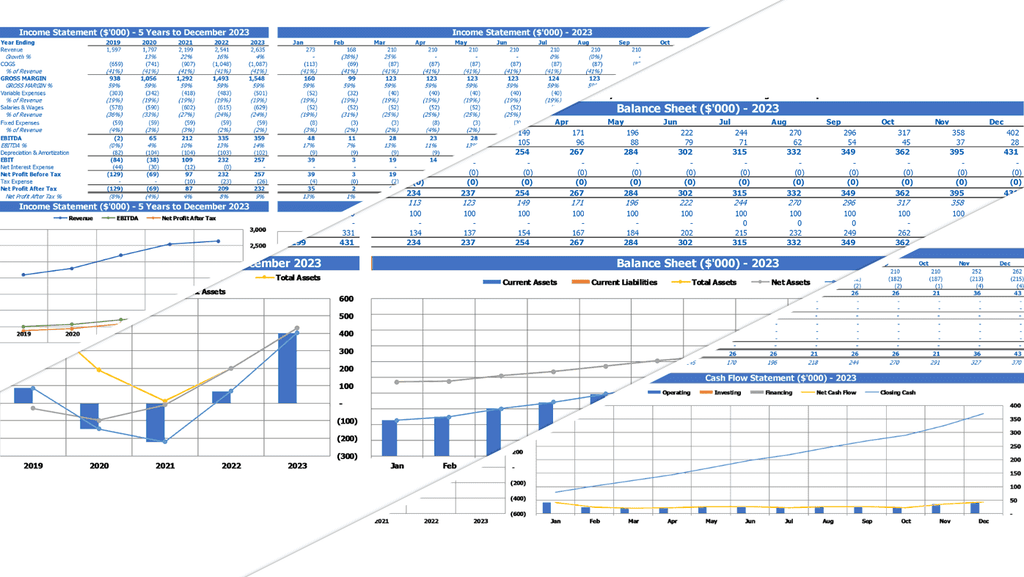
Use Of Funds
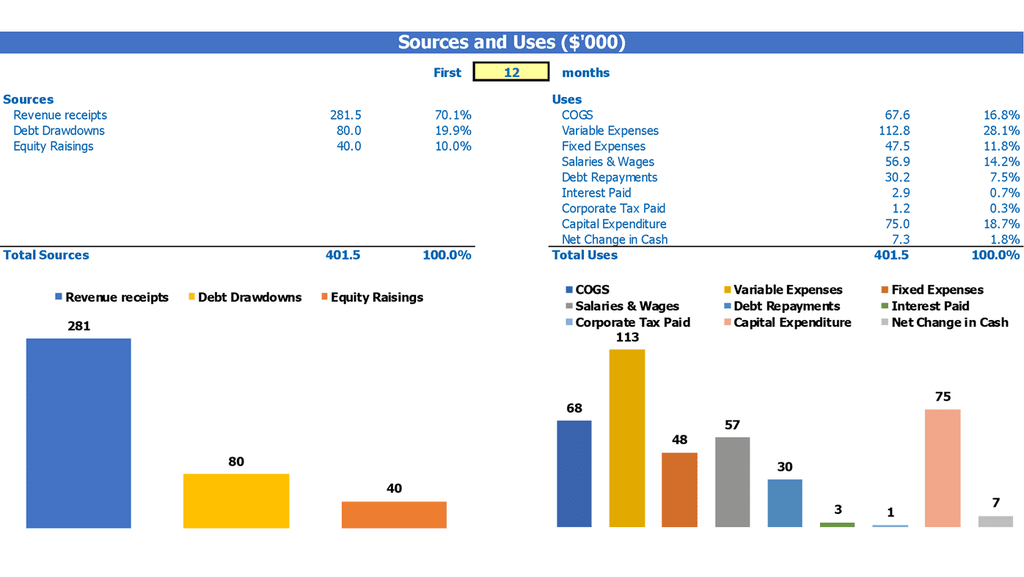
Break Even Point Calculation
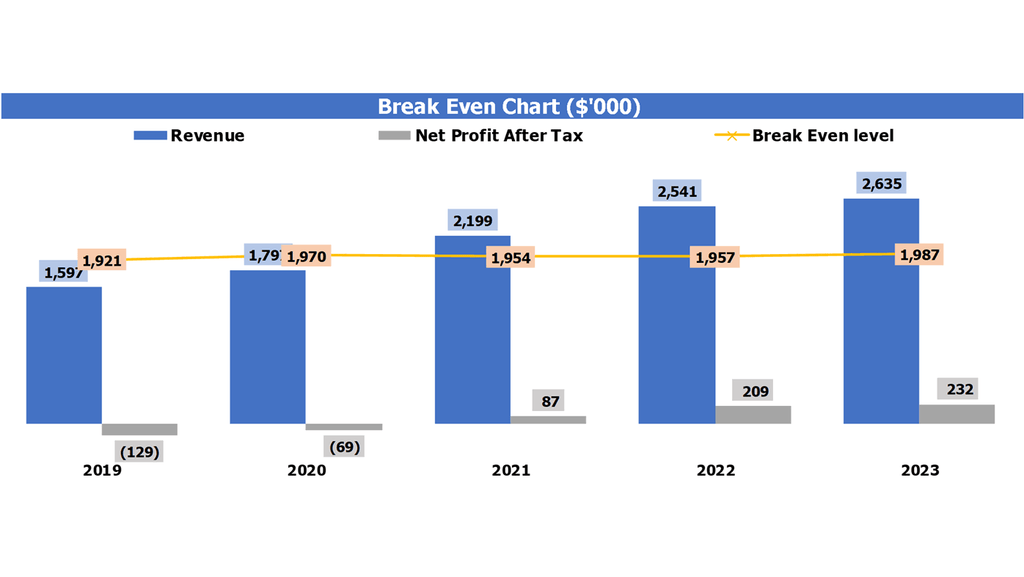
Top Revenue
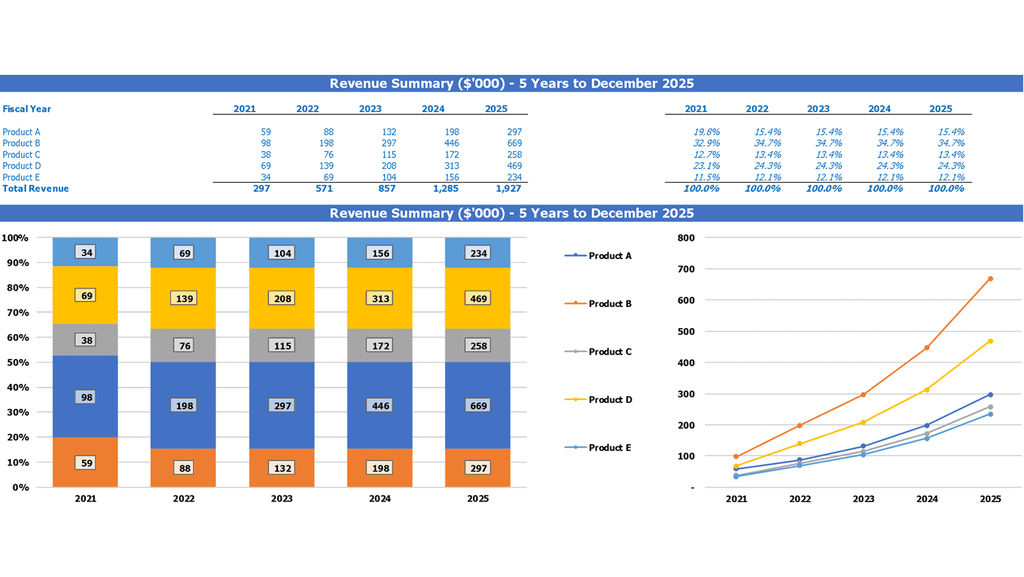
Business Top Expense Categories
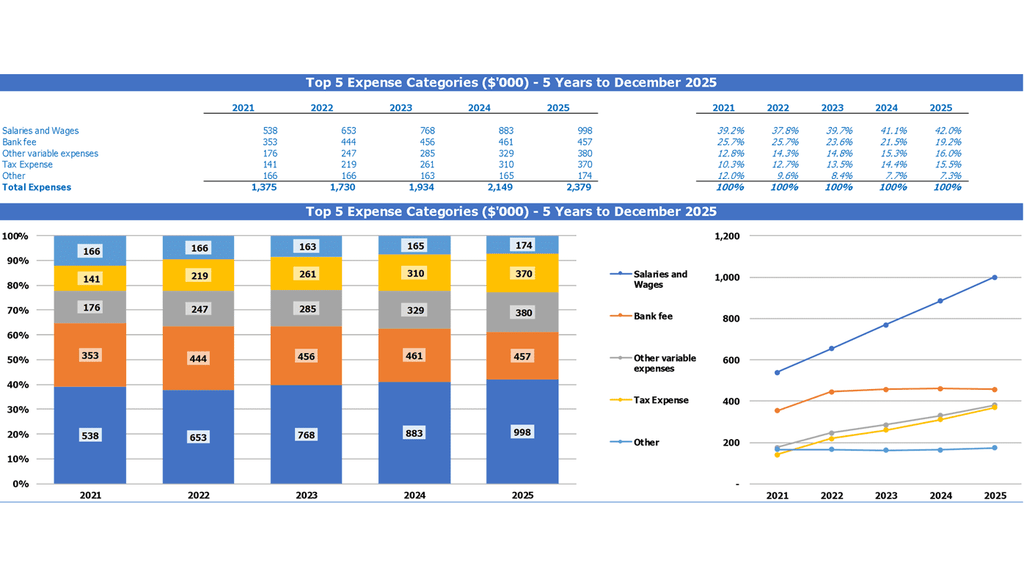
Call Center Financial Projection Expenses

Capital Budgeting Analysis

Loan Repayment Schedule

Call Center Income Statement Metrics
Financial KPIs

Excel Spreadsheet Cash Flow
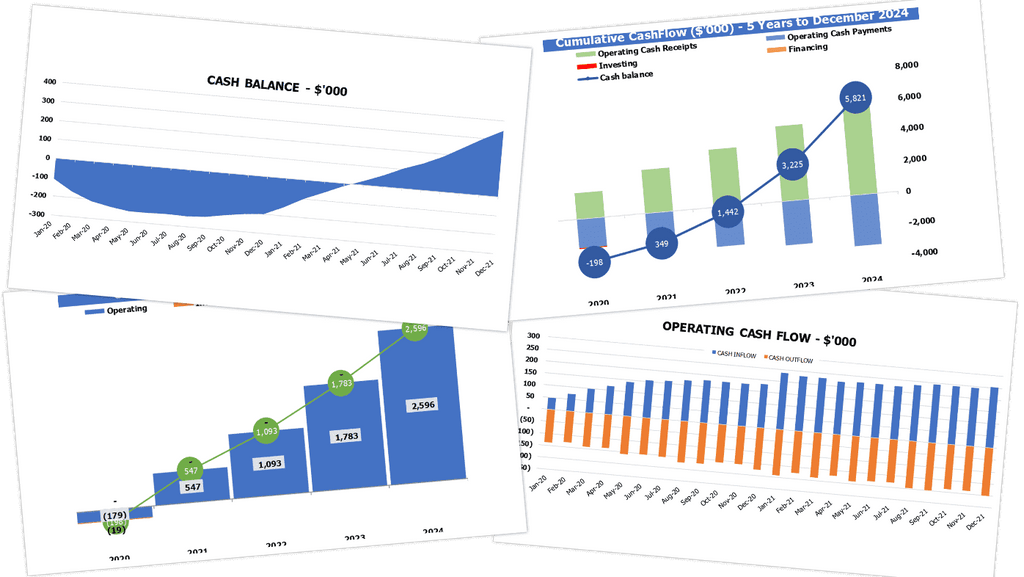
Industry Benchmarks

Profit And Loss Forecast

Projected Balance Sheet Template Excel

Call Center Income Statement Valuation
Seed Stage Valuation
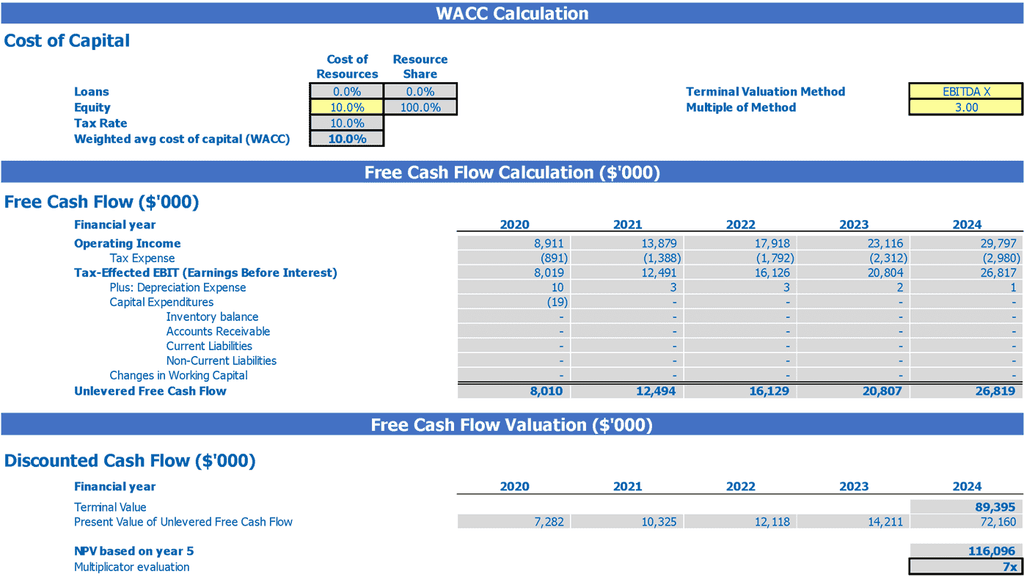
Call Center Business Plan Financial Template Key Features
Predict the Influence of Upcoming Changes
Utilize cash flow format in Excel for call center financial forecasting and modeling, including multiple 'what if' scenarios.
Save time and money
Maximize call center profits with comprehensive financial analysis, forecasting, and management using proven revenue models and KPIs.
Identify potential shortfalls in cash balances in advance
The call center financial plan is crucial for startup success, serving as an early warning system for cash flow.
Update anytime
Maximize call center profitability with customizable financial modeling tools.
Consistent formatting
Proper formatting and clear tabs aid in testing new hypotheses in call center financial models.
Call Center Simple Financial Projections Template Advantages
Detect payment issues with financial modeling excel templates.
Assess your financial metrics and use financial forecasting to create a successful call center revenue model.
Use our call center financial analysis tools to optimize your revenue model and plan your financial strategy.
Establish financial goals for your call center by utilizing various financial analysis tools such as budgeting, forecasting, and KPIs.
A comprehensive call center financial analysis can boost profitability and foster team alignment.
Customer Reviews
First-class
Outstanding
Real time saver!


Call Center Business Plan | Call Center Budget Template | Call Center Pro Forma | Call Center Financial Model
MAC & PC Compatible, Unlocked, NO VBA Macro
All In One - Pitch Deck, Dashboard and Guide
Immediate download after the payment
Description
DOWNLOAD A FREE DEMO
ALL IN ONE MEGA PACK - CONSIST OF:
Call Center Financial Model/Business Plan Excel Template
Pitch Deck Template For PowerPoint, Keynote & Google Slides
Business Plan Guide and Business Plan Template in MS Word Format
Financial Dashboard in Excel To Track Your Business Performance
CALL CENTER STARTUP BUDGET INFO
A sophisticated 5 year Call Center cash flow template needed, whatever size and stage of development your business is. Minimal previous financial planning experience and very basic knowledge of Excel is required: however, fully sufficient to get quick and reliable results. Consider using Call Center startup costs spreadsheet before buying the Call Center business. Unlocked - edit all.
This Call Center Excel 3 way financial model Call Center is built with the intention of opening Call Center. The models allow you to build out your initial investment based on a variety of factors that include Call Center, up to 5 years of projections, investor inputs, and project feasibility. The ambiguous nature of this simple financial projections template would allow for other types of Call Center to be analyzed. Users can change up to various types of products, adjust running expenses, and adjust startup costs/expansion costs on a per-unit basis to see your 5-year financial projection.
The Call Center startup financial model template prepared by our team includes a complete financial framework to make solid financial plans and projections. This profit loss projection consists of all relevant financial statements and performance metrics, which enable the user to make sound decisions by considering all operational and financial risk factors.
The Call Center Financial Plan For Business Plan is highly adaptable and dynamic for forming a 5-year monthly and yearly ( forecasted profit and loss statement , pro forma balance sheet for a startup business, and cash flow forecasting tools ) financial projection for a startup or existing Call Center. This model also consolidates a discounted cash flow valuation calculation by using the projected Free Cash Flows. The Call Center financial projections templates also calculates the main relevant financial performance ratios and KPIs required by banks and investors to estimate business profitability and liquidity.
One can easily edit our Call Center financial projection template with basic knowledge of excel and finance by adding information itself. All metrics will be updated automatically after made adjustments in the input sheet. Here you will find all the necessary financial and valuation reports, including cash flow projection , break even graph, Startup Cost plan, projected balance sheet for 5 years in excel format, and the pro forma profit and loss statement . A high-quality pro forma financial statements template excel for an Call Center makes it possible to foresee a profit for the future to come and enables the user to make wise decisions.
CALL CENTER FINANCIAL PLAN REPORTS
All in One Place
A business plan financial template is nothing but the income statement – cash flow statement- the balance sheet of the organization. The p&l template excel, by its very nature, is vast and holistic. A complete 3 year financial projection template is prepared to its fullest extent, only at the end of the accounting year. Thus, they account for and accommodate all the changes that have taken place in the year. No matter how huge or widespread the business of the organization. Every entity, without fail, must prepare a excel financial model template at the end of each year.

In this proforma business plan template, users will find a Dashboard with core financial metrics relevant to their business. This financial dashboard is a snapshot of all critical financial metrics at a particular point in time. In particular, on this dashboard, you will see your core financials, such as revenue breakdown by years, cash flow chart excel, profitability forecasts, and cumulative cash flows.

Company Financial Reporting
Our projected financial statements in excel format has a pre-built integrated financial summary that contains all the financial information from other spreadsheets, including the primary startup financial statement: balance sheet forecast, profit and loss statement format excel, and cash flow excel spreadsheet. Our specialists have already formatted this financial summary for your pitch deck.

Sources And Uses Of Funds
The business plan for determining sources and uses template of cash is a productive and reliable way to keep a company's financial activities under control. With its help you can develop both a large business and a startup. This is not only a clear indicator of the company's success for investors, but also a clear plan for development and increase of financial turnover. For many business owners, information is valuable data, thanks to which they dynamically promote their services on the market.

Cvp Chart Excel
Breakeven analysis is a tool used to determine when a business will be able to cover all its expenses and begin to make a profit. To calculate your break even point calculation, you will need to identify your fixed and variable costs. Fixed costs are expenses that do not vary with sales volumes, such as rent or administrative salaries. These costs have to be paid regardless of sales levels and are often referred to as overhead costs. Variable costs vary directly related to the sales volume, such as the costs of purchasing inventory, shipping, or manufacturing a product.

Top Revenue
In the Top revenue tab, you can create a demand report for your Call Center's products services. It will help you to assess the potential profitability and financial attractiveness of each scenario. In the cashflow projection, you can analyze the revenue depth and revenue bridge. With this report, you can forecast the demand level in different periods, such as weekdays and weekends. This forecast will help you better understand exactly when, for example, you need more resources and when less.

Small Business Top Expenses List
The company's expenses are located in the startup financial plan template, where you can also find the most significant expenses. They are divided into four categories, and the category 'other' has been added, which exists to enter additional data. Also, business plan template xls can help you with defining data in a historical perspective for up to 5 years.

CALL CENTER FINANCIAL PROJECTION EXPENSES
Initial or startup costs are the core Financial for any company; due to such importance, it is a vital part of the budget template excel. The startup cost is acquired at the start, maintaining the business with its circulation. The 3 year financial projection template excel plans this startup cost to any Financial losses. In our business plan financial projections template, you have a cost proforma that is specially designed for expense management and planning.

Capital Expense Budget
The capital expenditure budget is an important part of the financial projection templates. Businesses' use CAPEX expenses spending as part of their start-up budgeting process and to monitor investments. Understanding start-up expenses are necessary for the company. They are estimating expenditures on business plan cash flow template and influencing it. Having detailed CAPEX expenses spending is important for start-ups to have during budgeting and planning processes.

Loan Repayment Schedule
The loan amortization schedule template reflects the loan repayment schedules as per their terms. The loan amortization template in our business plan financial template is equipped with built-in formulas that keep a record of each loan, its terms, and repayments dates. It can handle all types of loans having monthly, quarterly or annual terms.

CALL CENTER INCOME STATEMENT METRICS
Profitability KPIs
Gross profit margin. A gross profit margin of the startup financial projections template is a frequently used financial ratio that is one of the main indicators of a company's financial health. It reflects the difference between the revenues and the cost of sales. When the gross profit margin is improving, it means that the company's expenses related to the sale of goods or services are decreasing and/or revenues from such sales are increasing. A gross profit margin is usually reflected as a percentage.

Cash Flow Budgeting And Forecasting
Today cash flow projection is considered a very powerful tool for financial management. cash flow statement excel template facilitates the correct implementation of money input and output.

Industry Benchmarks
Recording and monitoring indicators and data in an financial model is of key importance because the tabulation of these data is the basis of the comparison that constitutes benchmarking. The financial projection excel Benchmark Tab takes all the data from key indicators and finds the average value for each one. Then the relative value is obtained by doing a comparative analysis of each indicator. From this, companies can choose the best methods to achieve and maximize their targets and develop a growth strategy; thus, making these criteria very important, especially for start-up companies at the beginning of their journeys. Proper benchmarking can be leveraged into growth and positive results, as well as shape strategic management - making it very important for businesses to invest time in.

Pro Forma Profit And Loss Statement
The Monthly forecasted income statement sheet for the 3 year financial projection template is perfect for those who require regular reporting and details. Additionally, projected income statement template contains all revenue streamlines with gross earnings, net earnings linked with revenue analysis to ensure accurate reporting. We understand the goal of every Call Center is to make a profit, so they need a mechanism that helps the business owners to determine whether they are making profits or otherwise. Furthermore, the Yearly profit loss projection gives you complete insights into revenue and operating expenses. It also contains several graphs, assumptions, ratios, margins, net profit earning, cost of services, and profit after tax.

Projected Balance Sheet Template Excel
Monthly and Yearly pro forma balance sheet for a startup business included that is linked with cash flow model excel, p&l statement template excel, and other relevant inputs.

CALL CENTER INCOME STATEMENT VALUATION
Startup Valuation
To streamline valuation calculations, our startup valuation calculator excel spreadsheet organizes and collects the calculations of (1) the Weighted Average Cost of Capital (WACC), (2) Discounted Cash Flows (DCF), and (3) Free Cash Flows (FCF). (1) the Weighted Average Cost of Capital (WACC) is, as its name implies, the average cost that the company must pay to its security holders to finance its capital. It is dictated based on external market factors and the prevailing cost of equity and debt. The proportion of debt and equity in the company's financing is weighted accordingly. WACC is also a measure of risk assessment that banks evaluate before approving financing, as it shows the minimum return a company must earn on an existing asset base to break even for its creditors. (2) the Discounted Cash Flows (DCF) measures the value of future cash flows in the present, a very standard method of measuring the return on investments and opportunities.

Cap Table For Startups
The cashflow projection consist of a cap table is one of the essential spreadsheets for start-ups. It reflects the company's overall ownership structure and depicts who owns what, how much possesses, and at what value. A cap table model shows equity shares, preferred shares, options, and stakeholders' prices for such securities.

CALL CENTER BUSINESS PLAN FINANCIAL TEMPLATE KEY FEATURES
Get it Right the First Time
Funding is a binary event: either you succeed or you fail. If you fail, most investors won’t give you a second chance. Learn about the pros and cons with Call Center pro forma financial statements template excel.
We do the math
Pro Forma has all the required features ready with no formula writing, no formatting, no programming, no charting, and no expensive external consultants! Concentrate on the task of planning rather than programming.
Manage accounts receivable
By creating a cash flow chart template that takes invoices and bills into account, you'll be more easily able to identify who is systematically paying late. You could even go on to model different payment dates on overdue invoices to see the real effect of late payments on your cash flow.
Build your plan and pitch for funding
Impress bankers and investors with a proven, solid Call Center financial model that impresses every time.
Generate growth inspiration
By running various scenarios and looking at the effects they could have on your cash balance, you will begin to see which options are best for your business. Ones that are possible, and what is involved in making them work. Organic growth isn't the only option - there are growing funding options becoming available, and cash flow proforma could be a way of looking at the impact an injection of cash could have on your business and its growth plans.
CALL CENTER 5 YEAR FINANCIAL PROJECTION ADVANTAGES
5 Year Projection Plan Enables You To Project Forward How Much Cash You'Ll Have
Business Financial Model Template Estimates Incoming Cash For Next Periods
Build Call Center profit loss projection And Pitch For Funding
Identify Potential Shortfalls In Call Center Cash Balances
Choose One Of 161 Currencies For Settlements
Customer Reviews
First-class
Outstanding
Real time saver!


IMAGES
VIDEO
COMMENTS
Executive Summary. Introduction. It is the mission of Vashon Solicitation Services to provide clients with top quality call center services 24 hours-a-day. A service that provides our clients with the greatest chance of communicating with their end customers. We do B2B and B2C services including both inbound and outbound calls.
Call Center Business Plan. Over the past 20+ years, we have helped over 1,000 entrepreneurs and business owners create business plans to start and grow their call centers. On this page, we will first give you some background information with regards to the importance of business planning. We will then go through a call center business plan ...
Financial Highlights. TalkCentral is currently seeking $700,000 to launch. The funding will be dedicated to the office build out, equipment and supplies, overhead, marketing expenses, and working capital. The breakout of the funding is below: Office design/build: $250,000. Equipment, technology, and supplies: $100,000.
If you are planning to start a new call center business, the first thing you will need is a business plan. Use our sample call center business plan created using Upmetrics business plan software to start writing your business plan in no time.. Before you start writing your business plan for your new call center business, spend as much time as you can reading through some examples of services ...
A call center business plan is a formal written document describing your company's business strategy and feasibility. It documents the reasons you will be successful and your areas of competitive advantage, and it includes information about your team members. Your business plan is a critical document that will convince investors and lenders ...
A call centre business plan is a high-level document that is the [&hellip. ... to create a contact centre within your own organization - whether that's for service, sales or both - your call center business model will be aimed at internal stakeholders. However, if you're looking to create a new outsourced contact centre, your business ...
10.1 Financial Assumptions: Transform your business objectives into a strategic plan that will improve your call center business's bottom line with the help of professional services. 10.2 Revenue Model and Sales Forecast: Determine how to monetize your call center business and strategize how it can expand.
The first section your reader should see is the executive summary. This acts as an introduction to the document and lays out a guide to your business plan as a whole. For this reason, you'll write this section last once you have the rest in place. It should include some background to your industry, the kind of BPO call center you are planning ...
When writing the strategy section of your call center's business plan, you should include key elements that will demonstrate to a bank or an investor that you have thought through your pricing strategy, sales and marketing strategy, and key milestones needed for success. Your pricing strategy should be tailored specifically to the target market ...
The call center industry is experiencing rapid growth, with an estimated market size of $496.4 billion in 2021. This is expected to continue climbing at a compound annual growth rate of 7.9% from 2021 to 2028. These statistics highlight the immense potential and profitability of starting a call center business.
A business plan has 2 main parts: a financial forecast outlining the funding requirements of your call center and the expected growth, profits and cash flows for the next 3 to 5 years; and a written part which gives the reader the information needed to decide if they believe the forecast is achievable.
1. Set Your Call Center Goals. Just like with any other business, building a call center requires careful planning. Before you actually start setting up your own call center, have a clear understanding of wh y you want to start a call center and outline the goals you are looking to achieve.
The call center business model will focus on reaching out directly to various corporate entities. 5.1.2 Advertising and Marketing Agencies. ... However, this call center business plan template outlines the plan the business intends to use to acquire clients and propel business growth. It is costly to set up a fully functioning call center, but ...
Why Scaling Your Call Center is Important. Scaling your call center staffing model has many advantages for your organization. The first advantage is related to having efficient operational procedures in place. As your business grows in size, you will have an inundation of interactions with your existing customers and your new customers.
This easy-to-follow template includes clear instructions, helpful definitions, and an actionable timeline to help you plan, implement, and monitor your call center performance. By utilizing this template, business owners will have the opportunity to develop a long-term, successful call center business plan that they can update as needed over time.
Below is the sales projection for Cosmos Call Center Agency, LLC, it is based on the location of our business and other factors as it relates to telemarketing and call centers agency start - ups in the United States; First Fiscal Year-: $350,000. Second Fiscal Year-: $700,000. Third Fiscal Year-: $1.5M.
Create a winning call center business plan with our expert-crafted template. Craft your success story today. Financial Models. Business Plans. Tools. Pitch Decks; Blog. More. 0. Home. Call Center Business Plan. $59.00 $39.00 ... With our pay-per-call model and well-trained call center staff, we aim to provide businesses with excellent customer ...
Pick the Call Center Business Model. Average call center revenues are between $5 million and $10 million annually. The size of the call center, however, does not determine how much money it can make. The type of business model adopted will have a big impact on profitability. Call centers can make money differently, depending on their chosen ...
The business plan should also provide the organizational and financial reasons for choosing to set up the call center. 3.1 Setting the Objective. Before deciding on the infrastructure, enablers, technology, and staff needed for the call center, it is essential to lay down the business objectives of the call center.
Call Center Business Plan | Call Center Budget Template | Call Center Pro Forma | Call Center Financial Model. 5 reviews. $129.00. BUY NOW. MAC & PC Compatible, Unlocked, NO VBA Macro. All In One - Pitch Deck, Dashboard and Guide. Immediate download after the payment.
Below are call center management best practices and tips to help you improve your call center operations or start one on the right foot. 1. Hire the Best Employees and Train Them. Ensure that you ...
The Call Center Financial Plan For Business Plan is highly adaptable and dynamic for forming a 5-year monthly and yearly (forecasted profit and loss statement, pro forma balance sheet for a startup business, and cash flow forecasting tools) financial projection for a startup or existing Call Center. This model also consolidates a discounted ...